Roland KR107 ELECTRONIC PIANO WITH USB PORT User Manual KR 107 e
Roland Corporation ELECTRONIC PIANO WITH USB PORT KR 107 e
Roland >
Contents
- 1. USERS MANUAL 1
- 2. USERS MANUAL 2
- 3. USERS MANUAL 3
USERS MANUAL 1
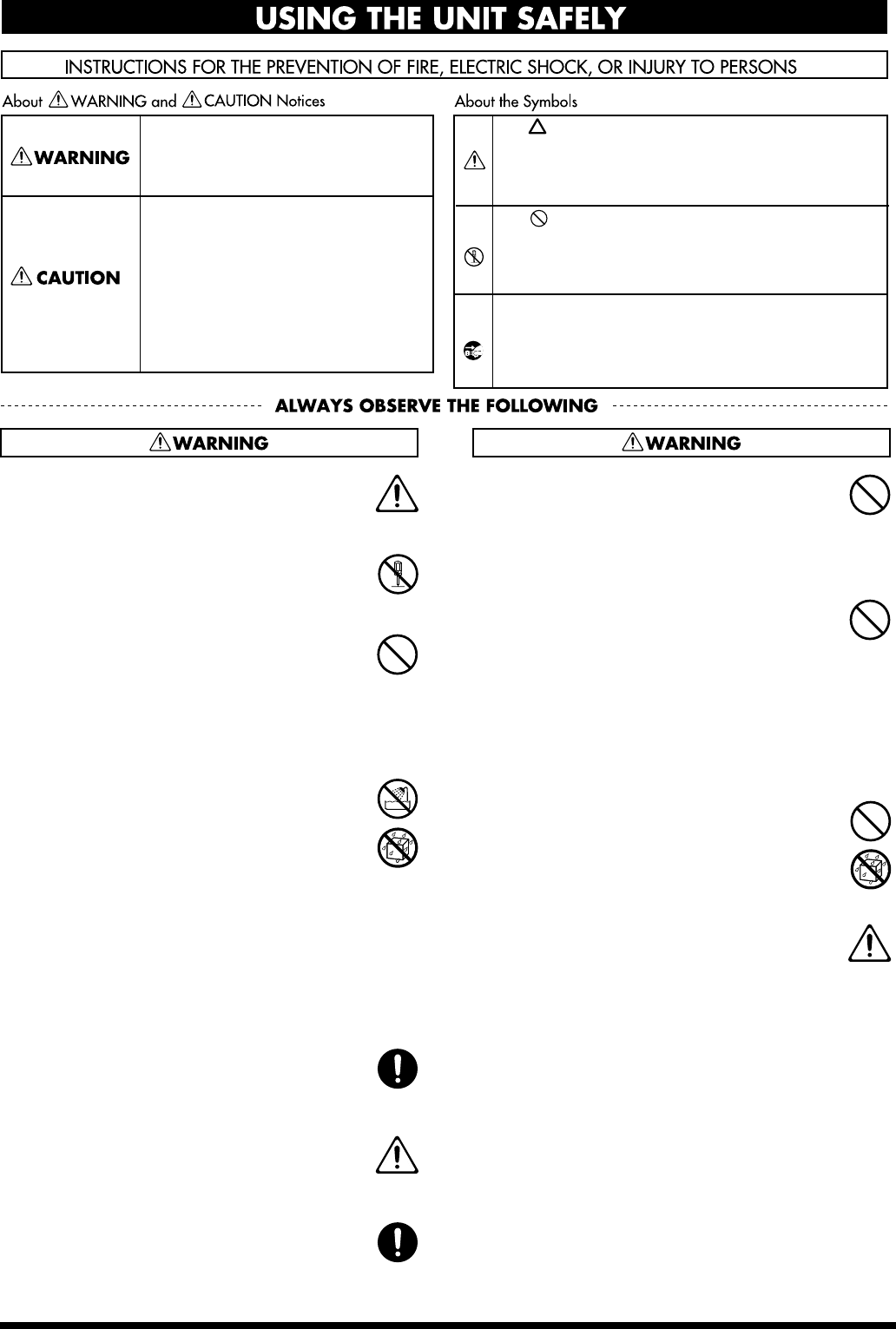
3
USING THE UNIT SAFELY
001
• Before using this unit, make sure to read the
instructions below, and the Owner’s Manual.
..........................................................................................................
002a
• Do not open or perform any internal modifica-
tions on the unit.
..........................................................................................................
003
• Do not attempt to repair the unit, or replace parts
within it (except when this manual provides
specific instructions directing you to do so). Refer
all servicing to your retailer, the nearest Roland
Service Center, or an authorized Roland
distributor, as listed on the “Information” page.
..........................................................................................................
004
• Never use or store the unit in places that are:
• Subject to temperature extremes (e.g., direct
sunlight in an enclosed vehicle, near a heating
duct, on top of heat-generating equipment); or
are
• Damp (e.g., baths, washrooms, on wet floors);
or are
• Humid; or are
• Exposed to rain; or are
• Dusty; or are
• Subject to high levels of vibration.
..........................................................................................................
007
• Make sure you always have the unit placed so it is
level and sure to remain stable. Never place it on
stands that could wobble, or on inclined surfaces.
..........................................................................................................
008a
• The unit should be connected to a power supply
only of the type described in the operating
instructions, or as marked on the rear of unit.
..........................................................................................................
008e
• Use only the attached power-supply cord. Also,
the supplied power cord must not be used with
any other device.
..........................................................................................................
009
• Do not excessively twist or bend the power cord,
nor place heavy objects on it. Doing so can
damage the cord, producing severed elements
and short circuits. Damaged cords are fire and
shock hazards!
..........................................................................................................
010
• This unit, either alone or in combination with an
amplifier and headphones or speakers, may be
capable of producing sound levels that could
cause permanent hearing loss. Do not operate for
a long period of time at a high volume level, or at
a level that is uncomfortable. If you experience
any hearing loss or ringing in the ears, you should
immediately stop using the unit, and consult an
audiologist.
..........................................................................................................
011
• Do not allow any objects (e.g., flammable
material, coins, pins); or liquids of any kind
(water, soft drinks, etc.) to penetrate the unit.
..........................................................................................................
012a
• Immediately turn the power off, remove the
power cord from the outlet, and request servicing
by your retailer, the nearest Roland Service
Center, or an authorized Roland distributor, as
listed on the “Information” page when:
• The power-supply cord, or the plug has been
damaged; or
• If smoke or unusual odor occurs
• Objects have fallen into, or liquid has been
spilled onto the unit; or
• The unit has been exposed to rain (or otherwise
has become wet); or
• The unit does not appear to operate normally
or exhibits a marked change in performance.
..........................................................................................................
Used for instructions intended to alert
the user to the risk of injury or material
damage should the unit be used
improperly.
* Material damage refers to damage or
other adverse effects caused with
respect to the home and all its
furnishings, as well to domestic
animals or pets.
Used for instructions intended to alert
the user to the risk of death or severe
injury should the unit be used
improperly.
The ● symbol alerts the user to things that must be
carried out. The specific thing that must be done is
indicated by the design contained within the circle. In
the case of the symbol at left, it means that the power-
cord plug must be unplugged from the outlet.
The symbol alerts the user to important instructions
or warnings.The specific meaning of the symbol is
determined by the design contained within the
triangle. In the case of the symbol at left, it is used for
general cautions, warnings, or alerts to danger.
The symbol alerts the user to items that must never
be carried out (are forbidden). The specific thing that
must not be done is indicated by the design contained
within the circle. In the case of the symbol at left, it
means that the unit must never be disassembled.
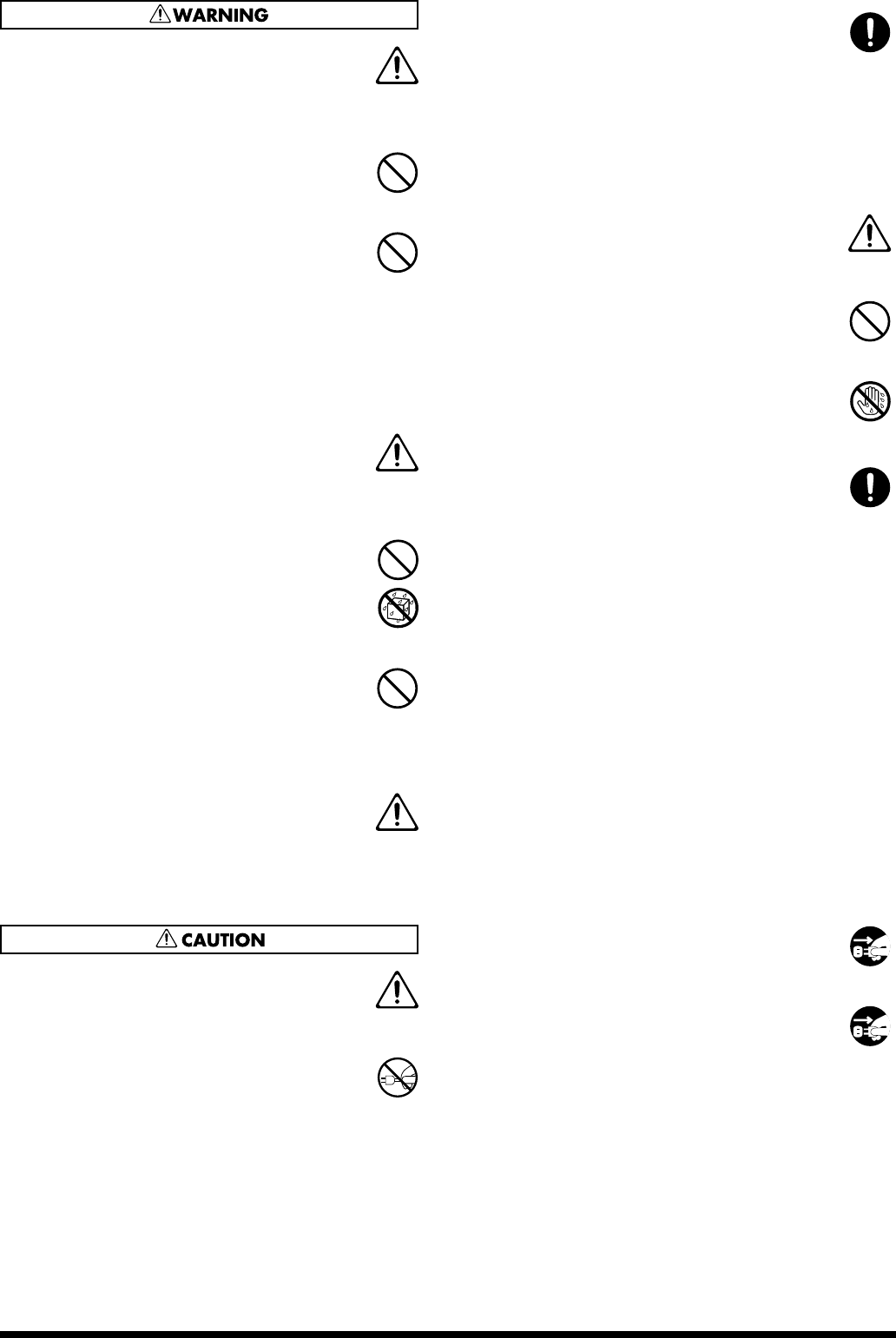
4
013
• In households with small children, an adult
should provide supervision until the child is
capable of following all the rules essential for the
safe operation of the unit.
..........................................................................................................
014
• Protect the unit from strong impact.
(Do not drop it!)
..........................................................................................................
015
• Do not force the unit’s power-supply cord to
share an outlet with an unreasonable number of
other devices. Be especially careful when using
extension cords—the total power used by all
devices you have connected to the extension
cord’s outlet must never exceed the power rating
(watts/amperes) for the extension cord. Excessive
loads can cause the insulation on the cord to heat
up and eventually melt through.
..........................................................................................................
016
• Before using the unit in a foreign country, consult
with your retailer, the nearest Roland Service
Center, or an authorized Roland distributor, as
listed on the “Information” page.
..........................................................................................................
019
• Batteries must never be recharged, heated, taken
apart, or thrown into fire or water.
..........................................................................................................
023
• DO NOT play a CD-ROM disc on a conventional
audio CD player. The resulting sound may be of a
level that could cause permanent hearing loss.
Damage to speakers or other system components
may result.
..........................................................................................................
026
• Do not put anything that contains water (e.g.,
flower vases) on this unit. Also, avoid the use of
insecticides, perfumes, alcohol, nail polish, spray
cans, etc., near the unit. Swiftly wipe away any
liquid that spills on the unit using a dry, soft
cloth.
..........................................................................................................
101a
• The unit should be located so that its location or
position does not interfere with its proper venti-
lation.
..........................................................................................................
102b
• Always grasp only the plug on the power-supply
cord when plugging into, or unplugging from, an
outlet or this unit.
..........................................................................................................
103a
• At regular intervals, you should unplug the
power plug and clean it by using a dry cloth to
wipe all dust and other accumulations away from
its prongs. Also, disconnect the power plug from
the power outlet whenever the unit is to remain
unused for an extended period of time. Any
accumulation of dust between the power plug
and the power outlet can result in poor insulation
and lead to fire.
..........................................................................................................
104
• Try to prevent cords and cables from becoming
entangled. Also, all cords and cables should be
placed so they are out of the reach of children.
..........................................................................................................
106
• Never climb on top of, nor place heavy objects on
the unit.
..........................................................................................................
107b
• Never handle the power cord or its plugs with
wet hands when plugging into, or unplugging
from, an outlet or this unit.
..........................................................................................................
108d: Selection
• If you need to move the instrument, take note of
the precautions listed below. At least two persons
are required to safely lift and move the unit. It
should be handled carefully, all the while keeping
it level. Make sure to have a firm grip, to protect
yourself from injury and the instrument from
damage.
1
• Check to make sure the screw securing the unit
to the stand have not become loose. Fasten
them again securely whenever you notice any
loosening.
2
• Disconnect the power cord.
3
• Disconnect all cords coming from external
devices.
4
• Raise the adjusters on the stand (p. 18).
5
• Close the lid.
7
• Fold down the music rest.
..........................................................................................................
109a
• Before cleaning the unit, turn off the power and
unplug the power cord from the outlet (p. 17).
..........................................................................................................
110a
• Whenever you suspect the possibility of lightning
in your area, pull the plug on the power cord out
of the outlet.
..........................................................................................................
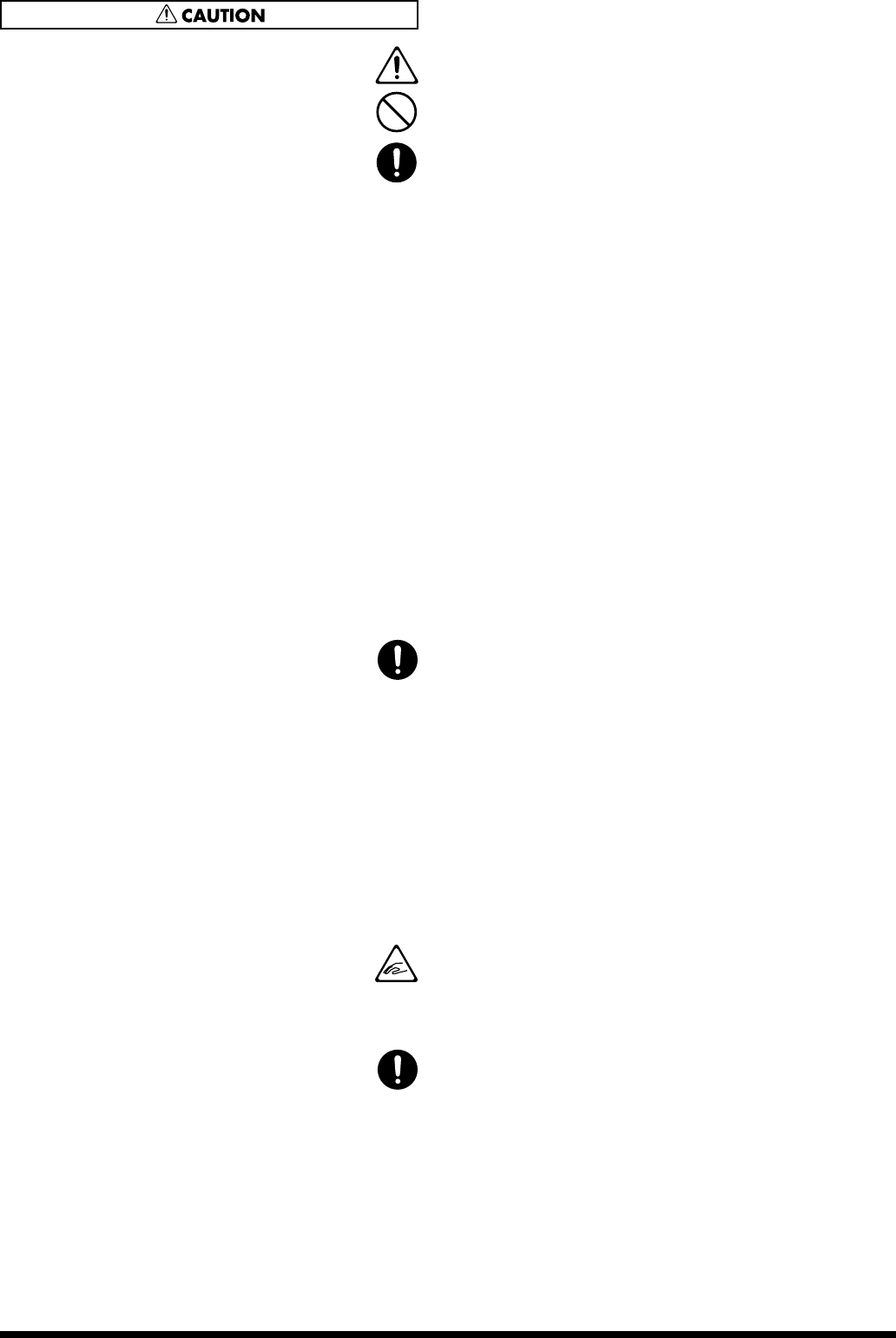
5
111: Selection
• If used improperly, batteries may explode or leak
and cause damage or injury. In the interest of
safety, please read and observe the following
precautions (p. 17).
1
• Carefully follow the installation instructions
for batteries, and make sure you observe the
correct polarity.
2
• Avoid using new batteries together with used
ones. In addition, avoid mixing different types
of batteries.
3
• Remove the batteries whenever the unit is to
remain unused for an extended period of time.
5
• If a battery has leaked, use a soft piece of cloth
or paper towel to wipe all remnants of the
discharge from the battery compartment. Then
install new batteries. To avoid inflammation of
the skin, make sure that none of the battery
discharge gets onto your hands or skin.
Exercise the utmost caution so that none of the
discharge gets near your eyes. Immediately
rinse the affected area with running water if
any of the discharge has entered the eyes.
6
• Never keep batteries together with metallic
objects such as ballpoint pens, necklaces,
hairpins, etc.
..........................................................................................................
112
• Used batteries must be disposed of in compliance
with whatever regulations for their safe disposal
that may be observed in the region in which you
live.
• The power-supply cord, or the plug has been
damaged; or
• If smoke or unusual odor occurs
• Objects have fallen into, or liquid has been
spilled onto the unit; or
• The unit has been exposed to rain (or otherwise
has become wet); or
• The unit does not appear to operate normally
or exhibits a marked change in performance.
..........................................................................................................
116
• Be careful when opening/closing the lid so you
do not get your fingers pinched (p. 17). Adult
supervision is recommended whenever small
children use the unit.
..........................................................................................................
118c
• Always keep the following parts including with
the RG-7 and small components that may be
removed out of the reach of small children to
avoid accidental ingestion of these parts.
Included Parts
• External memory anti-theft lock securing screw
Removable parts
• Screws fastening the stand
• Screws fastening music rest
• the thumbscrew fastening the headphone hook
..........................................................................................................

6
IMPORTANT NOTES
291b
In addition to the items listed under “IMPORTANT SAFETY INSTRUCTIONS” and “USING THE UNIT SAFELY” on pages 2 and 3,
please read and observe the following:
Power Supply
301
• Do not connect this unit to same electrical outlet that is being
used by an electrical appliance that is controlled by an inverter
(such as a refrigerator, washing machine, microwave oven, or air
conditioner), or that contains a motor. Depending on the way in
which the electrical appliance is used, power supply noise may
cause this unit to malfunction or may produce audible noise. If it
is not practical to use a separate electrical outlet, connect a power
supply noise filter between this unit and the electrical outlet.
306b
• Batteries are supplied with the unit. The life of these batteries
may be limited, however, since their primary purpose was to
enable testing.
307
• Before connecting this unit to other devices, turn off the power to
all units. This will help prevent malfunctions and/or damage to
speakers or other devices.
308
• Although the LCD and LEDs are switched off when the POWER
switch is switched off, this does not mean that the unit has been
completely disconnected from the source of power. If you need to
turn off the power completely, first turn off the POWER switch,
then unplug the power cord from the power outlet. For this
reason, the outlet into which you choose to connect the power
cord’s plug should be one that is within easy reach and readily
accessible.
Placement
351
• Using the unit near power amplifiers (or other equipment
containing large power transformers) may induce hum. To
alleviate the problem, change the orientation of this unit; or move
it farther away from the source of interference.
352a
• This device may interfere with radio and television reception. Do
not use this device in the vicinity of such receivers.
352b
• Noise may be produced if wireless communications devices, such
as cell phones, are operated in the vicinity of this unit. Such noise
could occur when receiving or initiating a call, or while
conversing. Should you experience such problems, you should
relocate such wireless devices so they are at a greater distance
from this unit, or switch them off.
354b
• Do not expose the unit to direct sunlight, place it near devices
that radiate heat, leave it inside an enclosed vehicle, or otherwise
subject it to temperature extremes. Also, do not allow lighting
devices that normally are used while their light source is very
close to the unit (such as a piano light), or powerful spotlights to
shine upon the same area of the unit for extended periods of time.
Excessive heat can deform or discolor the unit.
355b
• When moved from one location to another where the temper-
ature and/or humidity is very different, water droplets (conden-
sation) may form inside the unit. Damage or malfunction may
result if you attempt to use the unit in this condition. Therefore,
before using the unit, you must allow it to stand for several
hours, until the condensation has completely evaporated.
356
• Do not allow rubber, vinyl, or similar materials to remain on the
unit for long periods of time. Such objects can discolor or
otherwise harmfully affect the finish.
358
• Do not allow objects to remain on top of the keyboard. This can
be the cause of malfunction, such as keys ceasing to produce
sound.
359
• Do not paste stickers, decals, or the like to this instrument.
Peeling such matter off the instrument may damage the exterior
finish.
Maintenance
401b
• To clean the unit, use a dry, soft cloth; or one that is slightly
dampened. Try to wipe the entire surface using an equal amount
of strength, moving the cloth along with the grain of the wood.
Rubbing too hard in the same area can damage the finish.
402
• Never use benzine, thinners, alcohol or solvents of any kind, to
avoid the possibility of discoloration and/or deformation.
403
• The pedals of this unit are made of brass.
Brass eventually darkens as the result of the natural oxidization
process. If the brass becomes tarnished, polish it using commer-
cially available metal polisher.
Repairs and Data
452
• Please be aware that all data contained in the unit’s memory may
be lost when the unit is sent for repairs. Important data should
always be backed up on an external memory, or written down on
paper (when possible). During repairs, due care is taken to avoid
the loss of data. However, in certain cases (such as when circuitry
related to memory itself is out of order), we regret that it may not
be possible to restore the data, and Roland assumes no liability
concerning such loss of data.
Additional Precautions
551
• Please be aware that the contents of memory can be irretrievably
lost as a result of a malfunction, or the improper operation of the
unit. To protect yourself against the risk of loosing important
data, we recommend that you periodically save a backup copy of
important data you have stored in the unit’s memory on an
external memory.
552
• Unfortunately, it may be impossible to restore the contents of
data that was stored on an external memory once it has been lost.
Roland Corporation assumes no liability concerning such loss of
data.
553
• Use a reasonable amount of care when using the unit’s buttons,
sliders, or other controls; and when using its jacks and
connectors. Rough handling can lead to malfunctions.
554
• Never strike or apply strong pressure to the display.
556
• When connecting / disconnecting all cables, grasp the connector
itself—never pull on the cable. This way you will avoid causing
shorts, or damage to the cable’s internal elements.
557
• A small amount of heat will radiate from the unit during normal
operation.
558a
• To avoid disturbing your neighbors, try to keep the unit’s volume
at reasonable levels. You may prefer to use headphones, so you
do not need to be concerned about those around you (especially
when it is late at night).
559b
• When you need to transport the unit, pack it in shock-absorbent
material. Transporting the unit without doing so can cause it to
become scratched or damaged, and could lead to malfunction.
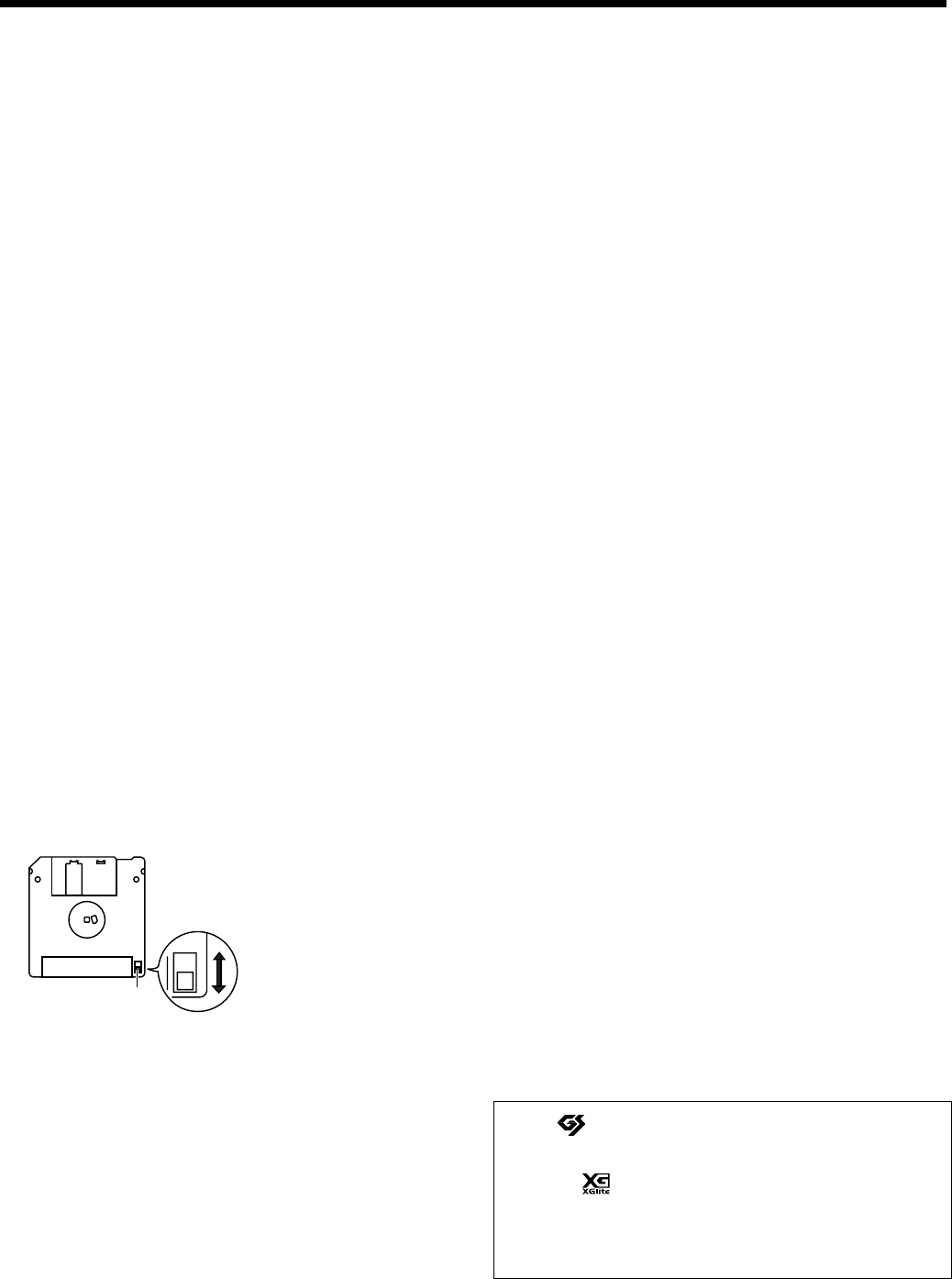
7
560
• Do not apply undue force to the music rest while it is in use.
561
• Use only the specified expression pedal (EV-7/5; sold separately).
By connecting any other expression pedals, you risk causing
malfunction and/or damage to the unit.
562
• Use a cable from Roland to make the connection. If using some
other make of connection cable, please note the following precau-
tions.
• Some connection cables contain resistors. Do not use cables
that incorporate resistors for connecting to this unit. The use
of such cables can cause the sound level to be extremely low,
or impossible to hear. For information on cable specifications,
contact the manufacturer of the cable.
565
• Before opening or closing the keyboard lid, always make sure
that no pets or other small animals are located on top of the
instrument (in particular, they should be kept away from the
keyboard and its lid). Otherwise, due to the structural design of
this instrument, small pets or other animals could end up getting
trapped inside it. If such a situation is encountered, you must
immediately switch off the power and disconnect the power cord
from the outlet. You should then consult with the retailer from
whom the instrument was purchased, or contact the nearest
Roland Service Center.
Handling Floppy Disks
651
• Floppy disks contain a plastic disk with a thin coating of
magnetic storage medium. Microscopic precision is required to
enable storage of large amounts of data on such a small surface
area. To preserve their integrity, please observe the following
when handling floppy disks:
• Never touch the magnetic medium inside the disk.
• Do not use or store floppy disks in dirty or dusty areas.
• Do not subject floppy disks to temperature extremes (e.g.,
direct sunlight in an enclosed vehicle). Recommended
temperature range: 10 to 50˚C (50 to 122˚F).
• Do not expose floppy disks to strong magnetic fields, such as
those generated by loudspeakers.
652
• Floppy disks have a “write protect” tab which can protect the
disk from accidental erasure. It is recommended that the tab be
kept in the PROTECT position, and moved to the WRITE position
only when you wish to write new data onto the disk.
fig.DiskProtect.e
653
• The identification label should be firmly affixed to the disk.
Should the label come loose while the disk is in the drive, it may
be difficult to remove the disk.
654
• Store all disks in a safe place to avoid damaging them, and to
protect them from dust, dirt, and other hazards. By using a dirty
or dust-ridden disk, you risk damaging the disk, as well as
causing the disk drive to malfunction.
655
• Disks containing performance data for this unit should always be
locked (have their write protect tab slid to the “Protect” position)
before you insert them into the drive on some other unit (except
the PR-300, or a product in the HP-G, HPi, MT, KR, or Atelier
families), or into a computer’s drive. Otherwise (if the write
protect tab remains in the “Write” position), when you perform
any disk operations using the other device’s disk drive (such as
checking the contents of the disk, or loading data), you risk
rendering the disk unreadable by this unit’s disk drive.
Handling CD-ROMs
801
• Avoid touching or scratching the shiny underside (encoded
surface) of the disc. Damaged or dirty CD-ROM discs may not be
read properly. Keep your discs clean using a commercially
available CD cleaner.
Before Using External
Memory
Using External Memory
705
• Never touch the terminals of the External memory. Also,
avoid getting the terminals dirty.
708
• External memories are constructed using precision
components; handle the cards carefully, paying particular
note to the following.
• To prevent damage to the cards from static electricity,
be sure to discharge any static electricity from your
own body before handling the cards.
• Do not touch or allow metal to come into contact with
the contact portion of the cards.
• Do not bend, drop, or subject cards to strong shock or
vibration.
• Do not keep cards in direct sunlight, in closed vehicles,
or other such locations (storage temperature: 0 to 50˚
C).
• Do not allow cards to become wet.
• Do not disassemble or modify the cards.
704 (revise)
• When connecting external memory, make sure to press it
until it is fully inserted.
• Insert the external memory in the External Memory port
evenly and without undue force. Forcing the external
memory may damage the External Memory port.
• Do not insert any object other than the external memory
(e.g., wires, coins, other types of disks, etc.) in the External
Memory port. This may damage the External Memory
port.
• Do not subject the External Memory port cover or
connected External memory to excessive stress.
• Close the external memory cover when using the External
memory for extended periods
203
* GS ( ) is a registered trademark of Roland Corpo-
ration.
* XG lite ( ) is a registered trademark of Yamaha Corpo-
ration.
220
* All product names mentioned in this document are trade-
marks or registered trademarks of their respective owners.
Rear side of the disk
Write
(can write new data onto disk)
Protect
(prevents writing to disk)
Write Protect Tab

8
Introduction
Thank you, and congratulations on your choice of the Roland KR Intelligent Piano.
While the KR Intelligent Piano certainly allows you to achieve authentic piano performances, it also
features easy-to-use Automatic Accompaniment and numerous other useful functions. In order to
enjoy reliable performance of your new keyboard for many years to come, please take the time to read
through this manual in its entirety.
Main Features
❍
Lusciously Resounding, Richly Expressive Piano Sound
The KR107 reproduces the rich tones of a high-quality grand piano, from the sounds of the hammers
as they strike the strings to the sounds made as the keys are released. 128-voice polyphony ensures
full responsiveness, even with heavy use of the pedals.
What's more, The “Piano Designer” feature allows you to create your own favorite piano tones.
❍
True Grand Piano Feel
The KR107 features Roland's Progressive Hammer Action keyboard, which reproduces the feel of a
grand piano, with a firm, weighty touch in the lower registers and a lighter response in the upper
registers. This keyboard also faithfully reproduces the distinctive “click” that's produced when a
grand piano's keys are played (Escapement function).
In addition to the ability of adjusting the key weight, a “Hammer Response” function, which
reproduces the subtle action of the hammers, is also incorporated, so there are two key-touch controls
that come into play when determining the precise character of the keyboard. Additionally, the
instrument's pedals are firm and responsive, lending your performances fuller and more detailed
expressiveness.
❍
Accomplish Tasks Easily with the Main Buttons
Almost all of the KR’s common functions, including playing back songs, displaying notations,
running the automatic accompaniment, selecting tones, and so on can be accomplished using the Main
buttons to the left of the screen.
❍
A Wealth of Practice Features to Foster Musical Growth
Use the “Visual Lesson” feature for enjoyable practice and steady improvement.
You can use this function to score the results of your performances and find out which notes have been
played differently than those indicated in the notation.
The KR also scrolls the notation automatically as you play, making your practices even more
convenient.
❍
Connector Allows Enlarged Display of Music and Lyrics
The KR107 is equipped with a connector for use with televisions and other external displays.
Connecting a large screen to the KR107 allows you to display a greater number of measures at the
same time.
Notes are colored for easy viewing, a feature that is useful for personal practice as well as in lessons.
❍
Easy-To-Use “Music Assistant” Automatic Accompaniment
Feature
You can select from an amazing 500 settings to get automatic accompaniment that perfectly matches
the song you are playing.
Each song's Music Assistant settings are shown in a manner that is easy to grasp, so playing along
with the changes in the accompaniment is a snap.
For easy enjoyment of Music Assistant, the KR107 also includes songs that you can perform while
reading the chord charts.

9
Introduction
❍
Color Display for Easy Operation
The KR107 features a color screen touch panel with rich graphics to make viewing easier. Operations
can be carried out easily, just by touching the screen.
❍
Utilizes External Memory--the New Media
You can save song data created on the KR107 to External memory (sold separately). Extremely
portable, high-capacity external memory also connects easily to computers, allowing song data to be
transferred easily. Taking further advantage of the high-capacity memory, you can also play back
audio files with the KR107.
How To Use This Manual
The KR Owner’s Manual consists of two volumes,
Quick Start
,
Owner’s Manual,
and the
USB Install
Guide
.
Please start out by reading “Before You Start Playing” (p. 16) in the
Owner’s Manual
(this volume).
This explains how to connect the KR’s power cord and how to turn on the instrument’s power.
After turning on the KR’s power, please continue by reading
Quick Start
.
By trying out the various procedures while reading the
Quick Start
, you can easily learn how to play
the KR and make use of its major functions (especially procedures that involve use of the “main
buttons”).
The
Owner’s Manual
describes procedures, from basic operation to procedures for special
applications (for example, using the KR as an accompanist and creating songs), that will help you
master the KR’s many performance functions.
When connecting a computer to the USB port, be sure to read the computer connection guide. This
describes the procedure for installing the driver needed to connect via USB.
* For more on system requirements, refer to the “USB Installation Guide.” However, note that the
KR107 is not compatible with Mac OS 9.
■
Conventions Used in This Manual
This manual uses the following conventions in the interest of simpler, more concise instructions.
• Button names are enclosed in square brackets “[ ]”, as in One Touch Program [Piano]
button.
• For easier readability, some screens and colors used here may differ in part from actual
screens and colors.
• On screen text is enclosed in angled brackets “< >”, as in <Exit>.
• The act of lightly contacting the Touch Screen with your finger is called “touching.”
• An asterisk (*) or a at the beginning of a paragraph indicates a note or
precaution. These should not be ignored.
• (p. **) refers to pages within the manual.
NOTE

10
Contents
USING THE UNIT SAFELY...............................................................3
IMPORTANT NOTES.........................................................................6
Introduction ...............................................................8
Main Features.......................................................................................8
How To Use This Manual ..................................................................9
Conventions Used in This Manual..............................................9
Panel Descriptions..................................................10
Balance...........................................................................................10
Performance Pads ........................................................................10
Rhythm Partner............................................................................10
Record/Playback .........................................................................11
Rear Panel ...........................................................................................12
Bottom Panel ......................................................................................12
Bottom Panel (Front Left) ...........................................................12
Bottom Panel (Front Right).........................................................12
Before You Start Playing ........................................18
Connect the Pedal Cable...................................................................18
Connect the Speaker Cable...............................................................18
Connect the Power Cord ..................................................................18
Setting Up the Music Rest ................................................................18
Folding Down the Music Rest....................................................18
Using the Music Holders ............................................................18
Removing the Music Rest ...........................................................18
Installing Batteries in the Remote Control.....................................19
Opening/Closing the Lid.................................................................19
Turning the Power On and Off........................................................19
About the Pedals................................................................................20
Adjusting the Sound’s Volume and Brilliance ..............................20
Connecting Headphones ..................................................................20
Using the Headphone Hook.......................................................21
Connecting a Microphone................................................................21
About the Touch Screen ...................................................................21
Adjusting the Contrast of the Screen ........................................21
Main Screens ......................................................................................22
Piano Screen..................................................................................22
Basic Screen...................................................................................22
Using the Main Icons...................................................................22
The [Option] Button and The [Exit] Button .............................22
The Scroll Bar and The Page Icon ..............................................22
Chapter 1 Performance...........................................23
Playing the Keyboard Like a Piano (One-Touch Piano) ..............23
Performing with a Variety of Tones (Tone Buttons) ....................24
Playing Percussion Instruments or Sound Effects ..................25
Using Keywords to Search for Tones (Tone Search) ..............26
Performing with Multiple Sounds Layered Together (Layer)....27
Playing Different Tones with the Left and Right Hands (Split) .28
Shifting the Keyboard Pitch in Octave Steps (Octave Shift)..29
Adding Reverberation to the Sound (Reverb)...............................30
Adding Three-Dimensional Breadth to the Sounds You Play
(Advanced 3D) ...................................................................................32
Adding Liveliness to the Sound (Dynamic Emphasis) ................34
Adjusting the Sound to Achieve the Preferred Tone Quality
(Equalizer)...........................................................................................35
Applying Effects to the Sound (Effects) .........................................37
Adding Effects to Mic Vocals (Vocal Effect)..................................38
Enjoying Karaoke Performances with Music Files .................44
Using the Metronome .......................................................................45
Using the Metronome..................................................................45
Changing the Metronome Settings............................................46
Chapter 2 Automatic Accompaniment ................. 48
Music Styles and Automatic Accompaniment..............................48
Performing Using Automatic Accompaniment
(One-Touch Arranger) .....................................................................49
About Chords ...............................................................................50
Playing Chords with Simple Fingering
(Chord Intelligence).....................................................................50
Viewing Chord Fingerings (Chord Finder)..............................51
Selecting Music Styles (Music Style Buttons) ................................52
Selecting Music Styles on External Memories .........................53
Using Keywords to Search for Music Styles
(Style Search) ................................................................................54
Playing Only Music Style Rhythm Patterns ..................................55
Adjusting the Accompaniment Tempo ..........................................55
Starting and Stopping the Accompaniment ..................................56
Having the Accompaniment Start Simultaneously
When You Play the Keyboard (Sync)........................................56
Stopping Automatic Accompaniment ......................................57
Having a Count Sound Play at the End of the Intro
(Countdown) ................................................................................58
Modifying an Accompaniment........................................................59
Changing the Accompaniment Pattern
(Fill In Buttons).............................................................................59
Changing Accompaniment Patterns in the Screen .................60
Changing the Instrumental Makeup of Music Styles
(Style Orchestrator)......................................................................60
Adding Harmony to the Right-Hand Part
(Melody Intelligence) ........................................................................61
Playing Sounds in the Left Hand During a Performance
(Lower Tone) ......................................................................................62
Playing the Piano with Accompaniment Added
(Piano Style Arranger) ......................................................................63
Adjusting the Volume Balance for Each Part (Balance)...............64
Changing the Volume Balance between the Accompaniment
and the Keyboard (Balance Knob).............................................64
Adjusting the Volume Balance for Each Performance Part
(Part Balance)................................................................................64
Chapter 3 Song Playback ...................................... 66
Playing a Song....................................................................................66
Using Keywords to Search for Songs (Song Search)...............69
Registering the Songs You Like (Favorites)...................................70
Removing Songs from Favorites................................................71

11
Contents
Using the Remote Control................................................................72
How to Use the Remote Control................................................72
About the Remote Control .........................................................73
Chapter 4 Practice Functions ................................75
Displaying the Notation ...................................................................75
Touching Notes to Confirm the Sounds
(Touch the Notes).........................................................................76
Scrolling the Notation Along with the Performances
(Auto Sync DigiScore) .................................................................76
Making Detailed Settings for the Notation Display ...............77
Saving Notations as Image Data................................................80
Adjusting the Tempo ........................................................................82
Setting the Tempo by Pressing the Button in Time
(Tap Tempo) .................................................................................82
Playing Back at a Fixed Tempo (Tempo Mute) .......................83
Match the Tempo Before You Begin Playing (Count)..................84
Muting Some Parts Before Playing (Track Buttons).....................85
Setting Markers for Repeated Practice (Marker)...........................86
Placing a Marker within a Song.................................................86
Playback from a Marker Location .............................................87
Erasing a Marker..........................................................................87
Moving a Marker .........................................................................87
Playing Back the Same Passage Over and Over......................88
Transposing Keyboard Sounds and Songs Played Back
(Transpose) .........................................................................................89
Chapter 5 Recording and Saving the Performance .
91
Recording a New Song (New Song) ...............................................92
Recording With Accompaniment....................................................94
Recording Along with a Song..........................................................96
Recording While Selecting the Track Buttons
(Redoing Recordings) .......................................................................97
Erasing Recorded Performances .....................................................98
Erasing the Performance on Specific Tracks............................98
Changing How Recording Stops.....................................................98
Recording Songs Starting with Pickups.........................................99
Using External Memories...............................................................100
Connecting and Ejecting a External Memory ........................100
Formatting Media (Format)......................................................101
Saving Songs ....................................................................................103
Deleting Saved Songs......................................................................106
Copying Songs on External Memories to Favorites ...................107
Copying Songs Saved in Favorites to External Memories...108
Chapter 6 User Program Registration.................109
Saving Performance Settings (User Program).............................109
Calling Up Saved User Programs .................................................110
Changing the Way User Programs Are Called Up...............110
Saving the User Program Sets........................................................110
Loading Saved User Program Sets ..........................................111
Deleting Saved User Program Sets ...............................................112
Copying Sets of User Programs on Floppy Disks to the User
Memory.............................................................................................112
Coping Sets of User Programs Stored in the User Memory to
Floppy Disks...............................................................................113
Using the Pedal to Switch User Programs ...................................113
Selecting the Pedal Used for Switching Settings
(Pedal Shift).................................................................................113
Sequential Loading of User Program Sets Stored in
External Memory (Load Next) .................................................113
Simultaneously Switching User Program and Transmitting
PC Numbers .....................................................................................113
Chapter 7 Creating and Editing Songs .............. 115
Multitrack Recording with 16 Parts (16-Track Sequencer)........115
The 16-Track Sequencer Screen................................................115
Modifying the Settings of Each Part........................................116
Getting the Most Suitable Part Tones for the Musical Genre
(Tone Set).....................................................................................117
Recording a Performance..........................................................117
Changing the Recording Method (Rec Mode).............................118
Recording While Erasing the Previous Recording
(Replace Recording)...................................................................119
Layering a Recording Over Previously Recorded Sounds
(Mix Recording) .........................................................................119
Repeated Recording at the Same Location
(Loop Recording) .......................................................................120
Re-Recording Part of Your Performance
(Punch-in Recording) ................................................................121
Composing an Accompaniment By Entering Chords
(Chord Sequencer)...........................................................................122
Inputting Chords without Playing the Keyboard.................123
Editing Songs ...................................................................................123
Basic Operation of the Editing Functions...............................123
Undoing Edits (Undo)...............................................................124
Copying Measures (Copy)........................................................124
Correcting Timing Discrepancies (Quantize) ........................125
Deleting Measures (Delete) ......................................................125
Inserting Blank Measures (Insert)............................................126
Transposing Individual Parts (Transpose).............................126
Making Measures Blank (Erase) ..............................................126
Exchanging Parts (Part Exchange)...........................................127
Correcting Notes One by One (Note Edit) .............................128
Modifying the Tone Changes in a Song (PC Edit) ................128
Changing the Beat in the Middle of a Song (Beat Map).............129
Changing the Tempo of Recorded Songs.....................................129
Changing the Tempo Within the Song.........................................129
Adjusting the Tempo While Listening to a Song ..................129
Adjusting the Tempo at a Particular Measure.......................130
Chapter 8 Creating Music Styles ........................ 131
Creating Original Styles (User Styles) ..........................................131
Creating New Styles by Combining Internal Music Styles
(Style Composer)........................................................................131
Creating a Style from a Song You Composed Yourself

12
Contents
(Style Converter) ........................................................................133
Saving a User Style..........................................................................136
Deleting Saved User Styles.......................................................137
Copying Styles on Floppy Disks to the User Memory...............138
Copying Styles Saved in the User Memory to
Floppy Disks...............................................................................138
Chapter 9 Various Settings ..................................139
Changing the Settings for One-Touch Arranger.........................139
Procedure ....................................................................................139
Adjusting the Keyboard Touch (Key Touch).........................139
Changing the Keyboard’s Split Point (Split Point) ...............140
Changing Music Styles Without Changing the Tone or
Tempo (One Touch Setting) .....................................................140
Changing How Chords Are Played and Specified
(Arranger Config) ......................................................................140
Placing a Marker in the Middle of a Measure .............................142
Changing the Settings for the Count ............................................142
Other Settings...................................................................................143
Procedure ....................................................................................143
Changing the Tuning (Tuning)................................................144
Assigning Functions to Pedals and Performance Pads
(Pedal Setting/User Functions) ...............................................145
Changing the Bend Range (Pedal Setting) .............................147
Changing Standard Pitch (Master Tune)................................147
Changing the Language (Language).......................................147
Selecting Images To Be Shown on the KR and
External Displays
(User Image Display).................................................................148
Changing the Screen Message When the Power Is
Turned On (Opening Message) ...............................................148
Remembering the Settings Even When the Power is
Turned Off (Memory Backup) .................................................149
Restoring the Factory Settings (Factory Reset)......................149
Changing the Functions of the Remote Control’s Buttons ..150
Switching the Remote Sensor On and Off (iR function) ......151
Calibrating the Touch Screen (Touch Screen)........................151
Selecting the Part to Which the Effect is Added (Effects Part)..151
Formatting the User Memory ........................................................152
Automatically Starting the Quick Tour........................................152
Adjusting the Piano Designer Resonance ....................................153
Disabling Functions Other Than Piano Performance
(Panel Lock)......................................................................................153
Detailed Song Playback Settings ...................................................154
Changing the Tone Settings When Playing Back Songs
(Play Mode).................................................................................154
Viewing Song Information (Information) .............................154
Hiding the Lyrics (Lyrics).........................................................154
Changing the Parts Assigned to the Track Buttons
During SMF Playback (Track Assign).....................................155
Chapter 10 Connecting External Devices ...........156
Connecting an External Display or Television............................156
Connecting an External Display ..............................................156
Connecting a Television............................................................157
Changing the Settings for Showing Images with the
External Display and the Television (External Display) ......158
Connecting Video Equipment (V-LINK) .....................................158
Using the V-LINK function ......................................................158
Connecting MIDI Devices ..............................................................159
Connectors ..................................................................................159
Making the Connections ...........................................................160
Performing in Ensemble with MIDI Instruments
(MIDI Ensemble)..............................................................................160
MIDI Settings ...................................................................................161
Selecting the Transmit Channel (Tx Channel).......................161
Disconnecting the Internal Sound Generator and
Keyboard (Local Control) .........................................................161
Sending Tone Change Messages (Program Change/
Bank Select MSB/Bank Select LSB) .........................................162
Sending Recorded Performance Data to a MIDI Device
(Composer MIDI Out)...............................................................162
Connecting to Audio Equipment ..................................................163
Connectors ..................................................................................163
Making the Connections ...........................................................163
Connecting a Computer..................................................................164
Connect to the MIDI Connectors .............................................164
Connect to the USB Connector.................................................165
Making the Settings for the USB Driver .................................165
Troubleshooting...............................................................................166
Appendices........................................................... 166
Error Messages.................................................................................170
Tone List............................................................................................171
Drum Set List....................................................................................173
Effects List.........................................................................................177
Music Style List................................................................................178
Chord List .........................................................................................179
Internal Song List.............................................................................181
Parameters Stored to Internal Memory........................................183
Music Files That the KR Can Use ..................................................184
The KR allows you to use the following music files.............184
About the KR Sound Generator...............................................184
Main Specifications..........................................................................186
MIDI Implementation Chart ..........................................................186
Index...................................................................... 187
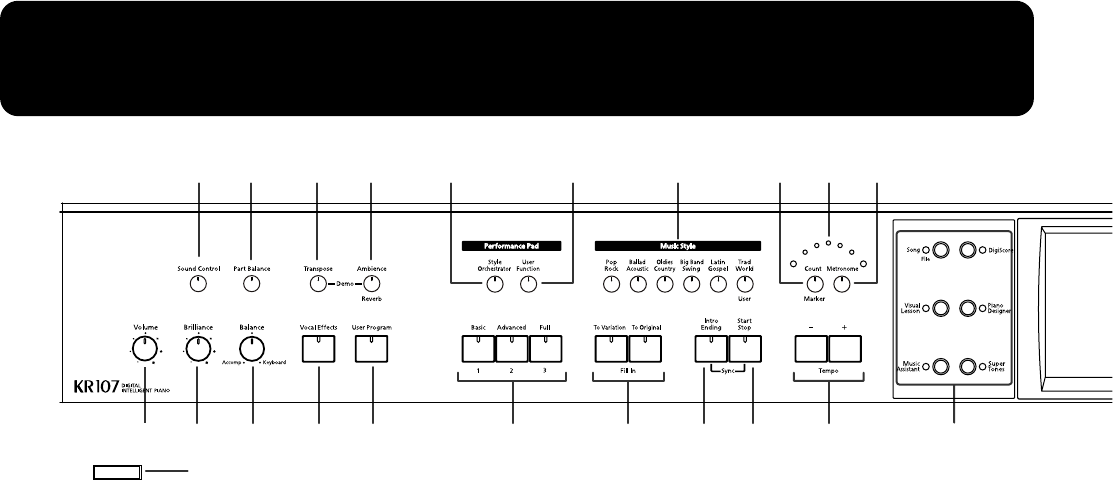
13
Panel Descriptions
1. [Power] switch
Pressed to switch the power on and off (p. **).
2. [Volume] knob
Adjusts the overall volume (p. **).
3. [Sound Control] button.
Add liveliness to the sound to give it superb clarity and
distinctness.
4. [Brilliance] knob
Adjusts the brightness of the sound (p. **).
Balance
5. [Part Balance] button
This adjusts the relative volume levels of each of the
performance parts (p. **).
6. [Balance] knob
Changes the volume balance for sounds played with the
keyboard and for songs and accompaniments (p. **).
7. [Transpose] button
Transposes the pitch of the keyboard or the song being played
(p. **).
8. [Vocal Effect] Button
Applies a variety of effects to vocals from the microphone (p.
**).
9. [Ambience/Reverb] button
Adds reverberation to the sound (p. **).
Adds three-dimensional breadth to the sound
10. [User Program] button
Stores the selected functions and states of the buttons (p. **).
Performance Pads
11. [Style Orchestrator] button
This is used to change the arrangement type for automatic
accompaniment with the Performance Pads (p. **).
12. [User Function] Button
This is used to assign a variety of functions to the Performance
Pads (p. **).
13. [1]-[3] buttons
The operation of each is changed depending on the buttons
numbered 11-12.
14. Music Style buttons
Selects a Music Style for automatic accompaniment (p. 62).
Pressing the [User] button selects a User Style that you’ve made
yourself or a Music Style on floppy disk (p. 63).
15. Fill In buttons
Inserts a fill-in in an automatic accompaniment and changes the
accompaniment pattern (p. 69).
[To Variation] button
[To Original] button
16. [Intro/Ending] button
Play an intro or ending during automatic accompaniment (p.
66).
17. [Start/Stop] button
Starts and stops automatic accompaniment (p. 66).
Rhythm Partner
18. [Count/Marker] button
You can change the count settings (p. 160).
These allow you to add and move markers in the notation as
well as repeat playback of song segments simply and easily.
19. [Metronome] button
Activates the built-in metronome (p. 52).
20. Beat Indicator
This lights up in correspondence with the beat of the selected
song or accompaniment.
21. Tempo [-] [+] buttons
Adjusts the tempo.
Press the [-] and [+] buttons at the same time to return to the
original tempo.
Power 1
2 4 6 8 10 2216 1713
35 7 9 1411 12 18 2019
15 21
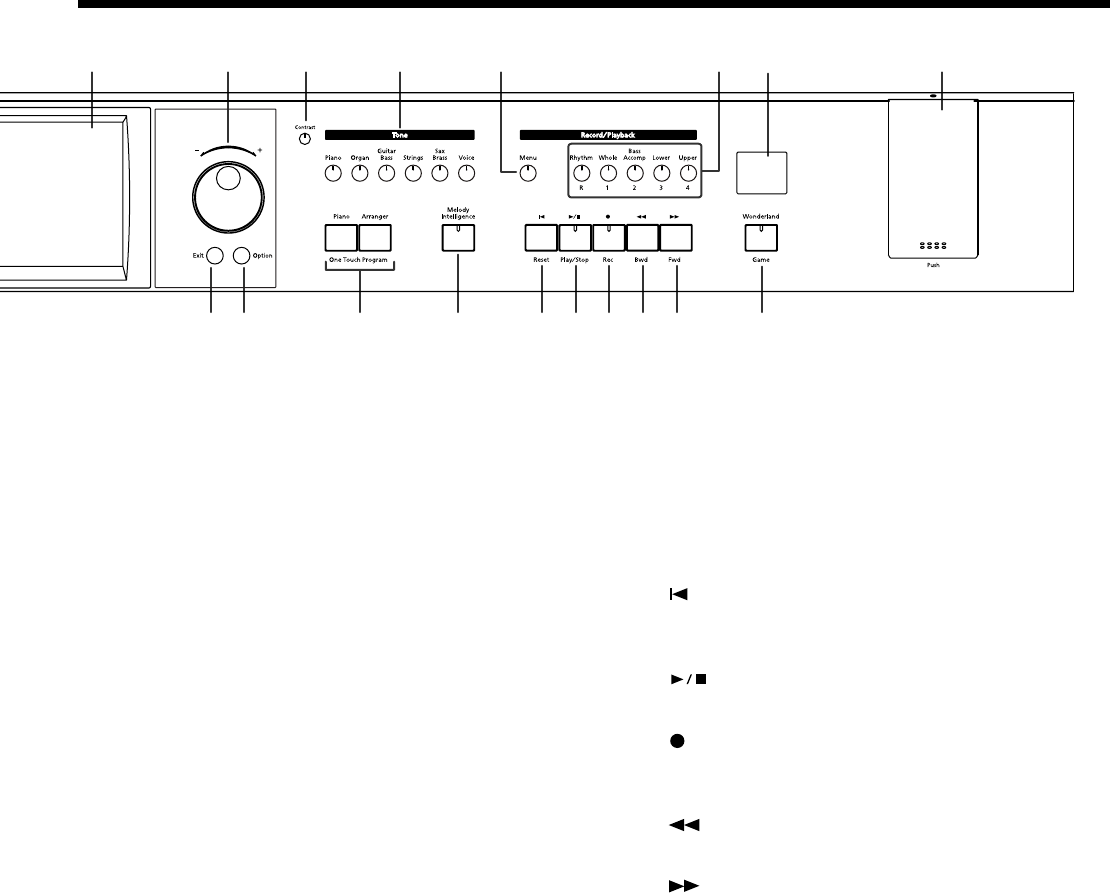
14
Panel Descriptions
22. Main Buttons
-> See the Quick Start
[Song/File] button
Use this button to select internal songs or songs from floppy
disk (p. **).
[DigiScore] button
Displays scores (p. **).
[Visual Lesson] button
You can use the practice function.
[Piano Designer] button
[Music Assistant] button
[Super Tones] button
23. Touch Screen
This lets you perform a variety of operations just by touching
the screen (p. **).
24. Dial
Use this to change on-screen values.
25. [Exit] button
Returns you to the previous screen.
26. [Option] button
Displays a screen for advance function settings.
27. Contrast knob
Adjusts the contrast of the screen (p. **).
28. [Tone] buttons
Select the Tones that will be played from the keyboard (p. **).
29. One Touch Program button
[Piano] button
Makes the optimal settings for a piano performance (p. **).
[Arranger] button
Makes the optimal settings for playing with automatic
accompaniment (p. **).
30. [Melody Intelligence] Button
Adds harmony to the sounds played with the keyboard (p. **).
Record/Playback
31. [Menu] button
You can select functions for playing back, recording or editing a
song (p. **, p. **).
32. Track buttons
Used to play back or record each track of a song (p. **, p. **).
33. [ (Reset)] button
Resets the song playback-start location to the beginning of the
song.
34. [ (Play/Stop)] button
Starts and stops playback or recording a song.
35. [ (Rec)] button
When pressed, this button places the instrument in recording
standby (p. **, p. **).
36. [ (Bwd)] button
Rewinds the song.
37. [ (Fwd)] button
Fast-forwards the song.
38. Infrared Receiver
Point the remote control at this sensor when using the remote
control to operate the KR107 (p. **).
39. [Wonderland/Game] button
Here you can learn about instruments while having fun.
-> See the Quick Start
40. External memory port
Connects an external memory to play and save songs (p.**).
* Be sure to close the cover of the External Memory port after
connecting USB memory to the External Memory port. If the
cover is left open, someone could get hurt if their legs bump
into it; the cover could be damaged as well.
30 33 34 35 36 37 39
2827 40383223 24 31
2526 29
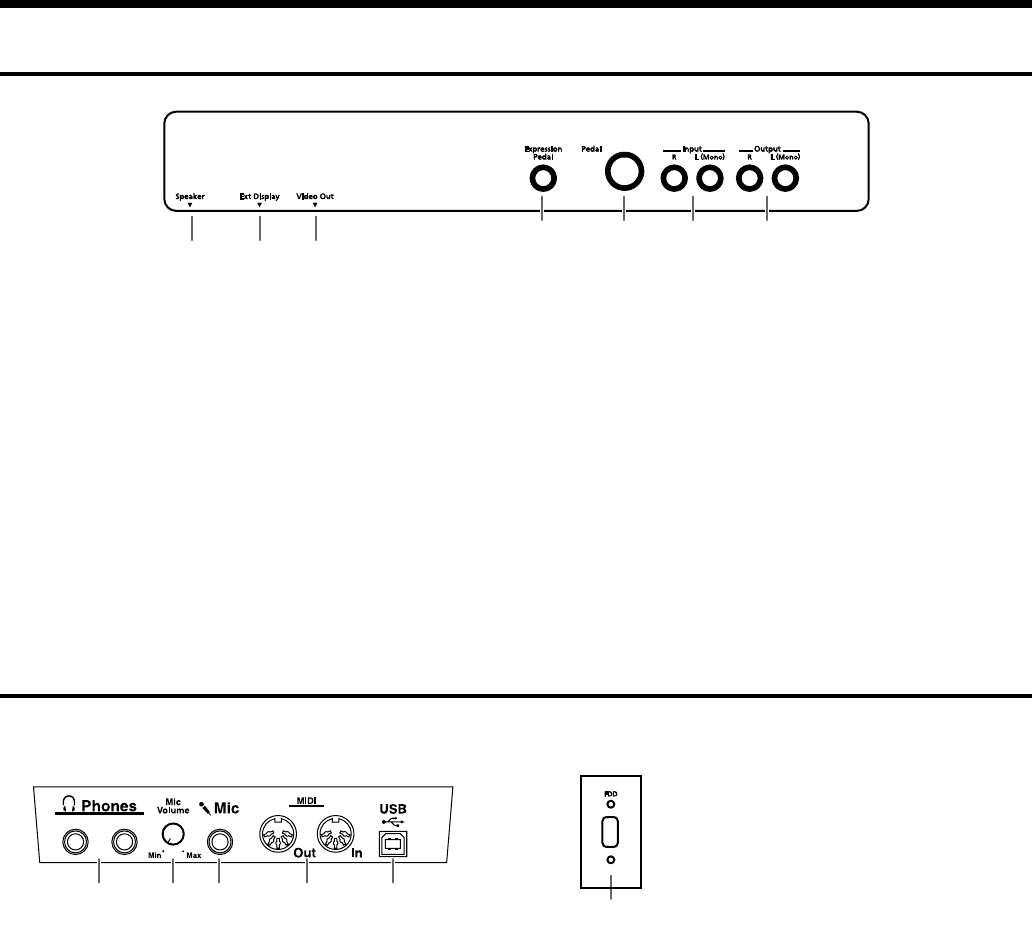
15
Panel Descriptions
Rear Panel
fig.panelRear
1. Speaker Jack
Connect the speaker cable of the stand (p. **).
2. Ext Display connector
Connect an external display. You can put notations on the
screen and display lyrics (p. **).
3. Video Out Connector
Connect a television here. This allows you to display the
notations and lyrics on the connected television set (p. **).
4. Expression Pedal jack
You can connect an expression pedal to the KR.
5. Pedal connector
Connect the pedal cable of the stand to this connector (p. **).
6. Input jacks
These jacks can be connected to another sound generating
device or an audio device, so that the sound of that device will
be output from the KR’s speakers (p. **).
7. Output jacks
These jacks can be connected to your audio system to enjoy
more powerful sound. They can also be connected to a tape
recorder or similar device in order to record your performance
on a cassette tape (p. **).
Bottom Panel
Bottom Panel (Front Left)
fig.panelbottom
1. Phones jacks
A set of headphones can be connected here (p. **).
2. Mic Volume knob
Adjusts the volume level for the microphone (p. **).
3. Mic In jack
Used for connecting microphones (p. **).
4. MIDI Out/In connectors
These can be connected to an external MIDI device to exchange
performance data (p. **).
5. USB Connector
You can connect a computer and exchange performance data
between the instrument and the computer (p. **).
Bottom Panel (Front Right)
fig.panelUSB
6. Floppy Disk Drive Connector
Connects an optional floppy disk drive to play and save songs
(p.**).
* Use floppy disk drive available from Roland.
1 2 3 4 5 6 7
1 2 3 4 5 6
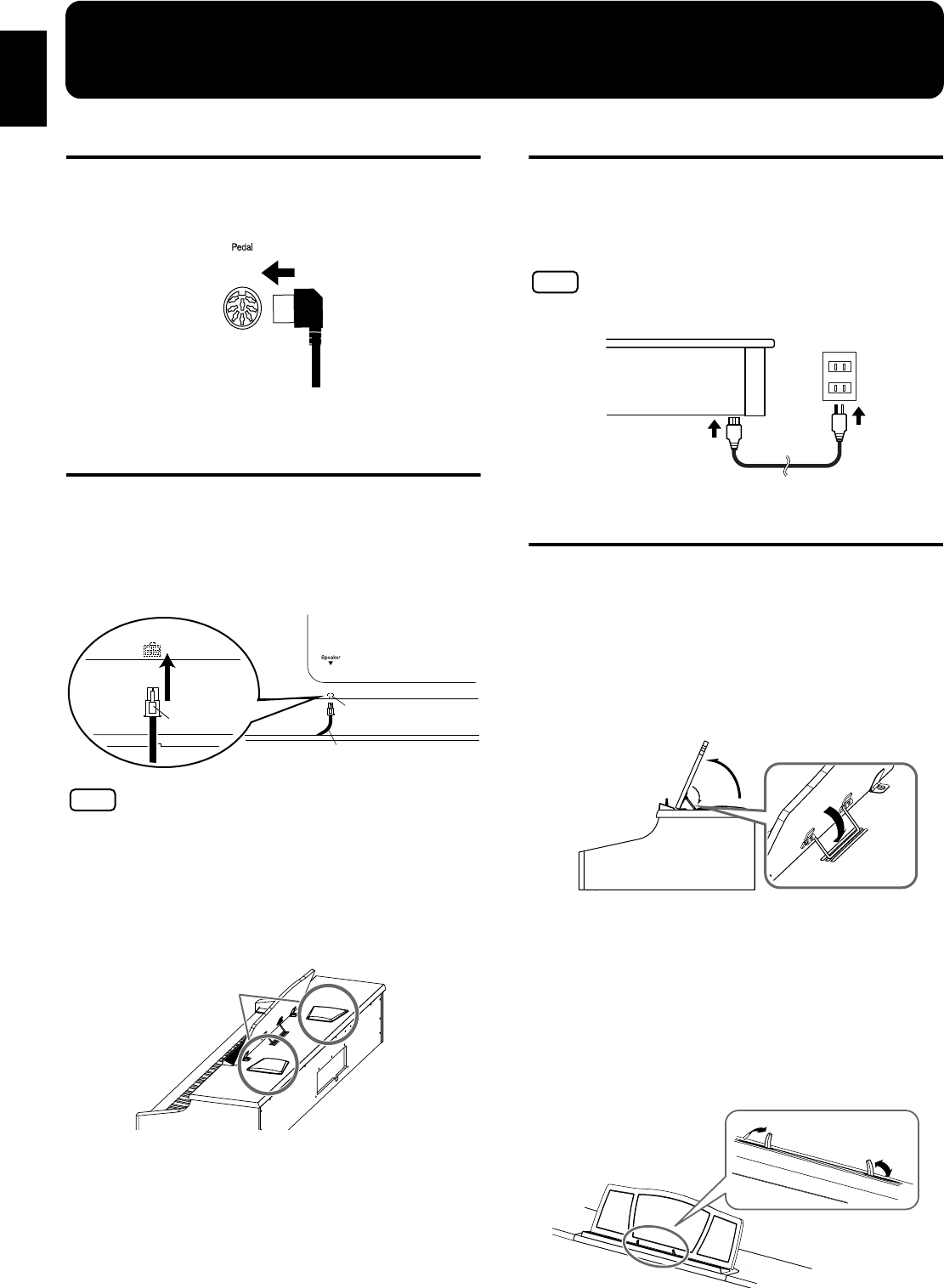
16
Before You
Start Playing
Before You Start Playing
Connect the Pedal Cable
Insert the pedal cable into the Pedal connector on the
rear panel of the KR107.
fig.00-01
Connect the Speaker Cable
As shown in the diagram, connect the speaker cable
leading from the speaker box of the stand to the speaker
connector located on the rear panel of the KR107.
Push the speaker cable in until it clicks into position.
NOTE
Do not place containers holding liquids (such as flower vases),
insecticide, perfume, alcohol, or similar substances on top of this
piano.
The speakers of this piano are mounted beneath the upper surface,
and face upwards. Malfunctions or accidents may occur if liquids
contact any part of the speakers.
Connect the Power Cord
Insert the included power cord into the AC inlet on the
bottom panel of the KR107, and then plug it into an
electrical outlet.
NOTE
Be sure to use the supplied power cord.
fig.00-02
Setting Up the Music Rest
1. Grasping the music rest with both hands, lift it toward
you until its in the upright position.
2. Use the support on the back of the music rest to keep
the stand in place.
The angle of the music rest can be set to any of three
positions.
fig.mu_stand
■Folding Down the Music Rest
1. Raise the support located on the back of the music rest,
then gently fold down the music rest.
■Using the Music Holders
You can use the holders to hold pages in place.
When not using the holders, leave them folded down.
fig.mu_stand4
KR107 Rear
Speaker cable
Speaker connector
Clip portion
Speakers
1
2
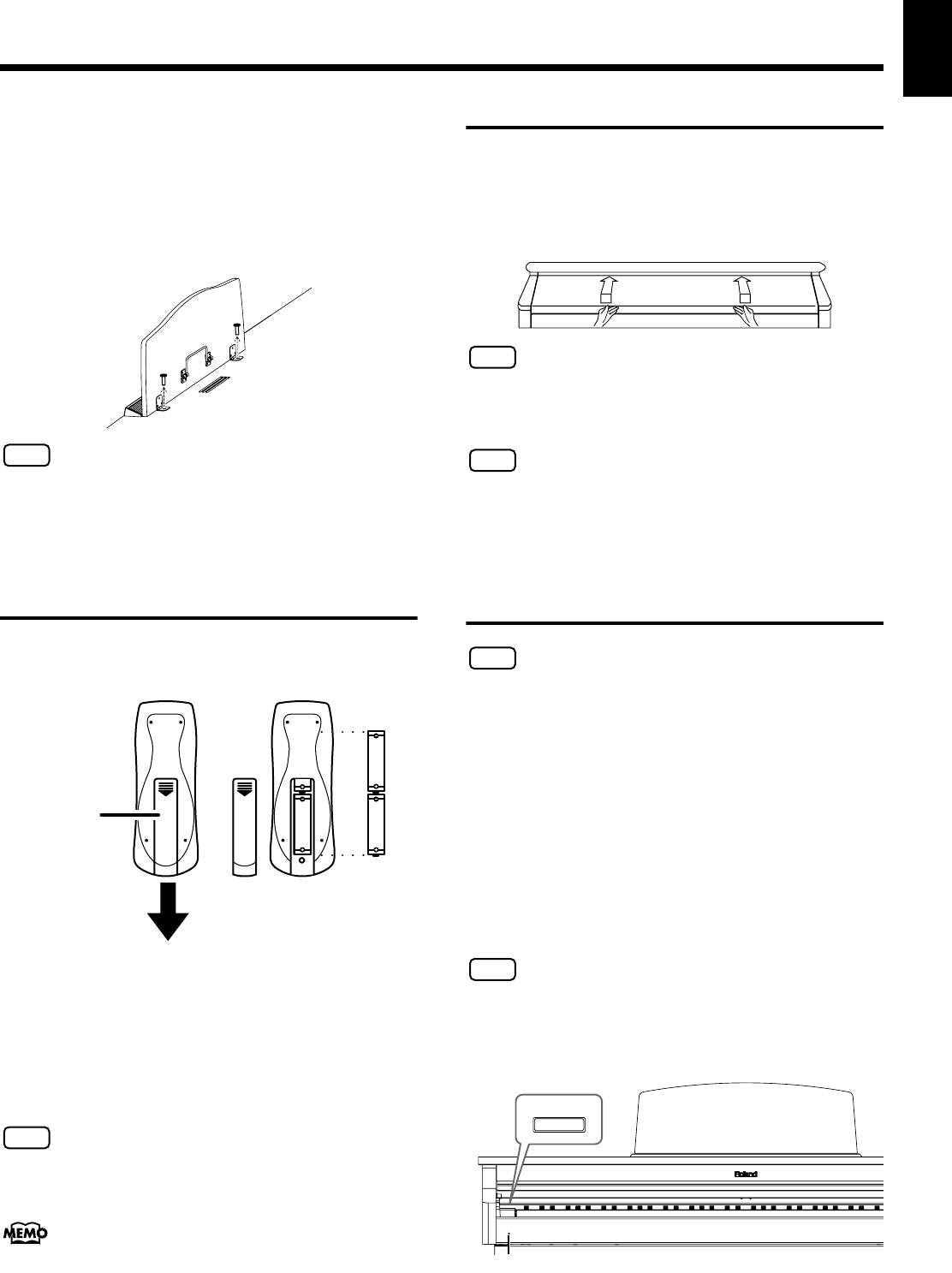
17
Before You Start Playing
Before You
Start Playing
■Removing the Music Rest
You can remove the music rest from the piano.
This allows you to place a notebook computer on the piano.
Position the music rest so it’s upright, then remove the
three screws, as shown.
You can remove the screws using a coin.
fig.mu_stand3
NOTE
Be careful not to lose the screws that you removed from the music
rest, or put them where they might be swallowed by small children.
Installing Batteries in the
Remote Control
Install the batteries provided in the remote control.
fig.Remote Control-1.j
1.
Open the battery cover on the back of the remote
control.
2.
Insert the supplied AA batteries, as shown in the figure
of remote control.
3.
Close the battery cover.
NOTE
Be careful to observe the correct polarity (+, - direction) when
installing the batteries.
For more information on the remote control button functions, refer
to “Using the Remote Control” (p. 70).
Opening/Closing the Lid
To open the lid, use both hands to lift it lightly, and
slide it away from yourself.
To close the lid, pull it gently toward yourself, and
lower it softly after it has been fully extended.
fig.00-05
NOTE
When opening and closing the lid, be careful not to let your fingers
get caught. If small children will be using the KR107, adult
supervision should be provided.
NOTE
If you need to move the piano, make sure the lid is closed first to
prevent accidents.
Turning the Power On and
Off
NOTE
Turn on power to your various devices in the order specified. By
turning on devices in the wrong order, you risk causing malfunction
and/or damage to speakers and other devices.
941
To turn the power on, turn the [Volume] knob all the
way down, and then press the [Power] switch.
The power will turn on, and the Power indicator at the
left front of the KR107 will light.
After a few seconds, you will be able to play the
keyboard to produce sound.
Use the [Volume] knob to adjust the volume.
NOTE
This unit is equipped with a protection circuit. A brief interval (a few
seconds) after power up is required before the unit will operate
normally.
942
fig.00-06.e
Remote
Control’s
Cover
Remote Control’s (Rear)
Power Indicator
Power
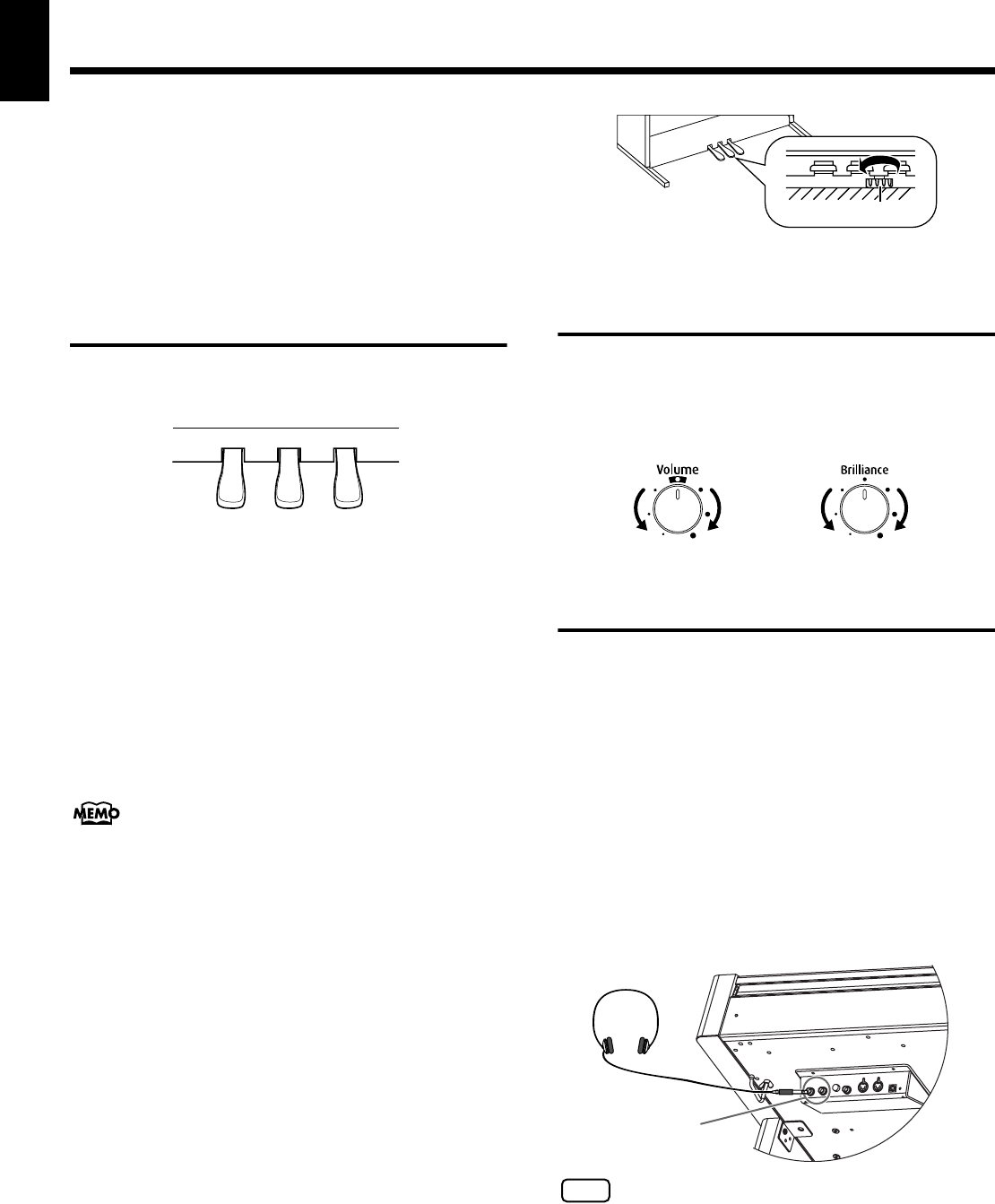
18
Before You Start Playing
Before You
Start Playing
To turn the power off, turn the [Volume] knob all the
way to the left, and press the [Power] switch.
The Power indicator at the left front of the KR107 will go
dark, and the power will be turned off.
945
• If you need to turn off the power completely, first turn off the
POWER switch, then unplug the power cord from the power
outlet. Refer to
Power Supply
(p. 6).
About the Pedals
The pedals have the following functions, and are used
mainly for piano performance.
fig.00-08.e
Damper pedal (right pedal)
While this pedal is pressed, notes will be sustained even after
you take your fingers off the keys.
On an acoustic piano, holding down the damper pedal will
allow the remaining strings to resonate in sympathy with the
sounds that you played from the keyboard, adding a rich
resonance.
The KR107 simulates this damper resonance.
You can change the amount of resonance applied with the damper
pedal. Please refer to “[Piano Designer] button” in the Quick Manual.
Sostenuto pedal (center pedal)
This pedal sustains only the sounds of the keys that were
already played when you pressed the pedal.
Soft pedal (left pedal)
When you hold down this pedal and play the keyboard, the
sound will have a softer tone.
The softness of the sound changes subtly depending on the
extent to which the pedal is depressed.
About the Adjuster
When you move the KR107 or if you feel that the pedals are
unstable, adjust the adjuster located below the pedals as
follows.
❍
Rotate the adjuster to lower it so that it is in firm contact
with the floor. If there is a gap between the pedals and
the floor, the pedals may be damaged. In particular
when placing the instrument on carpet, adjust this so
that the pedals firmly contact the floor.
fig.00-09.j
Adjusting the Sound’s
Volume and Brilliance
Turn the [Volume] knob to adjust the overall volume.
Turn the [Brilliance] knob to adjust the brightness of
the sound.
fig.00-07.e
Connecting Headphones
The KR107 has two jacks for plugging in headphones. This
allows two people to listen through headphones
simultaneously, making it very useful for lessons and when
performing piano pieces for four hands. Additionally, this
allows you to play without having to worry about bothering
others around you, even at night.
Plug the headphones into the Phones jack located at the
bottom left of the piano.
Connecting headphones will automatically mute the
sound from the internal speakers.
The headphone volume is adjusted by the [Volume]
knob of the KR107.
fig.00-04.e
NOTE
Use Stereo headphones.
Soft Pedal
Sostenuto Pedal
Damper Pedal
Adjuster
Min Max Mellow Bright
Phones jack x 2
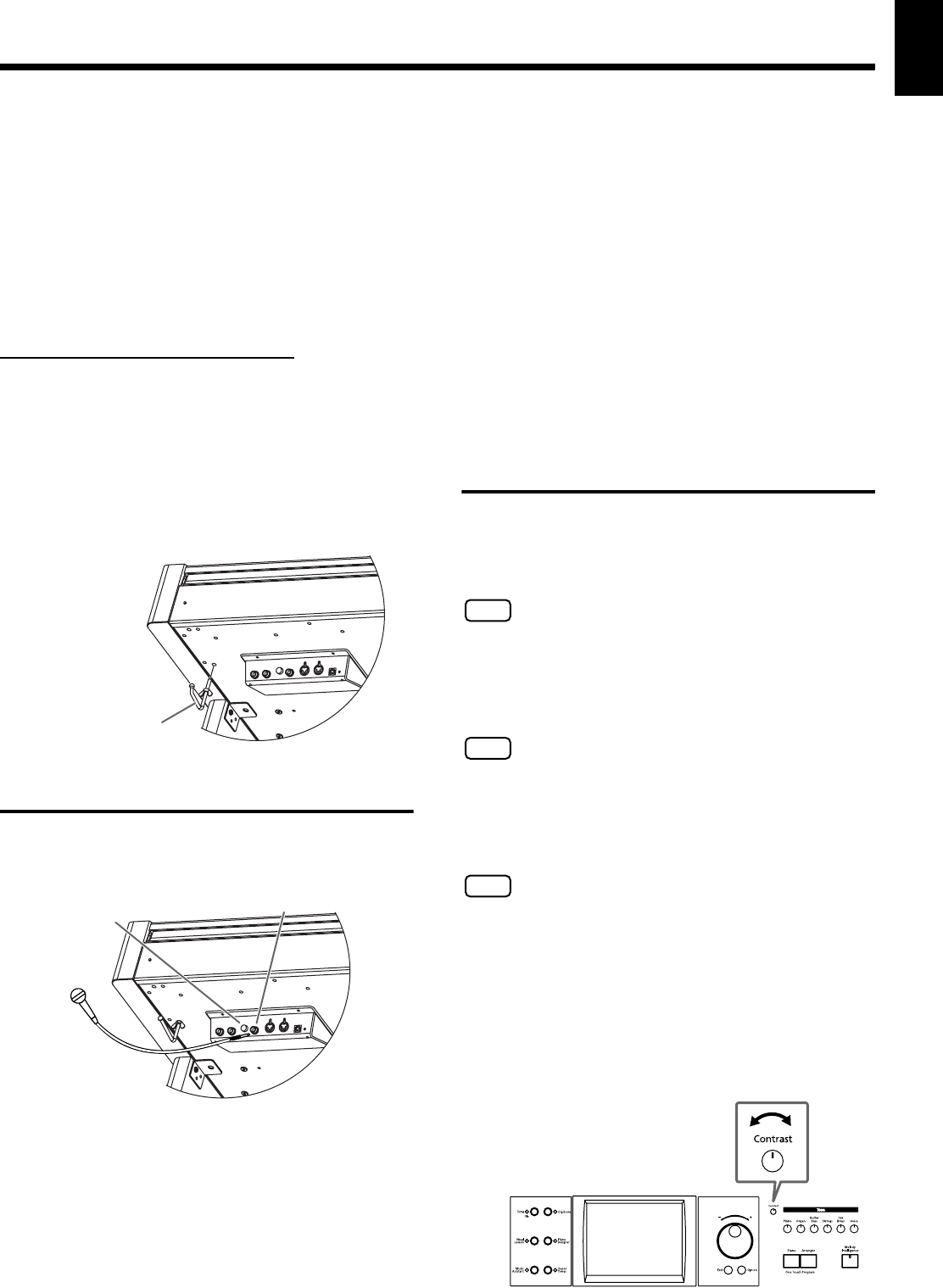
19
Before You Start Playing
Before You
Start Playing
Some Notes on Using Headphones
• To prevent damage to the cord, handle the headphones
only by the headset or the plug.
• Connecting the headphones when the volume of
connected equipment is turned up may result in damage
to the headphones. Lower the volume on the KR107
before plugging in the headphones.
• Listening at excessively high volume levels will not only
damage the headphones, but may also cause hearing
loss. Use the headphones at a moderate volume level.
Using the Headphone Hook
Whenever you are not using the headphones, you can hang them on
the headphone hook at the lower left of the KR107.
Attaching the Headphone Hook
Press and twist the headphone hook included with the KR107 into
the hole in the bottom of the KR107 (refer to the figure below).
Turn the headphone hook thumbscrew to secure the headphone
hook.
Connecting a Microphone
You can connect a microphone into the Mic In jack, and enjoy
karaoke with the KR107.
fig.00-10
1.
Connect a microphone (sold separately) to the Mic In
jack on the lower-left area of the instrument.
2.
Rotate the [Mic Volume] knob on left side of the Mic In
jack to adjust the volume level for the microphone.
Some Notes on Using a Microphone
• Be careful of high volume levels when using microphone
late at night or early in the morning.
• When connecting a microphone to the KR107, be sure to
lower the volume. If the volume control is too high when
the microphone is plugged in, noise may be produced by
the speakers.
• Howling could be produced depending on the location
of microphones relative to speakers. This can be
remedied by:
1. Changing the orientation of the microphone(s).
2. Relocating microphone(s) at a greater distance from
speakers.
3. Lowering volume levels.
983
About the Touch Screen
The KR makes use of a touch screen.
This lets you carry out a wide variety of actions just by
touching the screen lightly.
NOTE
The touch screen is operated by touching it lightly with your finger.
Pressing hard, or using a hard object can damage the touch screen.
Be careful not to press too hard, and be sure to use only your fingers
to operate the touch screen.
NOTE
The positioning of the touch screen may become displaced due to
changes in the surrounding environment and over time. If this
happens, follow the steps in “Calibrating the Touch Screen (Touch
Screen)” (p. 149) to correct the pointer position.
NOTE
Do not place items on the touch screen.
■
Adjusting the Contrast of the
Screen
To adjust the contrast of the screen, turn the Contrast
knob located at the right side of the screen.
Headphone Hook
Mic In jack
Mic Volume knob
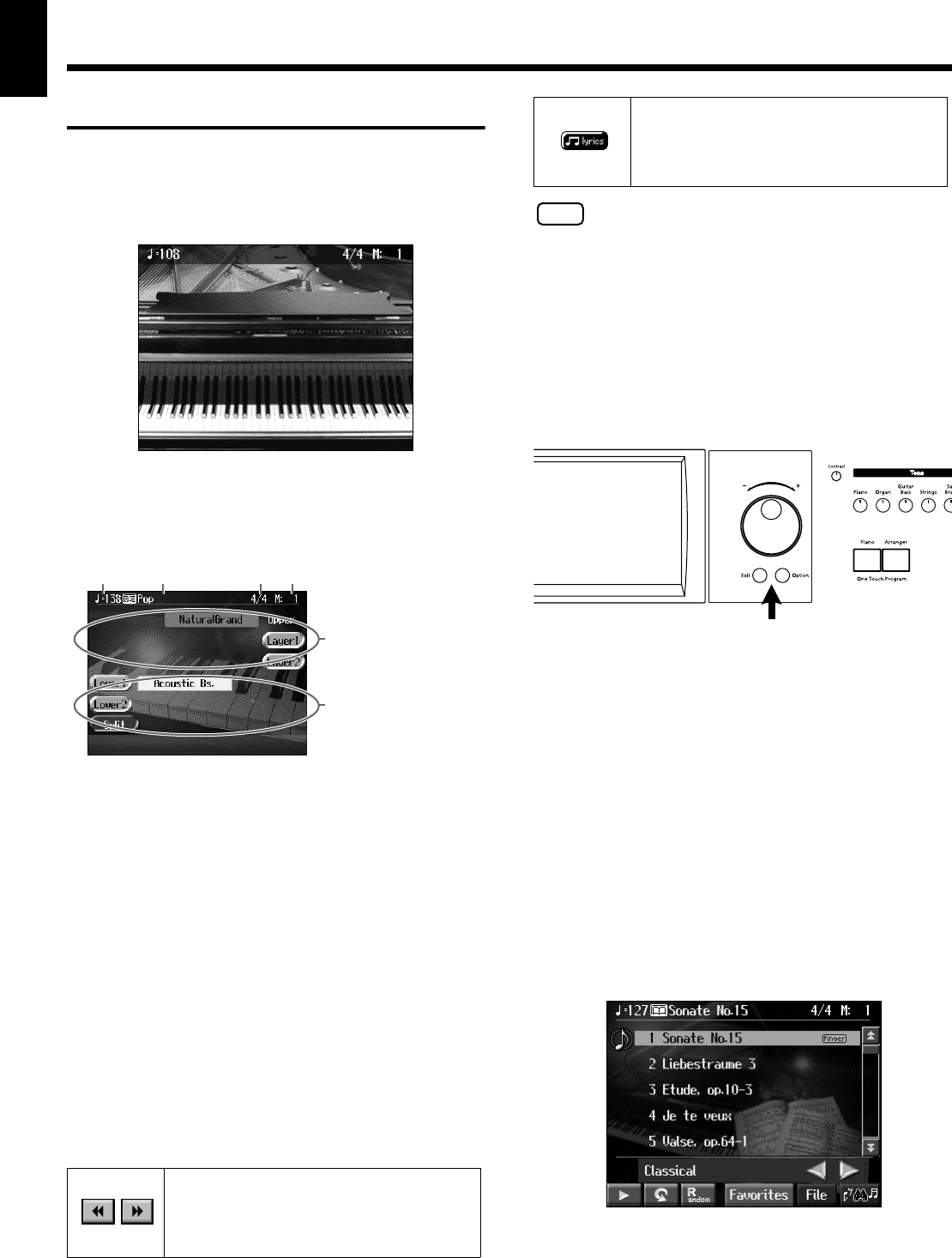
20
Before You Start Playing
Before You
Start Playing
Main Screens
■
Piano Screen
Immediately after the power is turned on, the Piano screen
like the one below is displayed. For details, refer to p. 21.
■
Basic Screen
The following screen is called Basic screen.
You can usually display this screen by pressing [Exit] button
several times.
Follow either of the procedures described below to display it.
• Press the One Touch Program [Arranger] button.
The Basic screen appears and the settings are made for
automatic accompaniment.
• Press the One Touch Program [Piano] button, then press
one of the Tone buttons, then press the [Exit] button.
■
Using the Main Icons
You can many other screens besides the Basic screen to do
things. The on-screen graphics that appear three dimensional
work like buttons. These are called “Icons.”
The main icons you can use on these screens are as follows.
NOTE
The explanations in this manual include illustrations that depict
what should typically be shown by the display. Note, however, that
your unit may incorporate a newer, enhanced version of the system
(e.g., includes newer sounds), so what you actually see in the display
may not always match what appears in the manual.
985
■
The [Option] Button and The
[Exit] Button
The [Option] Button
This displays a screen for advance function settings.
The screen that opens differs depending on the screen that
was displayed when the button was pressed.
The [Exit] button
Touch to cancel the settings currently being made and close
the screen displayed. Normally, pressing the [Exit] button
one or more times returns you to the Basic screen.
■
The Scroll Bar and The Page
Icon
The Song and Tone selection screens feature a scroll bar at
the right of the screen list, with page icons at the top and
bottom of the scroll bar.
Touch the scroll bar and drag up and down to scroll through
the list.
Touch the page icons to change pages.
Some screens consist on two or more pages.
You can display the next page or the
previous page of the screen by touching
these icons.
Tempo
Song name or
Music Style name Beat Measure
These information are
displayed, when you use the
automatic accompaniment.
The Tone names are
selected appear.
When you select an internal song or music
files that includes the lyrics data, this icon
appears in the Piano screen or Basic screen.
Touch this to display the lyrics.
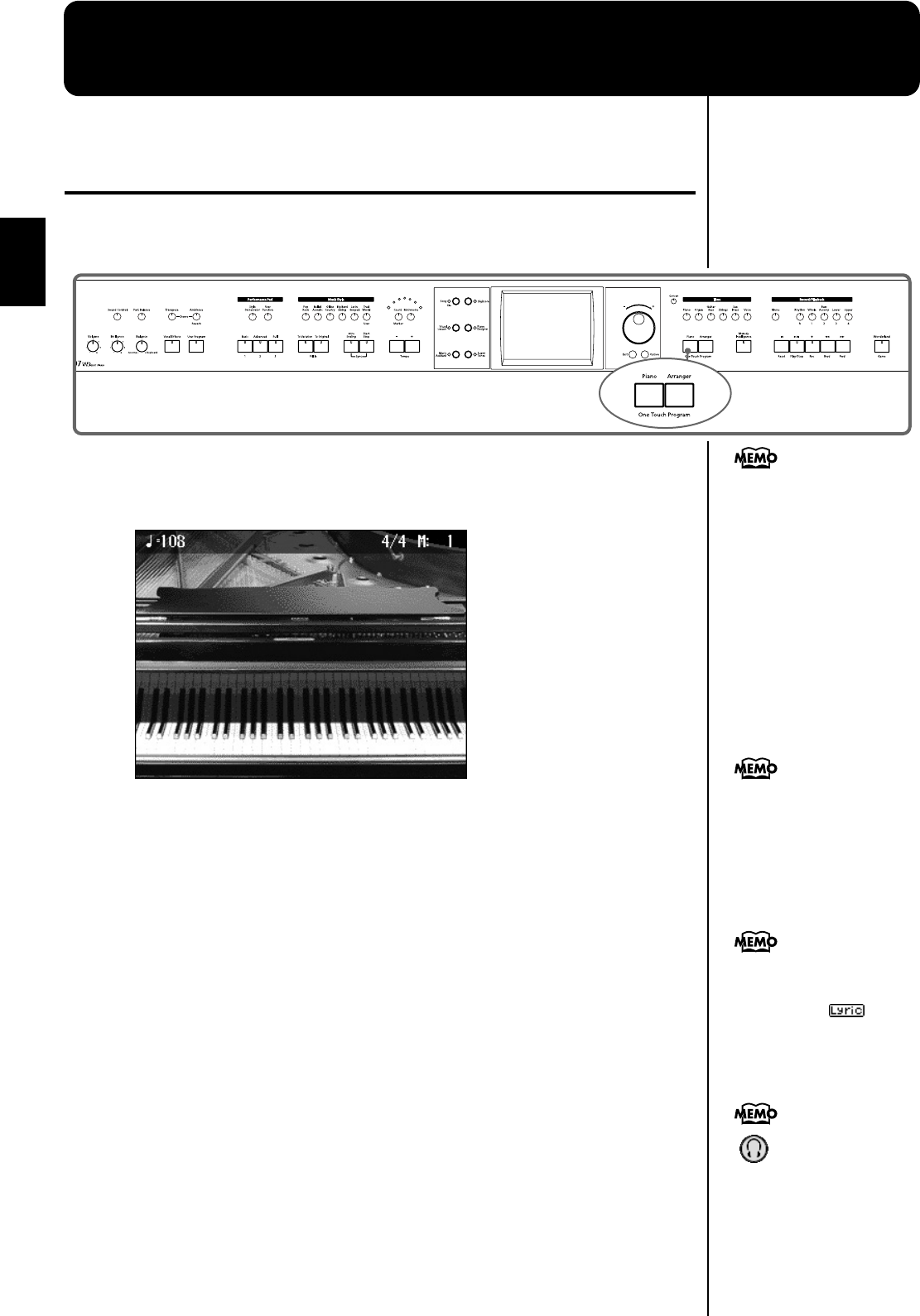
21
Chapter 1
Chapter 1 Performance
Playing the Keyboard Like a Piano
(One-Touch Piano)
You can create the optimal settings for a piano performance with the press of a single
button.
fig.panel1-1
1.
Press the One Touch Program [Piano] button.
A “Piano screen” like the one shown below will appear.
fig.d-piano.eps_60
When you press the One Touch Program [Piano] button, the KR will switch to the
following settings, regardless of the current panel settings.
• If the keyboard has been split into upper and lower sections (p. 26), the
keyboard returns to a single section.
• The pedals return to their usual functions (p. 18).
• The Grand Piano sound is automatically selected.
• The effect is automatically set to “Damper Resonance” (p. 35).
You can change the piano
performance settings by
touching the [Piano Designer]
b
utton. For more details, refer
to “[Piano Designer] Button”
in the Quick Start.
When you select an internal
song or music file that includes
the lyrics data, < >
appears in the Piano screen or
Basic screen. Touch this to
display the lyrics.
< > appears in the Piano
screen or Basic screen when
headphones are connected.
You can add three-
dimensional breadth to the
sound from the headphones
(p. 30).
Since this instrument faithfully
reproduces real acoustic piano
action and response, keys
played in the top one-and-one-
half-octave range continue to
resonate, regardless of the
damper pedal action, and the
tone in this range is audibly
different. The Key Transpose
setting (p. 87) can also be used
to change the range that is
unaffected by the damper
pedal.
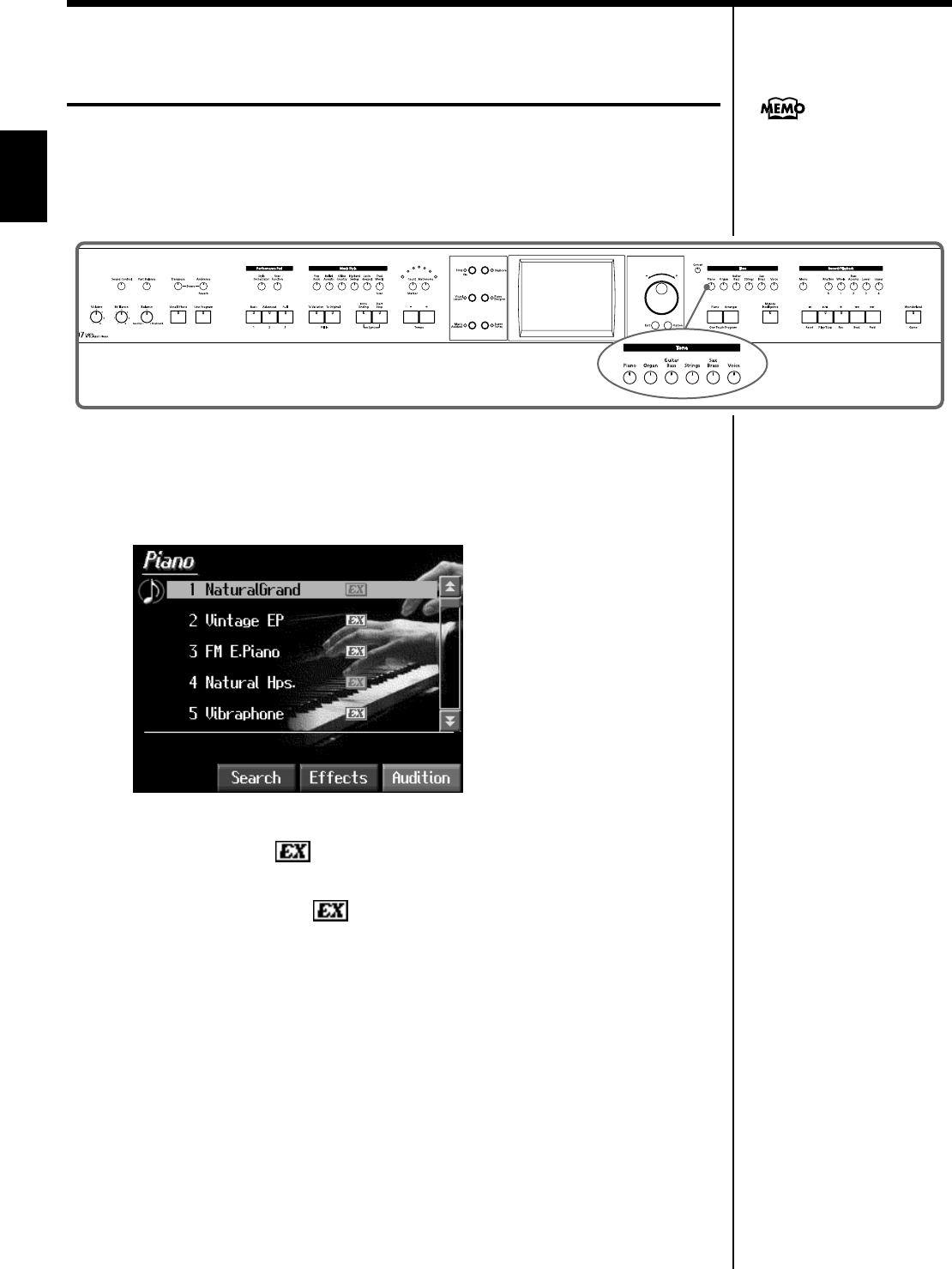
22
Chapter 1 Performance
Chapter 1
Performing with a Variety of Tones
(Tone Buttons)
The KR comes with a many built-in instrument sounds and effects. This lets you
enjoy perform in a wide range of musical styles.
The built-in sounds are called “Tones.” The sounds are organized into six tone
groups, which are assigned to the [Tone] buttons.
fig.panel1-2
1.
Press any one of the Tone buttons to select a tone group.
You’ll see that button’s indicator light up.
The screen displays the tone names included in the tone group you’ve selected.
fig.d-tonesel.eps_60
This screen is called the “Tone selection screen.”
Tones indicated by is called an “EX voice.” These voices are especially
recommended.
Tones indicated by a red mark produce the “Key Off Sound.”
What “Key Off Sound” does is recreate the tonal changes produced when the fingers
are released from the keys.
Tones indicated by “GS” is GS tones.
Touch and drag up and down in the scroll bar to scroll through the screen and
display other tones.
Touch the page icons to change pages.
You can touch <Audition> for an audio demonstration of a particular tone.
You can touch <Effects> to add effect sounds to a variety of tones (p. 35).
You can touch <Search> to find tones according to the search criteria you specify
(p. 24).
For more about the names of
Tones, take a look at the “Tone
List” (p. 170).
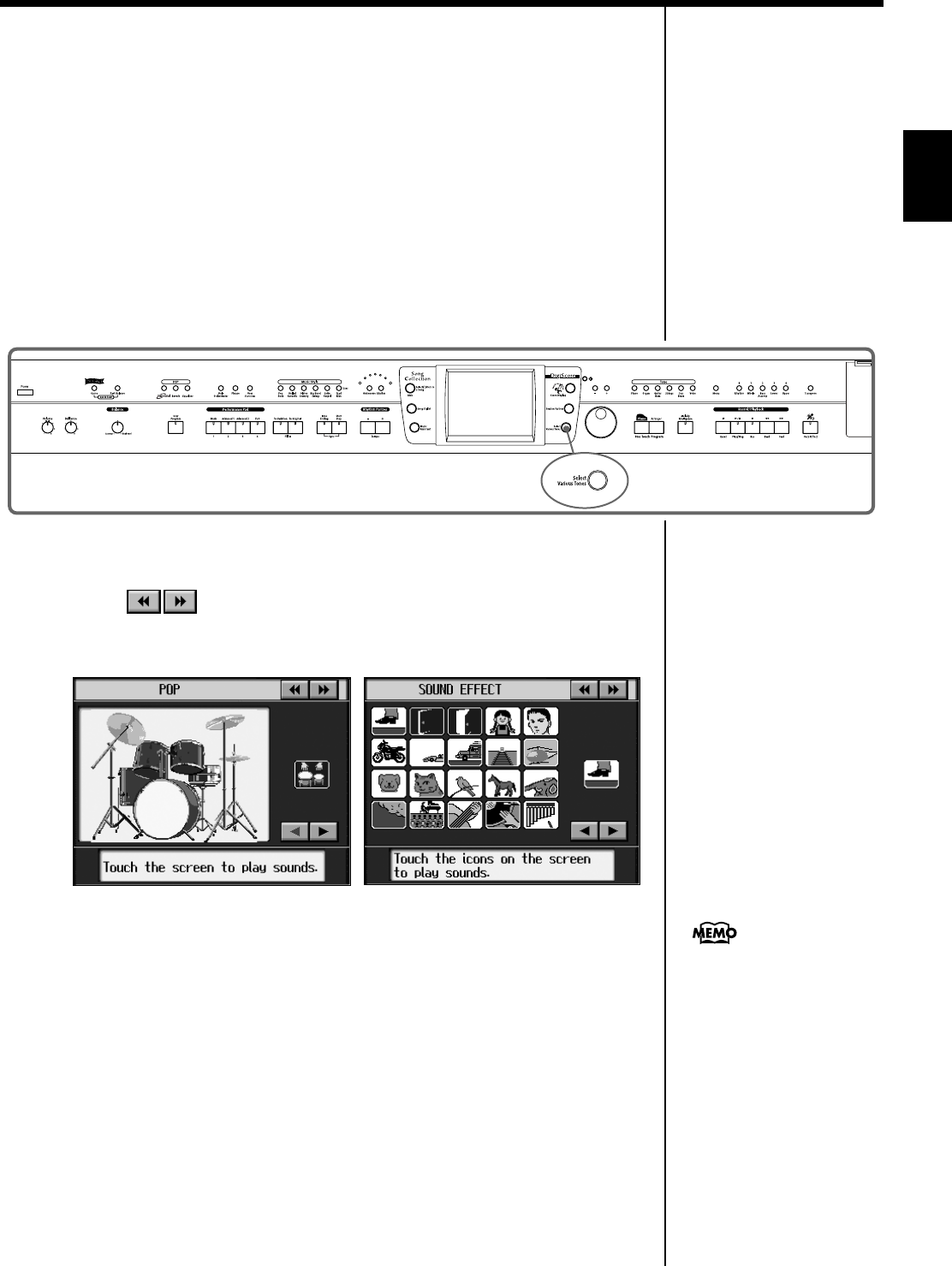
23
Chapter 1 Performance
Chapter 1
2. Touch a tone name to select the tone.
You’ll hear the tone you’ve selected when you play the keyboard.
You can use the dial to scroll through the screen as you switch the Tones to be
played.
3. Press the [Exit] button.
This returns you to the Basic screen or the previous screen.
■Playing Percussion Instruments or Sound Effects
You can use the keyboard to play percussion sounds or effects like sirens and animal
sounds.
fig.panel1-2
1. Press the [Super Tones] button and watch the indicator light up.
2. Touch several times to display the “Drums” screen or the
“SFX” screen.
fig.d-drum.eps_60
Each note of the keyboard will play a different sound.
You can also have play sounds by touching the screen.
You can select other drum tones and effect sounds by pressing the < < > or < > >
buttons.
3. Press the [Exit] button several times.
This returns you to the Basic screen or the previous screen.
The combination of sounds
assigned to the keyboard
varies according to the drum
set. Take a look at the “Drum
Set List” (p. 172) and “SFX Set
List” (p. 177).
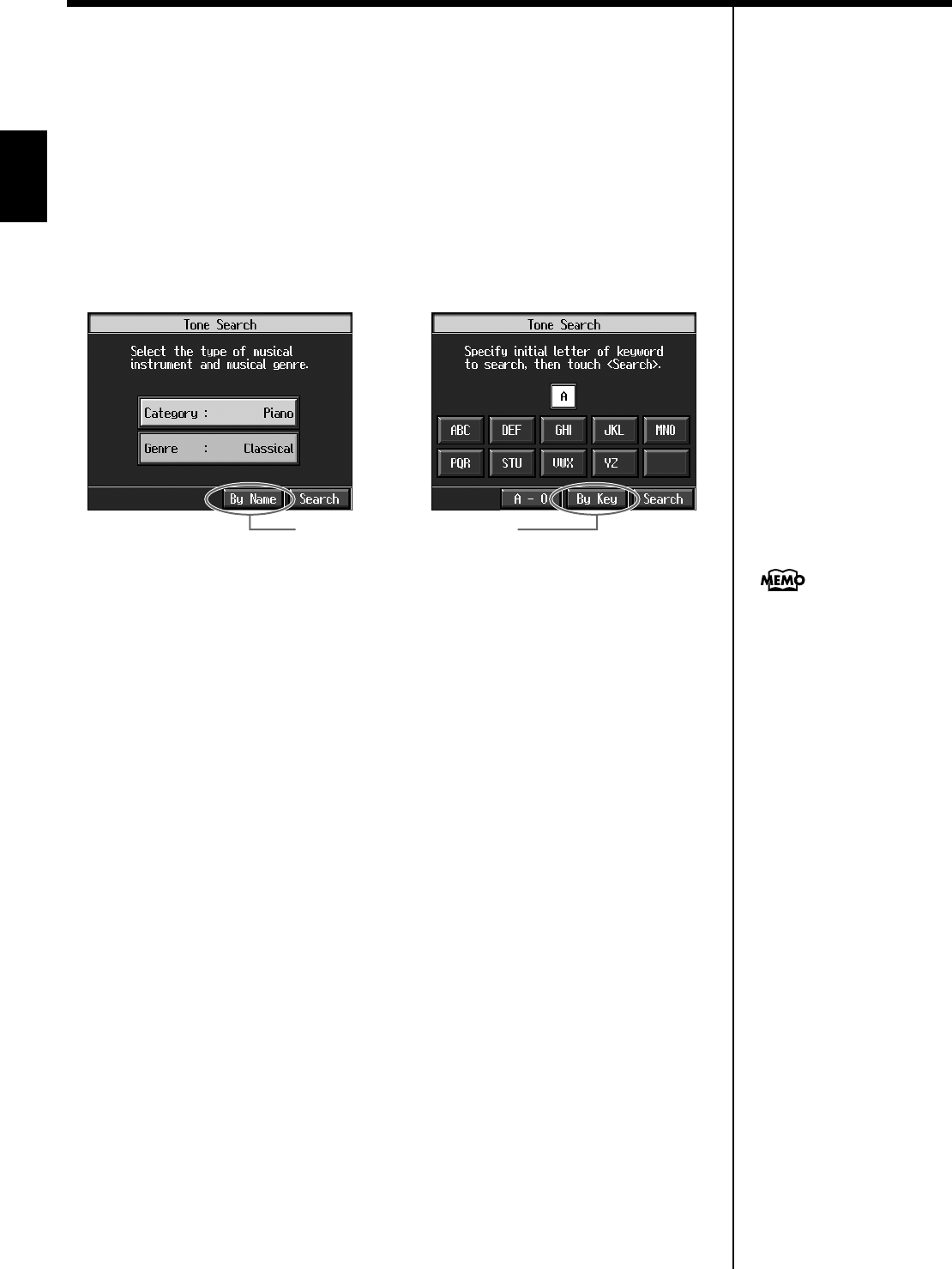
24
Chapter 1 Performance
Chapter 1
■Using Keywords to Search for Tones (Tone Search)
You can search for tones that match the conditions you set for instrument or musical
style. You can also search the tones using the first character of the tone name.
1. Press any Tone button.
The tone selection screen appears.
2. Touch <Search>.
The following “Tone search screen” appears.
fig.d-tonesrch1.eps_60
Searching by Conditions
3. Touch <Category> or <Genre>, then use the dial to select the search
conditions.
4. Touch <Search>.
The search results appear in the display.
Touch the tone name to select the tone.
Press the [Exit] button to return to the tone search screen.
Searching by Tone Name
3Touch <By Name>.
Touch <By Key> to go to the condition search screen.
4. Decide which character is to be used for the search.
The selected character appears in the middle of the screen.
Enter the character you’re searching for. For example, touching <ABC> in succession
cycles you through the available choices in that character group (“A”→”B”→”C”...).
Touching <A-0> selects the type of character. Each time you touch <A-0>, the
character switches between alphabets and numerals.
5. Touch <Search>.
The search results appear in the display.
Touch the tone name to select the Tone.
Press the [Exit] button several times to return to the Basic screen or the previous
screen.
Condition Search screen Name Search screen
Touch here to switch these screens.
In condition search, tones
satisfying all of the selected
search criteria are sought.
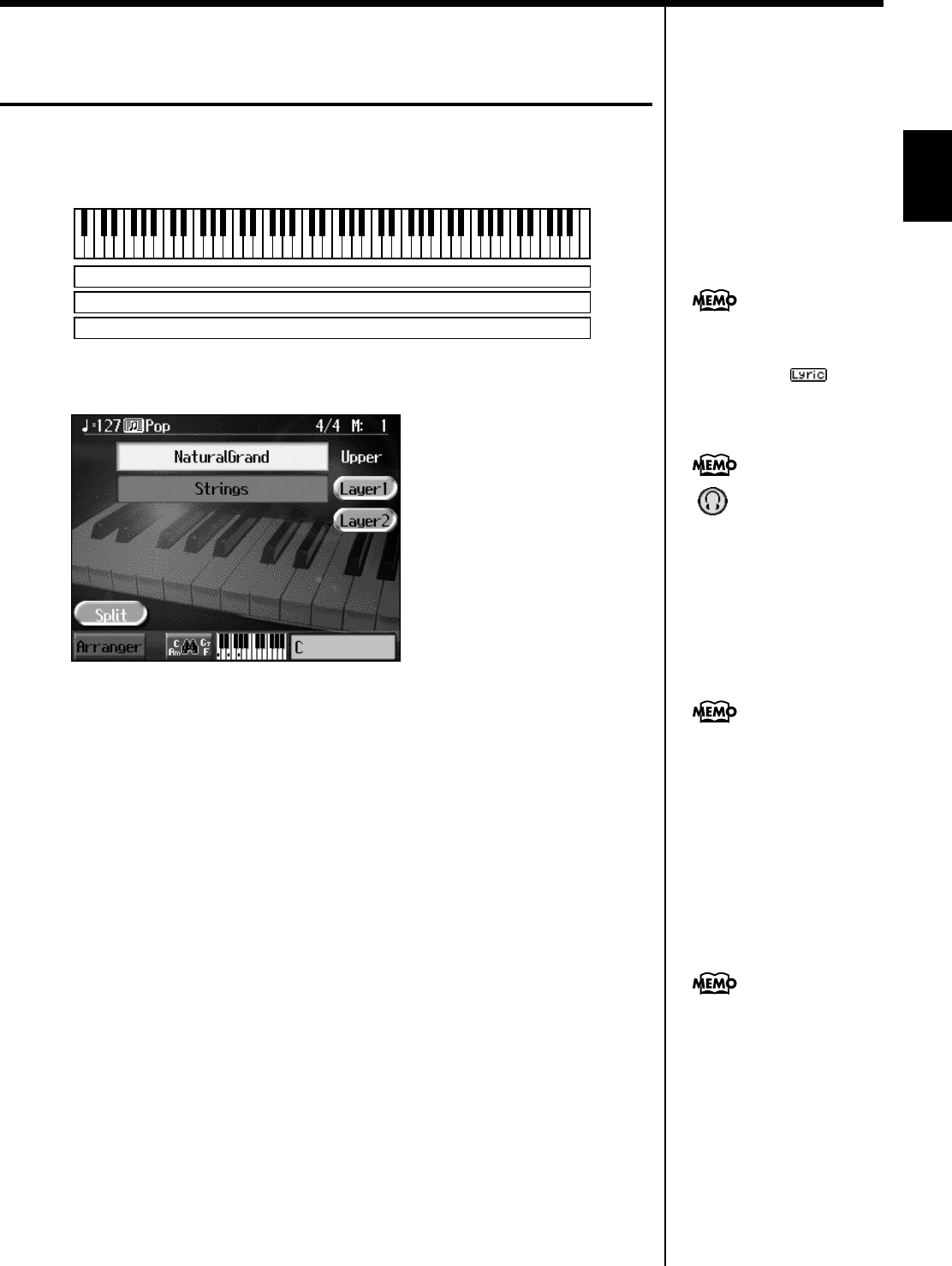
25
Chapter 1 Performance
Chapter 1
Performing with Multiple Sounds
Layered Together (Layer)
Two tones sounding together when you press a single key is referred to as a “layer
performance.”
For instance, it’s possible to play the Tones for both Piano and Strings simultaneously.
fig.layer.e
1. Touch <Layer 1> at the bottom of the Basic screen.
fig.d-layer.eps_60
The tone that was sounding before you switched to layer performance, plus the tone
indicated in the lower part of the display, are now played together.
Here, the tone appearing in the upper part of the display is called the “right-hand
tone,” and the tone appearing in the lower part of the display is called the “layer
tone.”
In the same manner, you can touch <Layer 2> to layer further sounds.
Changing the tones
2. Touch the name of the tone to be changed.
Touch here to highlight the tone name.
3. Press a Tone button to select the new tone (p. 22).
4. When you have selected the tone, press the [Exit] button.
The display returns to the Basic screen.
Cancelling the Layer
5. Touch <Layer 1>.
Touch <Layer 2> to have <Layer 2> play as well.
The <Layer 1> and <Layer 2> icons are dimmed, and the Layer performance is
cancelled.
Now when you play the keys, only the tone indicated on the screen is sounded.
Grand Piano 1
Strings 1
Strings 2 When you select an internal
song or music file that includes
the lyrics data, < >
appears in the Basic screen.
Touch this to display the lyrics.
< > appears in the Piano
screen or Basic screen when
headphones are connected.
You can add three-
dimensional breadth to the
sound from the headphones
(p. 30).
When you touch Octave
<-><+> on the tone selection
screen, the pitch of the
keyboard’s sound is changed
in octave units. To learn more,
see “Shifting the Keyboard
Pitch in Octave Steps (Octave
Shift)” (p. 27).
You can change the balance of
the right-hand and Layer Tone
volume. For instructions, see
“Adjusting the Volume
Balance for Each Performance
Part (Part Balance)” (p. 62).
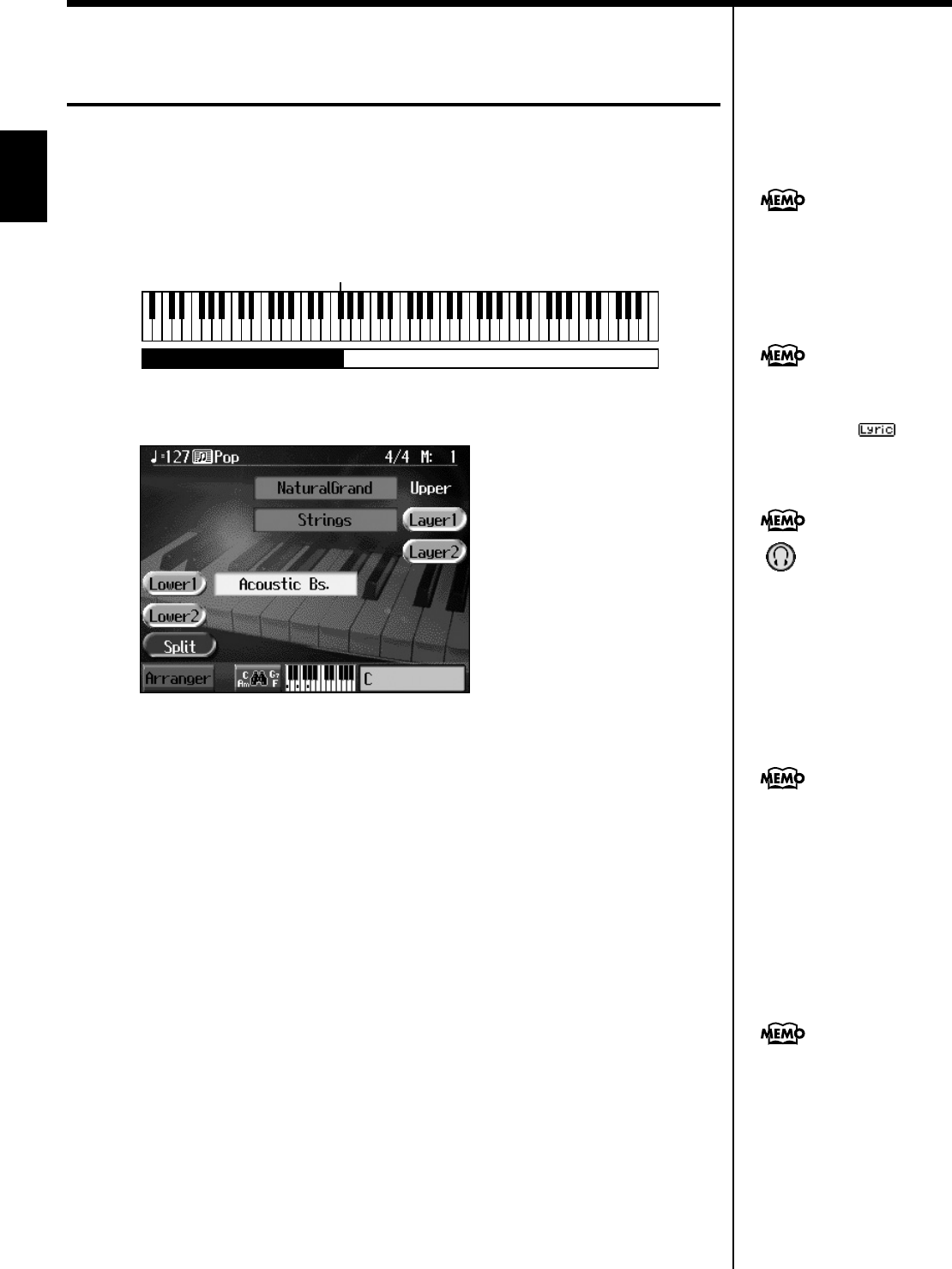
26
Chapter 1 Performance
Chapter 1
Playing Different Tones with the Left
and Right Hands (Split)
Dividing the keyboard into right-hand and left-hand areas, then playing different
sounds in each section is called “split performance.” The boundary key is called the
“split point.”
The split point key is included in the left-hand keyboard area. Each time power to
the keyboard is turned on, the split point is reset to “F#3.”
fig.split.e
1. At the Basic screen, touch <Split>.
fig.d-split.eps_60
The tone sounding prior to the split performance is played in the right-hand section
of the keyboard, and the tone indicated at the left of the screen is played in the left-
hand section of the keyboard.
Here, the tone appearing at the right part of the display is called the “right-hand
tone,” and the tone appearing at the left part of the display is called the “left-hand
tone.”
Changing the Tones
2. Touch the name of the tone to be changed.
3. Press a Tone button to select the tone (p. 22).
4. When you have selected the tone, press the [Exit] button.
The display returns to the Basic screen.
Cancelling the Split
5. Touch <Split>.
+++++++++++++++++++++.
When you play the keys, only the tone indicated on the screen is sounded.
Split Point
Grand Piano 1Acoustic Bass
You can change the split point;
refer to “Changing the
Keyboard’s Split Point (Split
Point)” (p. 138).
When you select an internal
song or music file that includes
the lyrics data, < >
appears in the Basic screen.
Touch this to display the lyrics.
< > appears in the Piano
screen or Basic screen when
headphones are connected.
You can add three-
dimensional breadth to the
sound from the headphones
(p. 30).
When you touch Octave
<-><+> in the tone selection
screen, the pitch of the
keyboard’s sound is changed
in octave units. To learn more,
see “Shifting the Keyboard
Pitch in Octave Steps (Octave
Shift)” (p. 27).
You can change the volume
b
alance between the left- and
right-hand parts of the
keyboard; refer to “Adjusting
the Volume Balance for Each
Performance Part (Part
Balance)” (p. 62).
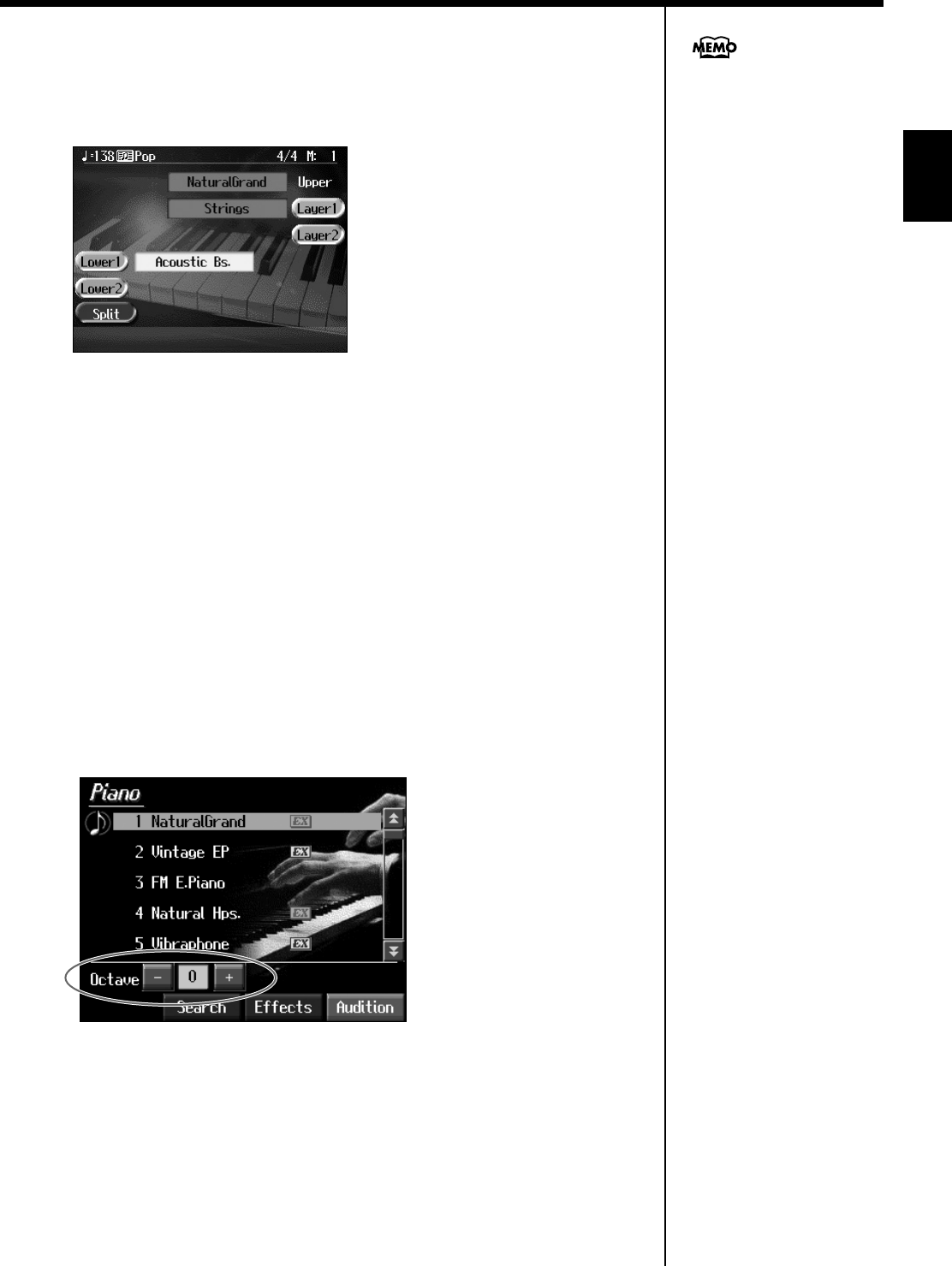
27
Chapter 1 Performance
Chapter 1
Turning On Layer and Split Performance Simultaneously
Turning on either Layer Performance or Split Performance allows you to divide the
keyboard into a right-hand and a left-hand part and play with two Tones layered in
the right-hand part.
fig.d-layersplit.eps_60
■Shifting the Keyboard Pitch in Octave Steps
(Octave Shift)
When using layer performance (p. 25) or split performance (p. 26), you can change
the pitch of the keyboard’s sound in octave units. This function is called “Octave
Shift.”
For example, when using a layer performance, you can change the pitch of each
sound and layer the sounds. You can make the pitch of the keyboard’s left-hand part
match the pitch of the right-hand part during split performance.
1. On the Basic screen, touch <Layer> or <Split>.
The KR switches to layer performance or split performance.
2. To apply Octave Shift, touch the name of the tone you’ve selected.
3. Press the Tone button to display the Tone selection screen.
fig.d-octshift.eps_60
4. Touch Octave <-> or <+> in the lower part of the screen to adjust the
pitch of the sound.
Each time you touch <+>, the pitch is raised one octave.
Each time you touch <->, the pitch is lowered one octave.
The sound can be changed from two octaves lower than the original sound (-2) to
two octaves above the original (+2).
Press the [Exit] button to return to the Basic screen or the previous screen.
When the keyboard has been
divided into upper and lower
sections, the damper pedal is
applied to only the upper
section. If you want to add
lingering reverberations to the
notes of the lower section, see
“Assigning Functions to
Pedals and Performance Pads
(Pedal Setting/User
Functions)” (p. 142).
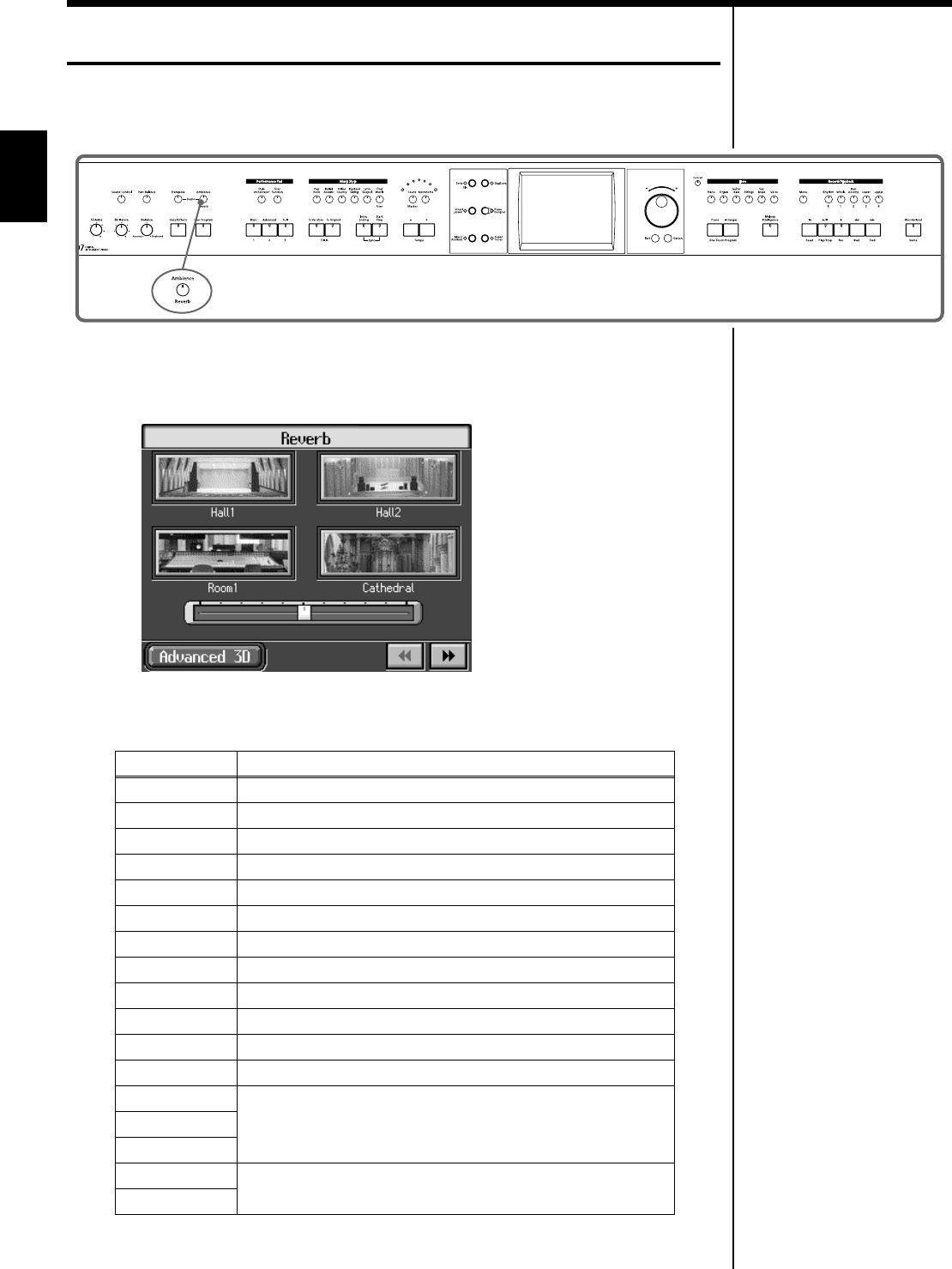
28
Chapter 1 Performance
Chapter 1
Adding Reverberation to the Sound (Reverb)
Apply a reverb effect to the notes you play with the KR.
Reverb makes it sound as if you are playing in a concert hall.
fig.panel1-3
1. Press the [Ambience/Reverb] button and watch the its indicator light up.
A “Reverb screen” like the one shown below appears.
fig.d-reverb.eps_60
2. Touch an icon to select the performance space.
;
Display Explanation
Hall 1 Hall with bright reverberation
Hall 2 Hall with warm reverberation
Room 1 Room reverberation
Cathedral High-ceilinged cathedral
Ground Wide open space with no reverberations
Room 2 Small room
Lounge Larger room
Studio A recording studio
Gymnasium In a gymnasium
Hall 3 Large concert hall reverberation
Dome A domed ballpark
Cave Adds the extended reverberations found inside a cave
GS Room 1
Reproduces an indoor-type reverb.
Provides a clear, expansive reverberation.
GS Room 2
GS Room 3
GS Hall 1 Reproduces the reverberation found in a hall. Gives
reverberation with a greater sense of depth than GS Room.
GS Hall 2
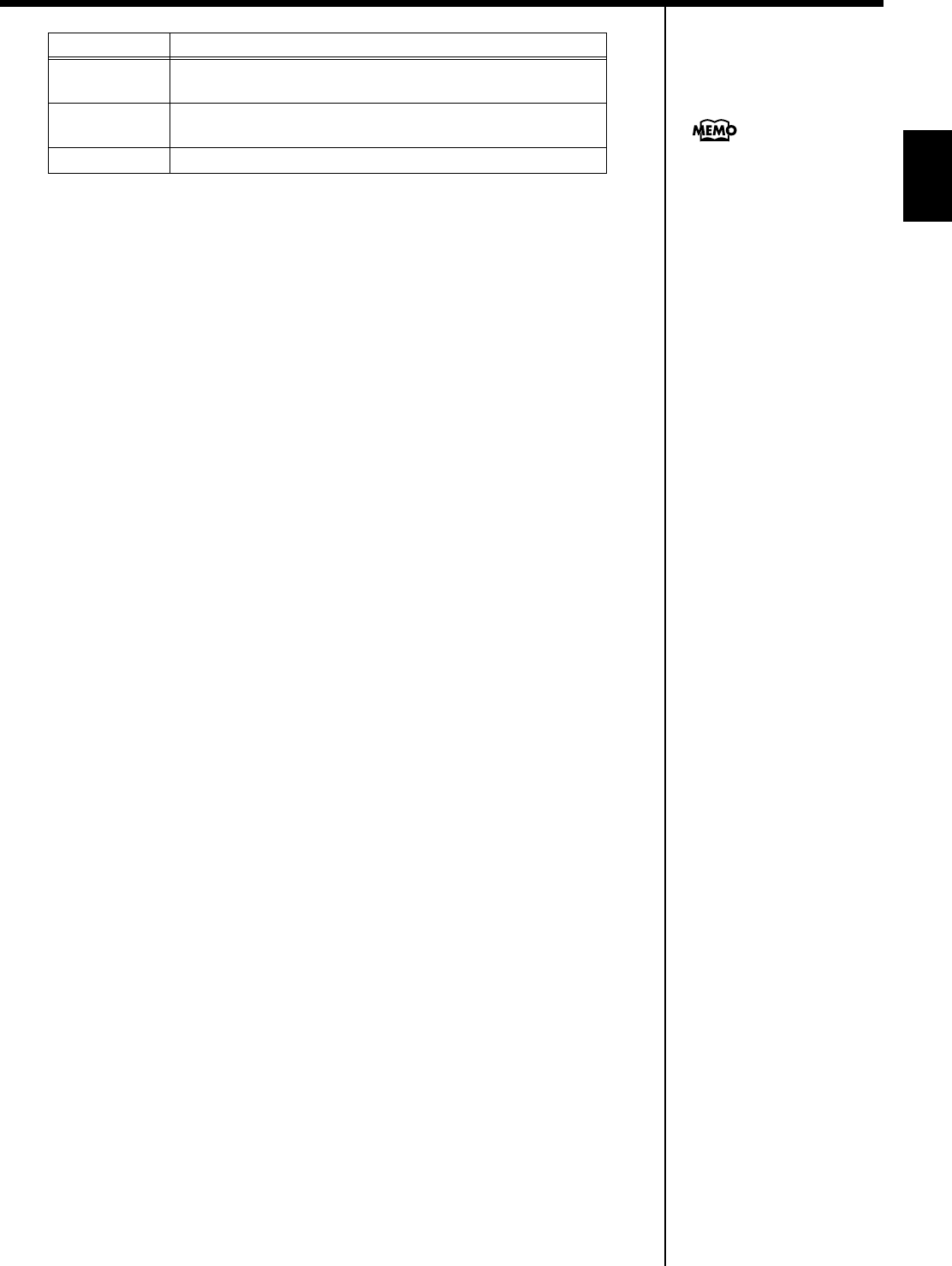
29
Chapter 1 Performance
Chapter 1
3. Touch the slider beneath the icons to adjust the effect selected.
Touch and slide the knob on the screen to the right for a deeper reverb, and to the
left for less.
You can also move the slider with the dial.
When you press the [Exit] button, the reverb effect is activated, and you return to the
previous screen.
Cancelling the Effect
4. Press the [Ambience/Reverb] button, and watch the indicator light go
out.
The reverb effect is eliminated.
GS Plate Reproduces a plate echo (reverberation created using the
vibrations of a metal plate).
GS Delay A delayed sound that is added to the original, similar to the
reflected sounds of mountain echoes.
GS Pan Delay The reflected sounds are panned (shifted) laterally.
Display Explanation
No effect is applied when the
slider is moved all the way to
the left. In this case, the
b
utton’s indicator won’t light
up when you press the
[Ambience/Reverb] button.
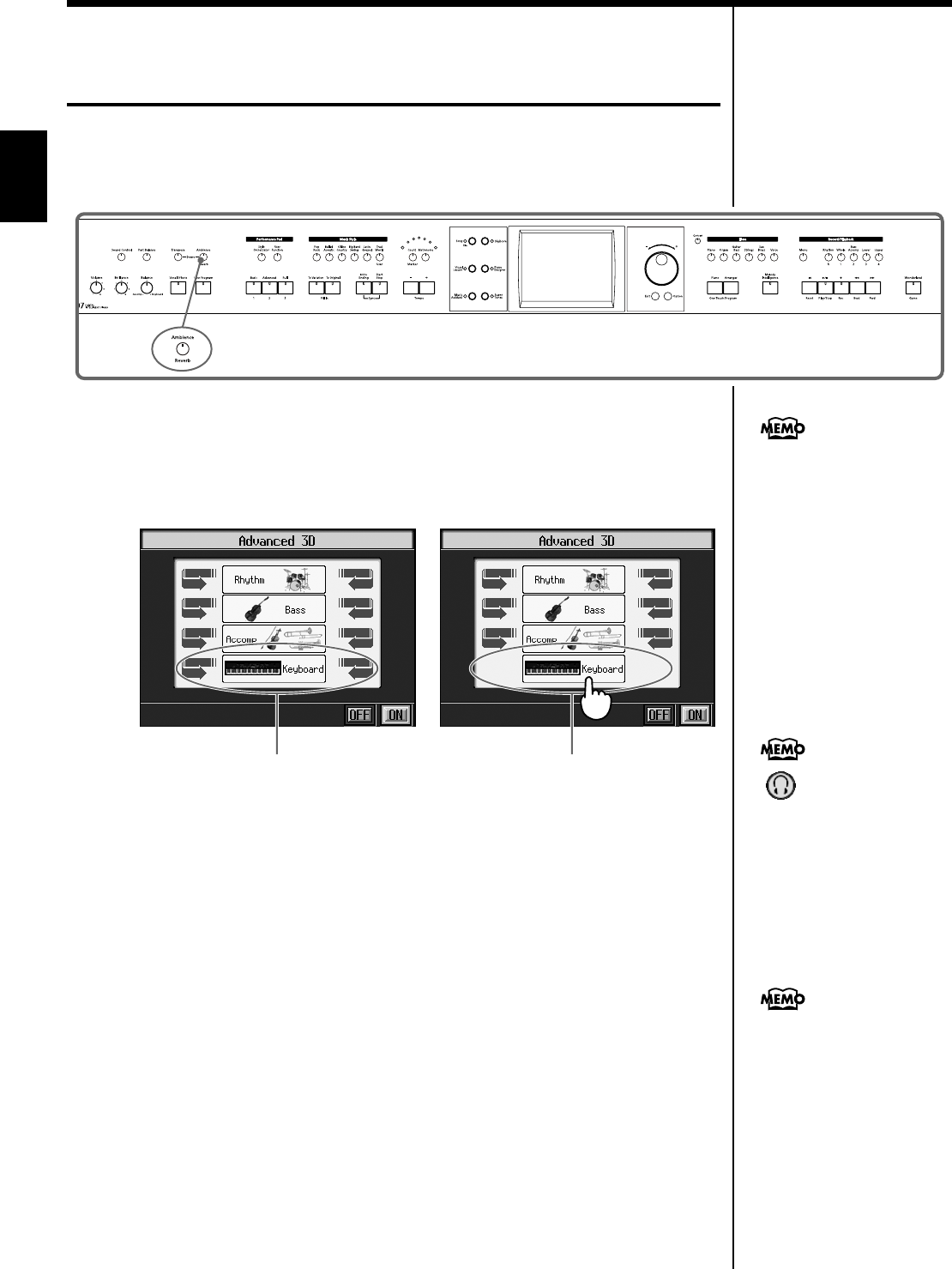
30
Chapter 1 Performance
Chapter 1
Adding Three-Dimensional Breadth to
the Sounds You Play (Advanced 3D)
You can add three-dimensional breadth to the sounds you play with automatic
accompaniment (p. 46), or to internal songs or music files. With this effect, called
“Advanced 3D,” you seem to be surrounded by the sound of the performance.
fig.panel1-4
1. Press the [Ambience/Reverb] button and watch the indicator light up.
2. Touch <Advanced 3D>.
The following “Advanced 3D screen” appears.
fig.d-adv3d.eps_60
3. Touch <ON>.
Three-dimensional breadth is added to the sound.
4. Touch the icon to switch the effect on or off for each individual part.
When you press the [Exit] button, the Advanced 3D effect is activated, and you
return to the previous screen.
Cancelling the Effect
5. Touch <OFF>.
The Advanced 3D effect is eliminated, and the effect is no longer applied to any of
the parts.
<*** > appears in the Piano
screen or Basic screen when
headphones are connected.
You can add three-
dimensional breadth to the
sound from the headphones
(p. 30).
OFF
ON
< > appears in the Piano
screen or Basic screen when
headphones are connected.
You can add three-
dimensional breadth to the
sound from the headphones
(p. 30).
The Advanced 3D effect is not
applied, even when you touch
<On>, if all parts are turned
off.
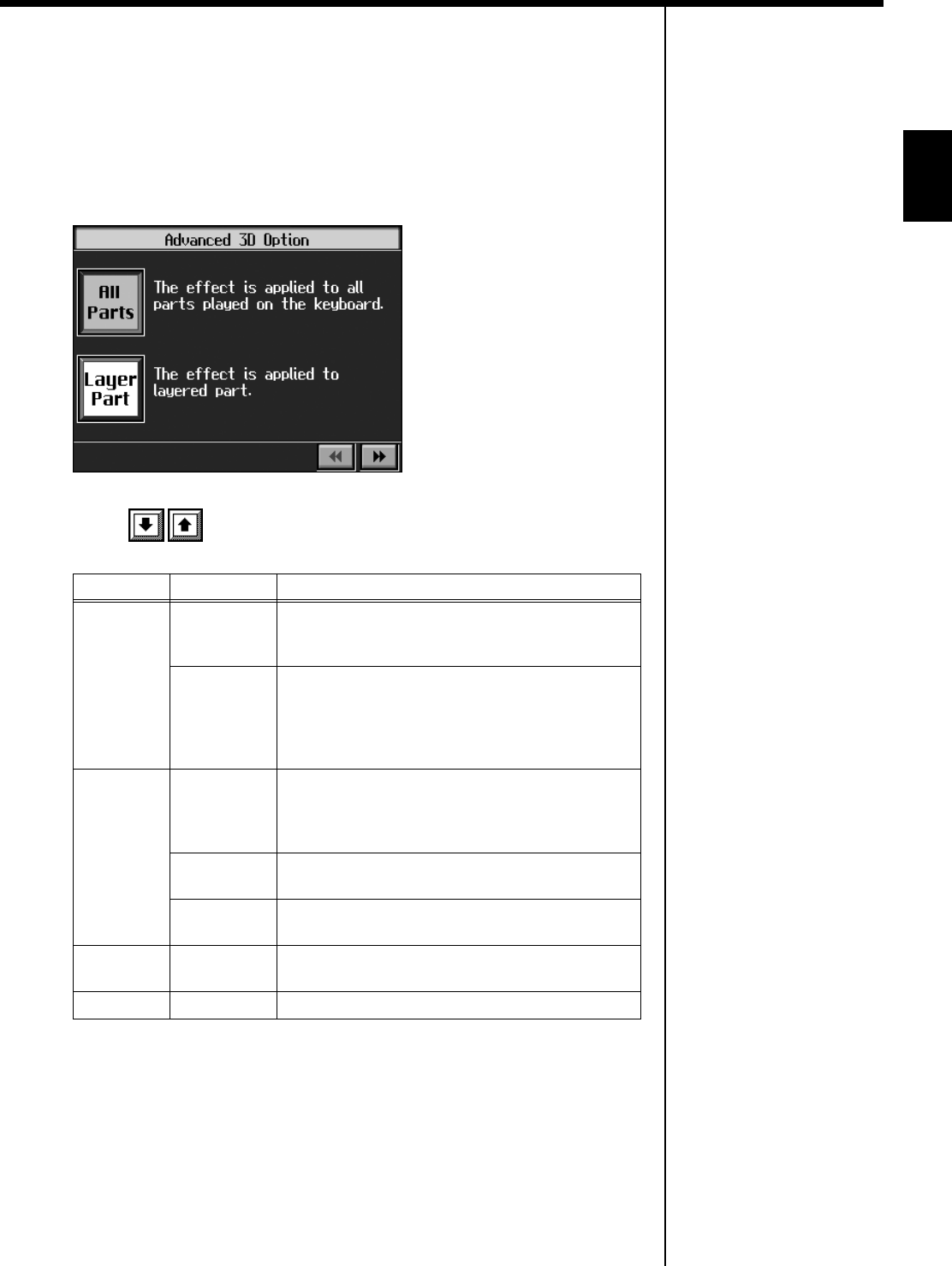
31
Chapter 1 Performance
Chapter 1
❍Making Detailed Settings for Advanced 3D
1. Press the [Ambience/Reverb] button and watch the indicator light up.
2. Touch <Advanced 3D>.
3. On the Advanced 3D screen, press the [Option] button.
fig.d-adv3dopt.eps_60
4. Touch for the parameter being set to select the value.
You can also change the value with the dial.
5. When you press the [Exit] button, you return to the Advanced 3D screen.
Parameter Display Explanation
Part
All Parts
The effect is applied to all tones played with the
keyboard (the left-hand tone, right-hand tone, and
layer tone).
Layer Part
The effect is applied only to the layer part.
When not using a layer performance (p. 25), the
Advanced 3D effect is not applied to the keyboard
performance, even if <Keyboard> on the Advance
3D screen is set to On.
Mode
Auto
This selects settings that are adjusted for use with
headphones when headphones are connected.
When no headphones are connected, settings
adjusted for speakers are selected.
Speaker Settings adjusted for listening to sounds through
speakers are selected.
Headphone Settings adjusted for listening to sounds through
headphones are selected.
Depth 1–4 Changes the apparent depth of the sound. The
effect is applied more as the value is increased.
Width ON, OFF Changes the breadth of the sound.
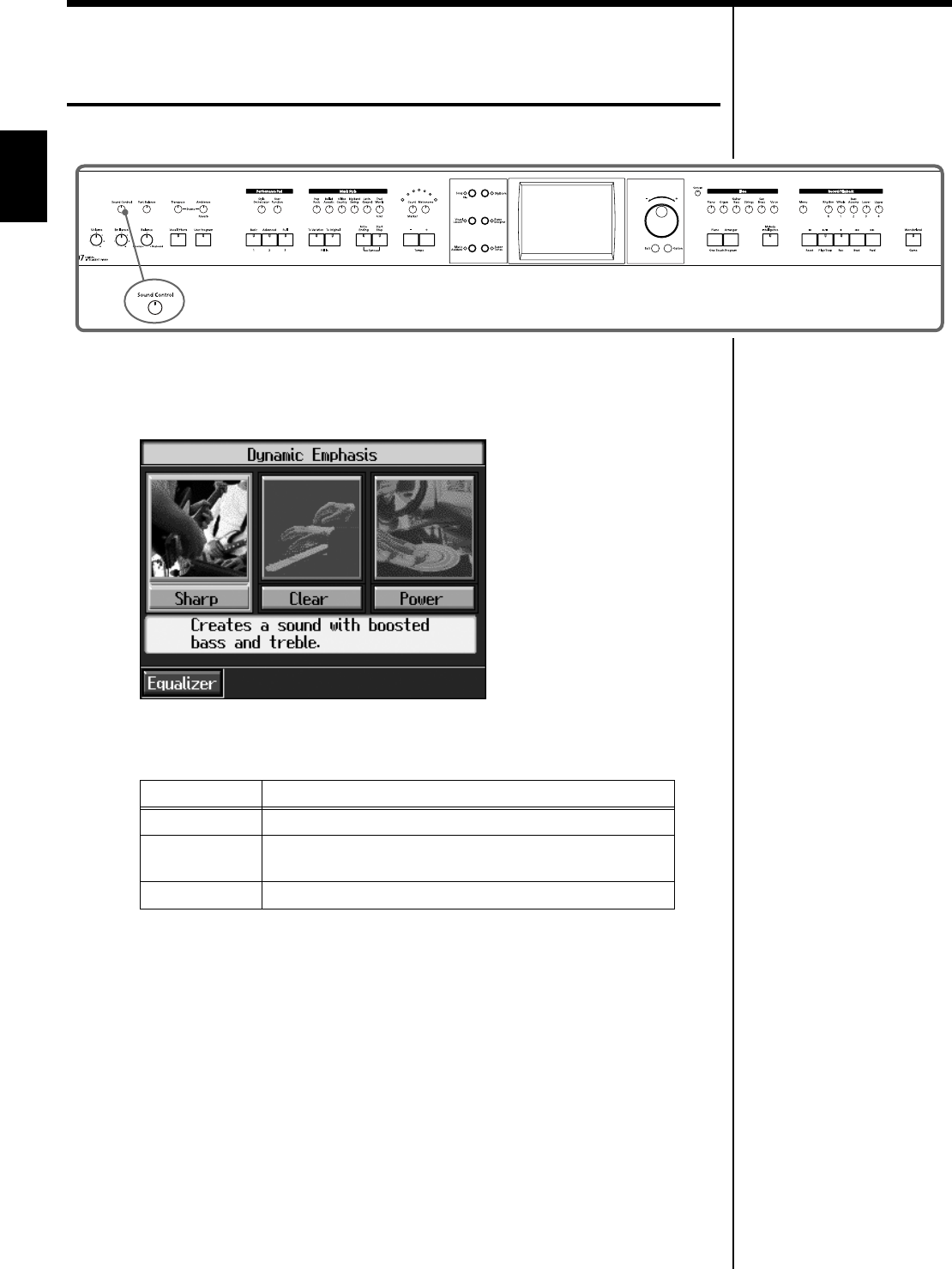
32
Chapter 1 Performance
Chapter 1
Adding Liveliness to the Sound
(Dynamic Emphasis)
You can add liveliness to the sound to give it superb clarity and distinctness.
fig.panel2-8
1Press the [Sound Control] button, to display the “Sound Control screen.”
The Dynamic Emphasis function is switched on, enlivening the sound.
fig.d-adv3dopt.eps_60
2Touch the Type icon to select the type.
3Touch <Off> to cancel the Dynamics Emphasis function.
Indicator Description
Sharp Creates a sound with boosted bass and treble.
Clear Produces a sound with chords in the low registers that are
clear and distinct.
Power Creates a sound with boosted bass.
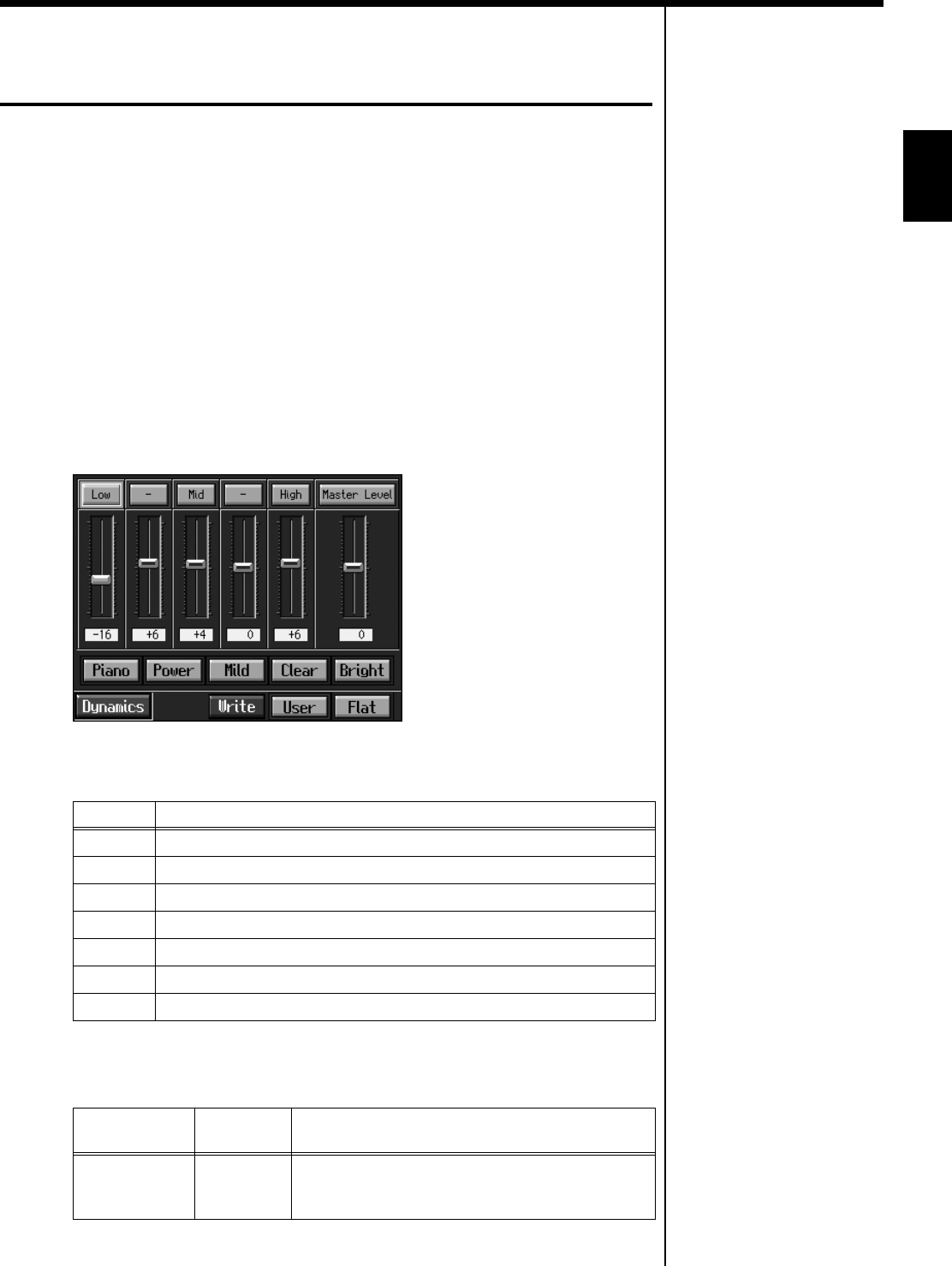
33
Chapter 1 Performance
Chapter 1
Adjusting the Sound to Achieve the
Preferred Tone Quality (Equalizer)
The KR features a built-in, five-band digital equalizer.
An equalizer boosts or cuts specific sound pitches (frequency ranges) to adjust the
sound balance for the overall performance. For example, you can boost the highs to
get a crisper sound, or boost the low end for a more powerful sound.
You can also adjust the sound to compensate for the acoustical characteristics of the
performance space.
If raising the slider for each frequency ends up distorting the sound, you can correct
the distortion with the Master Level slider.
1. Press the [Sound Control] button, to display the “Sound Control screen.”
2. Touch <Equalizer>.
The “Equalizer screen” appears.
fig.d-eq.eps_60
3. Touch the Type icon to make your selection.
4. Touch the slider to make adjustment.
Display Explanation
Piano The optimal settings for piano performance are selected.
Power Boosts both the low- and high-frequency ranges.
Mild Lows and highs are restrained for a pleasant-sounding tone.
Clear This setting slightly boosts the midrange for a simple pop feeling.
Bright This setting boosts the high frequencies for a brilliant, sparkling sound.
Flat All slider values are set to “0.”
User Store your own preferred settings (p. 34).
Displayed Settings
Value Explanation
Low -60–0–+60
Low-frequency range. This is the range of
frequencies for instruments like drums, bass,
organ, guitar and strings.
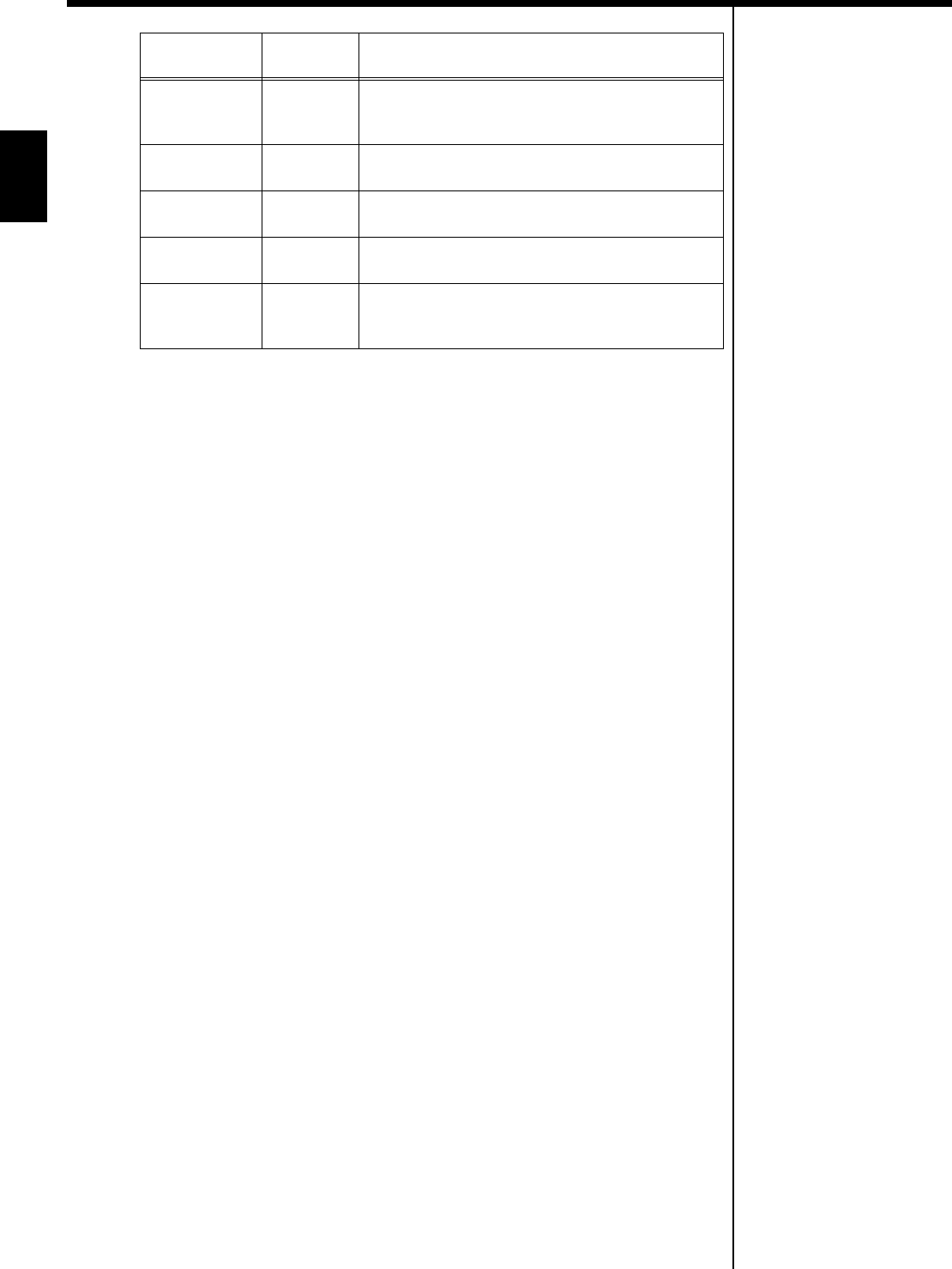
34
Chapter 1 Performance
Chapter 1
You can also move the slider with the dial.
When you press the [Exit] button, the equalization is placed in effect, and you return
to the previous screen.
Cancelling the effect
5. Touch <Flat>.
❍Storing the settings
You can store adjusted equalizer settings to <User>.
Even after editing the settings, you can touch <User> to call up your preferred
settings.
1. Press the [Sound Control] button and watch the indicator light up.
2. Touch <Equalizer>.
The “Equalizer screen” appears.
3. Adjust the equalizer.
4. Touch <Write>.
The settings are stored.
Even after editing the settings, you can touch <User> to select the stored settings.
– -60–0–+60
Mid-low-frequency range. This is the range of
frequencies for lower brass and woodwind
instruments.
Mid -60–0–+60 Midrange. This is the range of frequencies where
most instrument sounds are concentrated.
– -60–0–+60 Mid-high-frequency range. The ear is most
sensitive to this frequency range.
High -60–0–+60 High-frequency range. These frequencies add
brilliance to the sound.
Master Level -60–0–+60
You can temper the distortion in the sound by
lowering the level. Raising the level too much may
cause the sound to become distorted.
Displayed Settings
Value Explanation
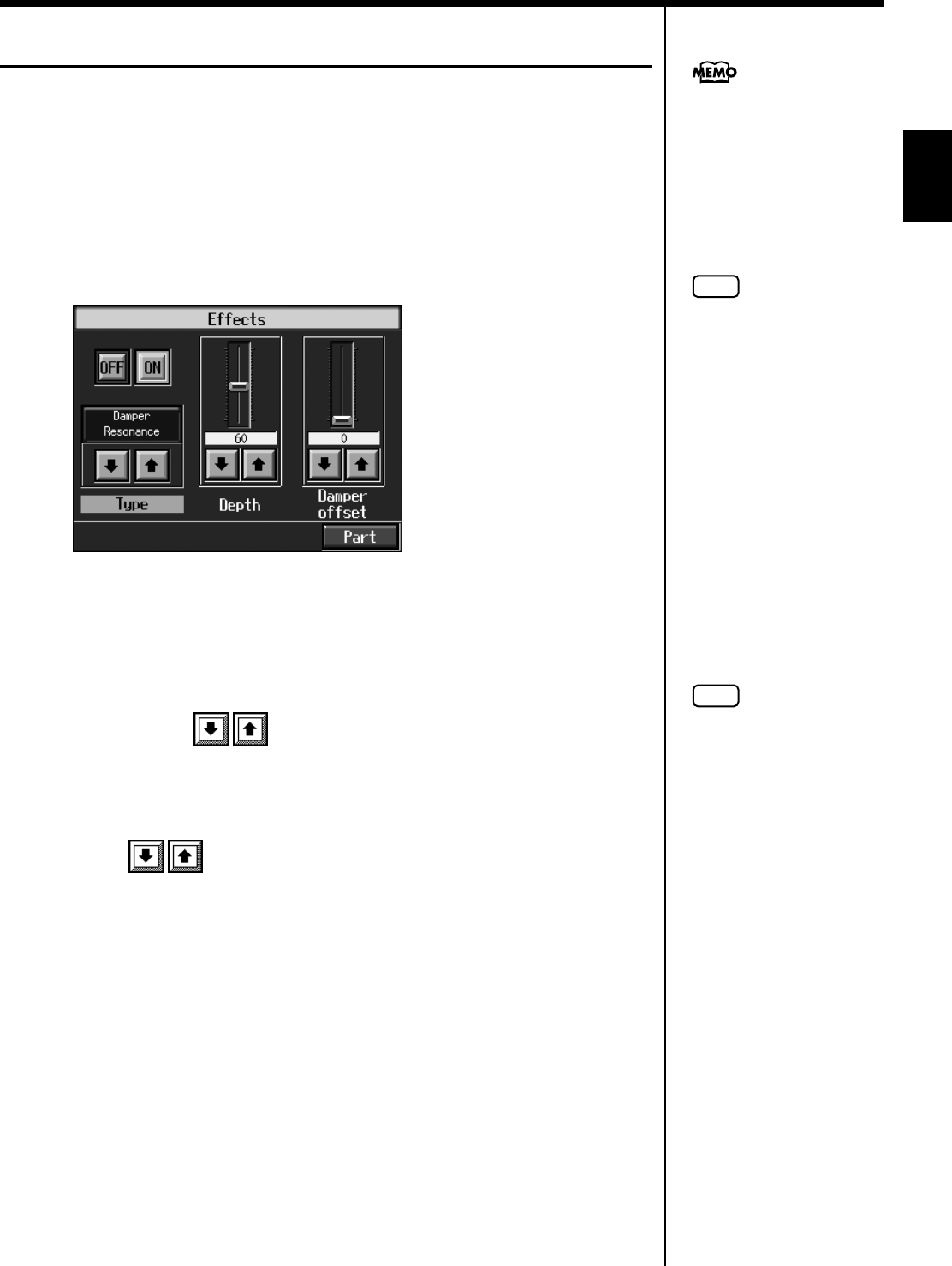
35
Chapter 1 Performance
Chapter 1
Applying Effects to the Sound (Effects)
You can apply a wide range of different effects to the notes you play on the
keyboard.
1. First, press the Tone button to select a Tone (p. 22).
The “Tone selection screen” appears.
2. Then, touch <Effects>.
The “Effect screen” appears.
fig.d-effects.eps_60
Applying effects to the sound
3. Touch <ON>.
The effect selected with <Type> will be applied.
Selecting the type of Effect
4. Touch <Type> to select the type of effect.
Setting the Effect
The parameters that can be set change according to the type selected in Step 4.
5. Touch for the parameter being set to select the value.
You can also move the slider with the dial.
Press the [Exit] button to return to the Tone selection screen.
Cancelling the Effect
6. On the Effects screen, touch <Off>.
For more on the effect types,
refer to the “Effects List” (p.
176).
NOTE
The effect is not applied to the
layer tone or left-hand tone if
the effect is different than that
applied to the right-hand tone.
Select the same effect.
NOTE
You may find effects not being
applied to certain parts when
different effects are applied to
the right-hand tone, layer tone,
and left-hand tone. In such
instances, you can select which
effect is to have priority.
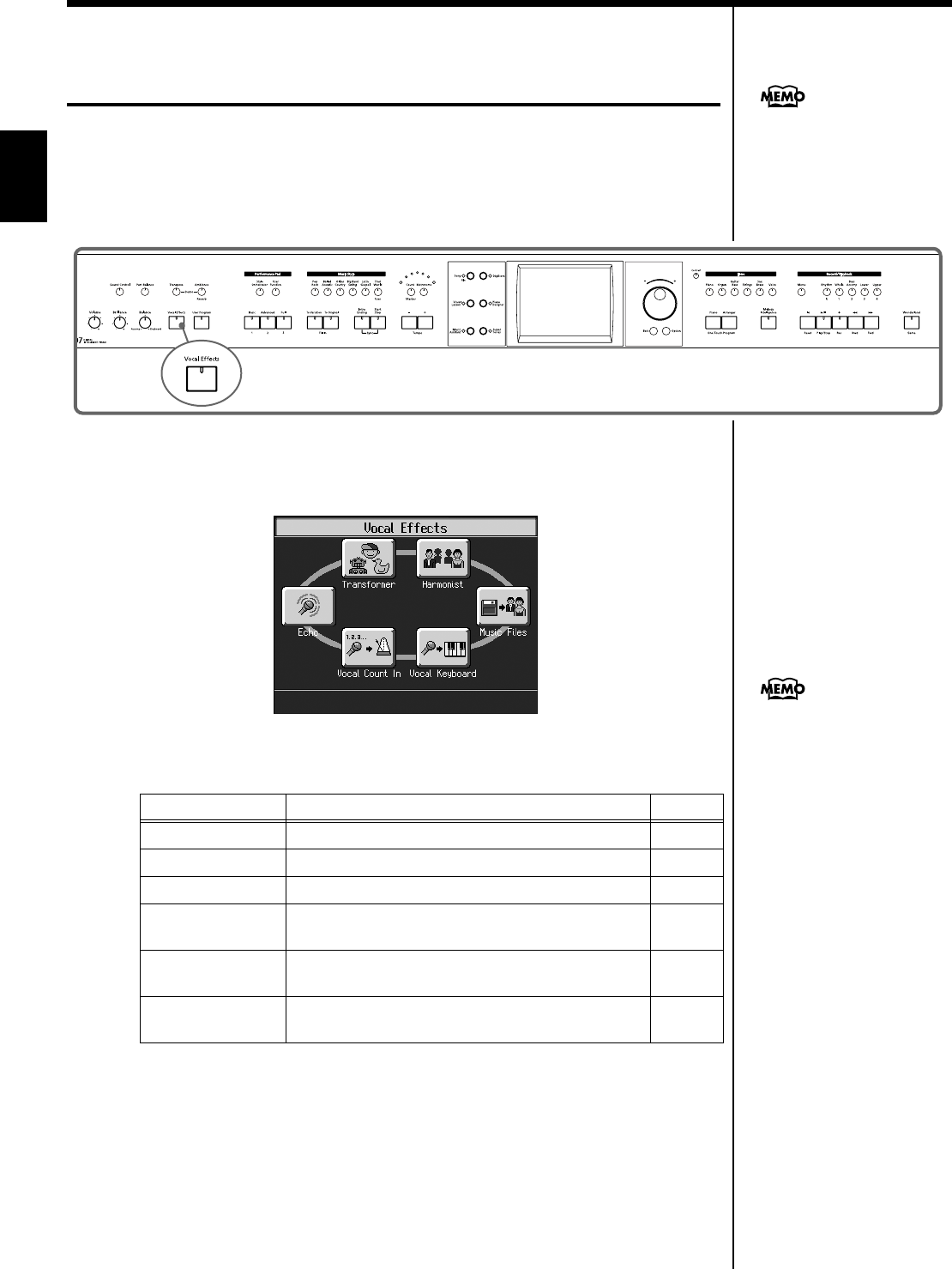
36
Chapter 1 Performance
Chapter 1
Adding Effects to Mic Vocals
(Vocal Effect)
With a microphone connected, you can add effects to the microphone vocals.
Adding effects to the vocals is referred to as “Vocal Effect.”
❍How to select Vocal Effect
fig.panel1-5
1. Press the [Vocal Effects] button.
The “Vocal Effects screen” appears.
fig.d-vocalsfx.eps_60
2. Touch any one of the icons.
3. When you press the [Exit] button, the effect is applied and you return to
the previous screen.
Icon Explanation Page
Echo Adjusts the microphone echo. p. 37
Transformer Alters the microphone vocals. p. 37
Harmonist Adds harmonies to the original voice. p. 45
Vocal Count In Allows you to start songs and Automatic
Accompaniment using your own tempo. p. 39
Vocal Keyboard Allows you to produce sounds conforming to the
vocal scale. p. 40
Music Files You can play a specific part as harmony while
playing back a song. p. 41
For details on connecting a
microphone, refer to
“Connecting a Microphone”
(p. 22).
You can adjust the microphone
volume with the Mic Volume
knob on the (left) underside of
the KR107.
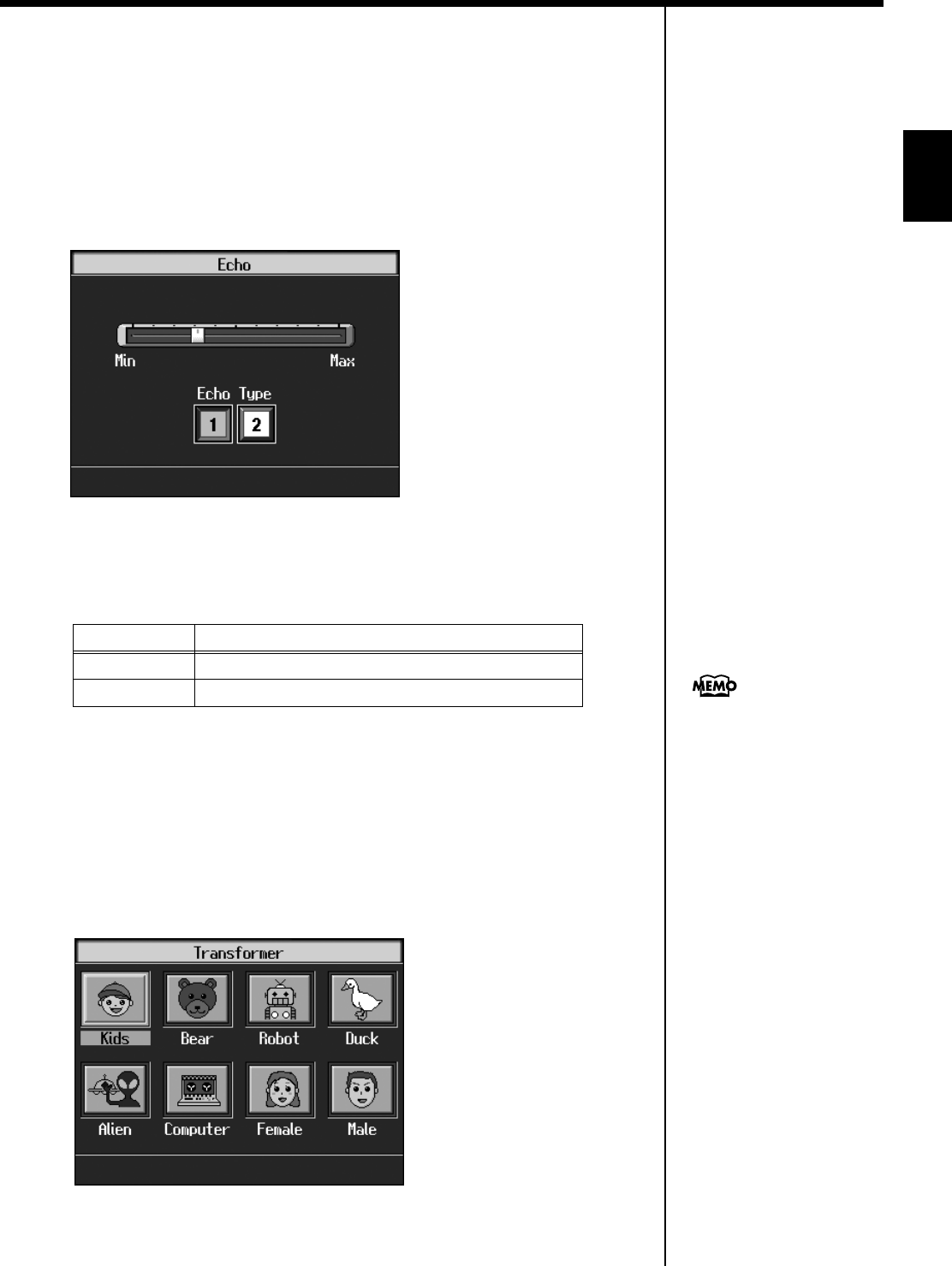
37
Chapter 1 Performance
Chapter 1
Cancelling the Vocal Effect
4. Press the [Vocal Effects] button and watch the indicator light go out.
The Vocal Effect function is cancelled.
❍Adjusting the Echo (Echo)
1. Touch <Echo> in Step 2 of “How to select Vocal Effect” (p. 36).
fig.d-vo-echo.eps_60
2. Touch the bar graph to adjust the amount of echo applied to the vocal.
3. Touch the Echo Type <1> or <2> to change the echo type.
Press the [Exit] button to return to the Vocal Effects screen.
❍Altering Vocals (Transformer)
You can modify the way your voice sounds through the microphone. This is called
the “Voice Transformer” function.
1. Touch <Transformer> in Step 2 of “How to select Vocal Effect” (p. 36).
fig.d-vo-trans.eps_60
Displayed Explanation
1Adds basic reverberations.
2Adds reverberations for a karaoke-type echo.
When you use the Voice
Transformer function, the
resonance setting for the piano
(see p. 152) may sometimes be
reset.
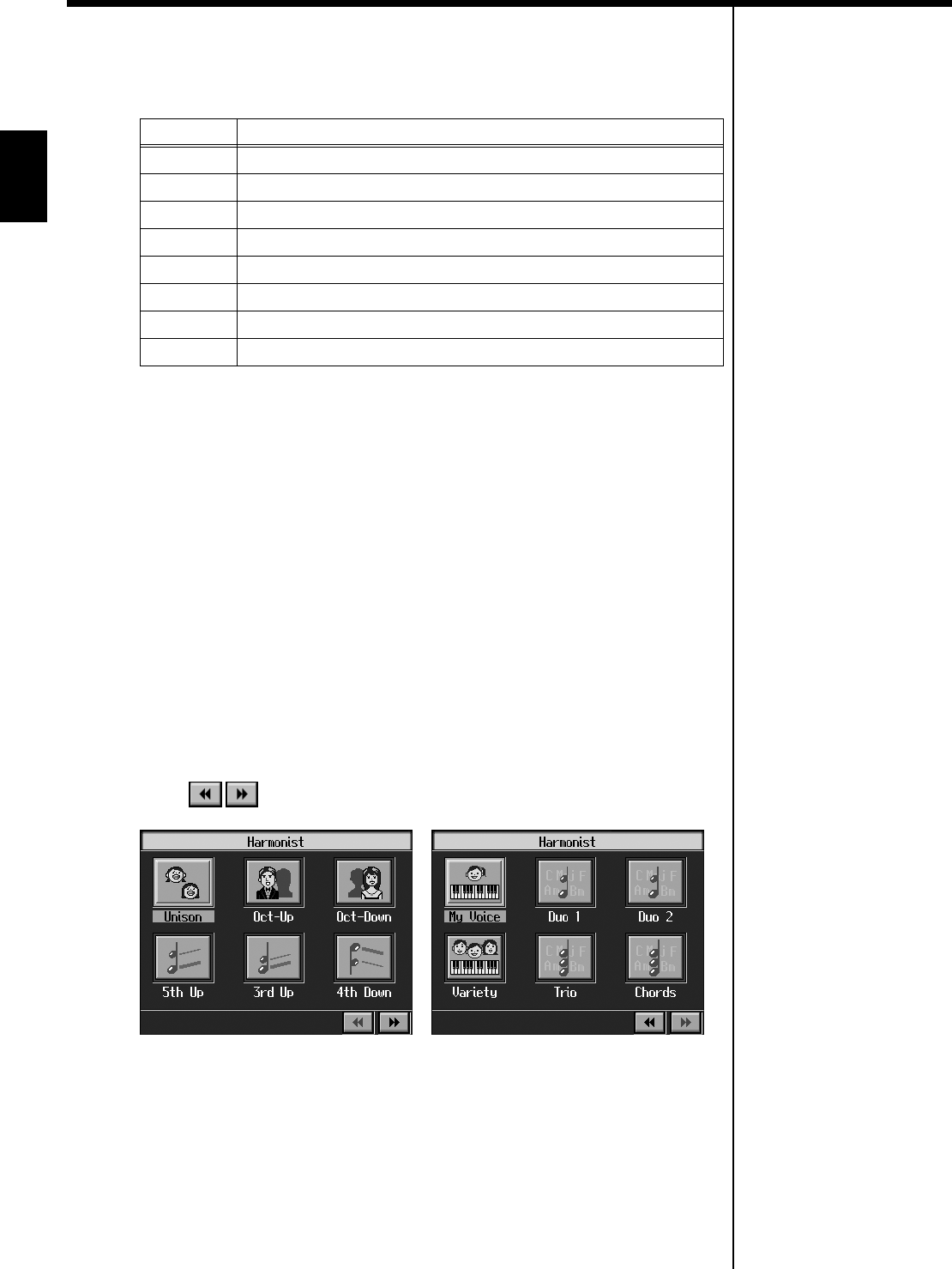
38
Chapter 1 Performance
Chapter 1
2. Touch any one of the icons.
Here’s what the different icons do.
3. Sing through the microphone.
Your voice is transformed according to the item you selected.
Cancelling the Effect
4. Once again, touch the icon you selected in Step 2.
The Voice Transformer effect is eliminated.
Press the [Exit] button to return to the Vocal Effects screen.
❍Adding Harmonies (Harmonist)
You can sing with a harmony accompaniment, even when you’re playing solo. This
is called the “Harmonist” function.
1. Touch <Harmonist> in Step 2 of “How to select Vocal Effect” (p. 36).
Touch to switch the screen.
fig.d-vo-harmo.eps_60
Display Explanation
Kids Transforms the input into the sound of a child’s voice.
Bear Transforms the input sound into the voice of a large animal.
Robot Transforms the input into the sound of a robot’s voice.
Duck Transforms the input into a duck’s quacking sound.
Alien Transforms the input into an alien voice.
Computer Transforms the input into a voice like that from a computer.
Female Transforms male voices into female voices.
Male Transforms female voices into male voices.
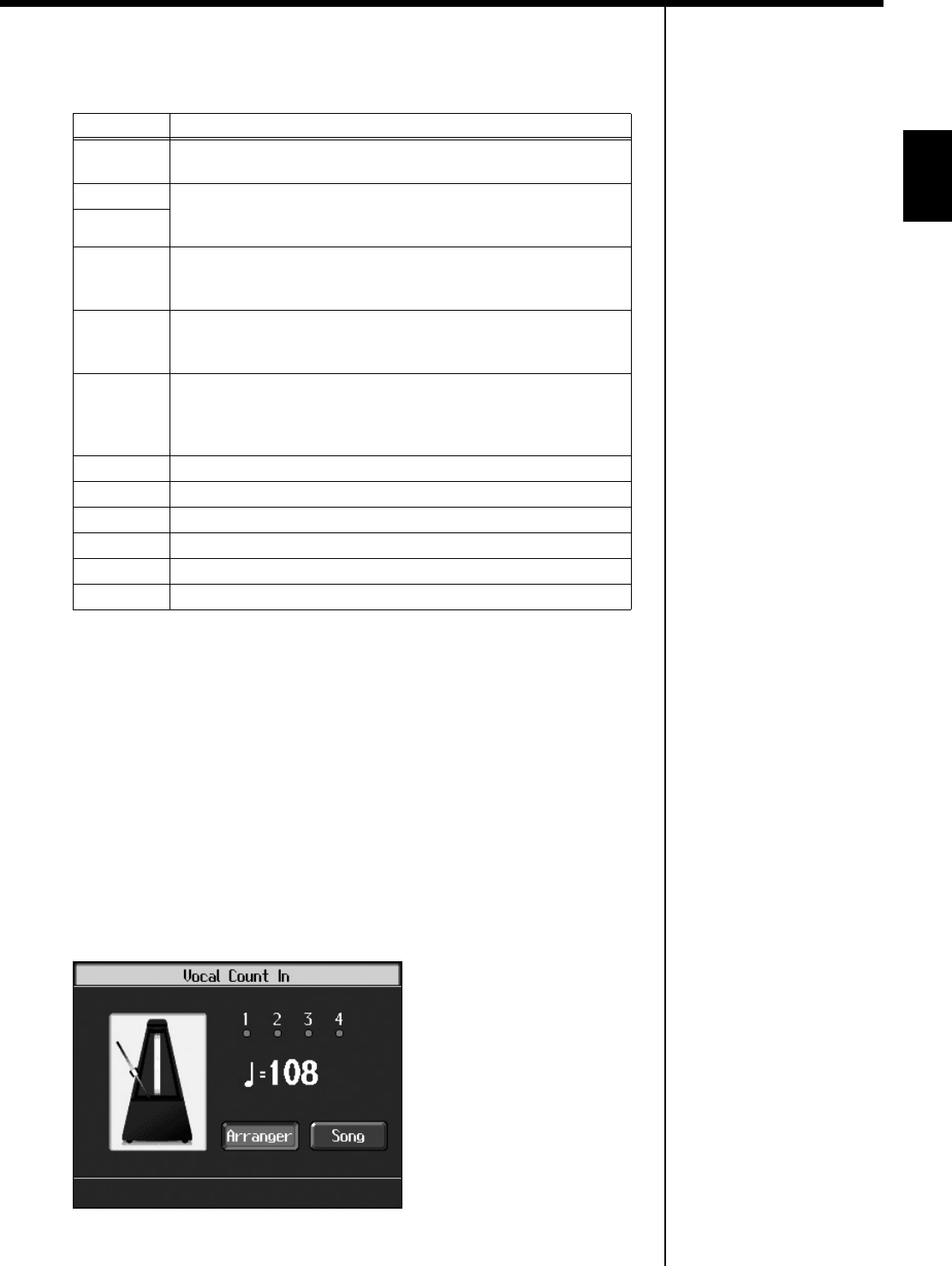
39
Chapter 1 Performance
Chapter 1
2. Touch any one of the icons.
Here’s what the different icons do.
Cancelling the Effect
3. Touch the Harmonist type you selected in Step 2 again.
The Harmonist function is cancelled.
Press the [Exit] button to go back to the Vocal Effects screen.
❍Enabling the start of songs and automatic accompaniment with the
sound of your voice (Vocal Count-In)
You can start songs and the Automatic Accompaniment by counting into the
microphone.
1. Touch <Vocal Count In> in Step 2 of “How to select Vocal Effect” (p. 36).
fig.d-vo-coin.eps_60
Display Explanation
My Voice The melody played on the keyboard is played as the harmony.
The harmony is added to your voice regardless of the pitch.
Duo1 The added harmony matches the chords specified on the
keyboard. Adding harmony to a single voice gives the effect of
two people singing together.
Duo2
Variety
The melody played on the keyboard is played as the harmony.
The harmony added is matched to the pitch; for example, higher
pitches are used for female voices, lower pitches for male voices.
Trio
The added harmony matches the chords specified on the
keyboard. This adds a two-voice harmony that makes it seem that
a trio is singing.
Chord
The added harmony matches the chords specified on the
keyboard.
You can change the way harmonies are added with the Melody
Intelligence type (p. 59).
Unison Sounds like two people singing the same melody.
Oct-Up Adds another voice one octave higher than the original.
Oct-Down Adds another voice one octave lower than the original.
5th Up Adds harmony a fifth above the original.
3rd Up Adds harmony a third above the original.
4th Down Adds harmony a major fourth below the original.
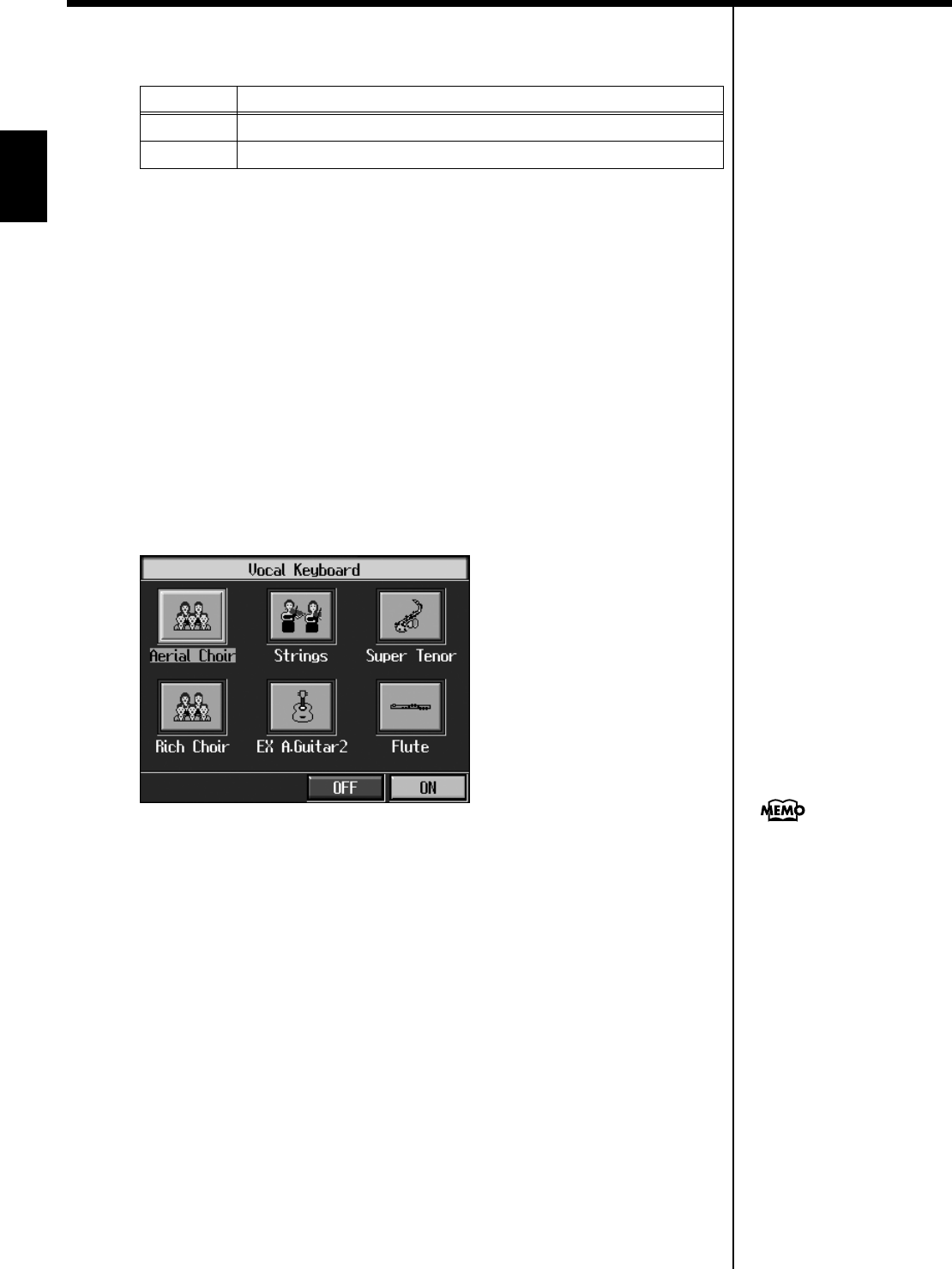
40
Chapter 1 Performance
Chapter 1
2. Touch <Arranger> or <Song>.
3. Count to four (“One, two, three, four”) into the mic.
Count out the number of beats per measure in the time signature of the selected song
or Music Style.
For example, if you select a time signature of 4/4, then count to four; count to three
when 3/4 time is selected.
The tempo is automatically set according to the interval between the counts as you
speak into the microphone, and the song or Arranger begins.
Press the [Exit] button to return to the Vocal Effects screen.
❍Playing instrument sounds at vocal pitches (Vocal Keyboard)
You can have melodies sung into the microphone played with the KR’s internal
Tones.
1. Touch <Vocal Keyboard> in Step 2 of “How to select Vocal Effect” (p. 36).
fig.d-vo-key.eps_60
2. If the <OFF> icon is selected, touch the <ON> icon.
3. Touch any of the icons to select a Tone.
You can also select the Tone by pressing the Tone button.
When you sing into the microphone, the sung pitches are played using the selected
Tone.
Cancelling the effect
4. Touch <OFF>.
The Vocal Keyboard function is cancelled.
Press the [Exit] button to go back to the Vocal Effects screen.
Display Explanation
Arranger Automatic Accompaniment starts at the tempo used for the count.
Song The song starts at the tempo used for the count.
When you play the keys while
using Vocal Keyboard, the
tone selected for Vocal
Keyboard is played.
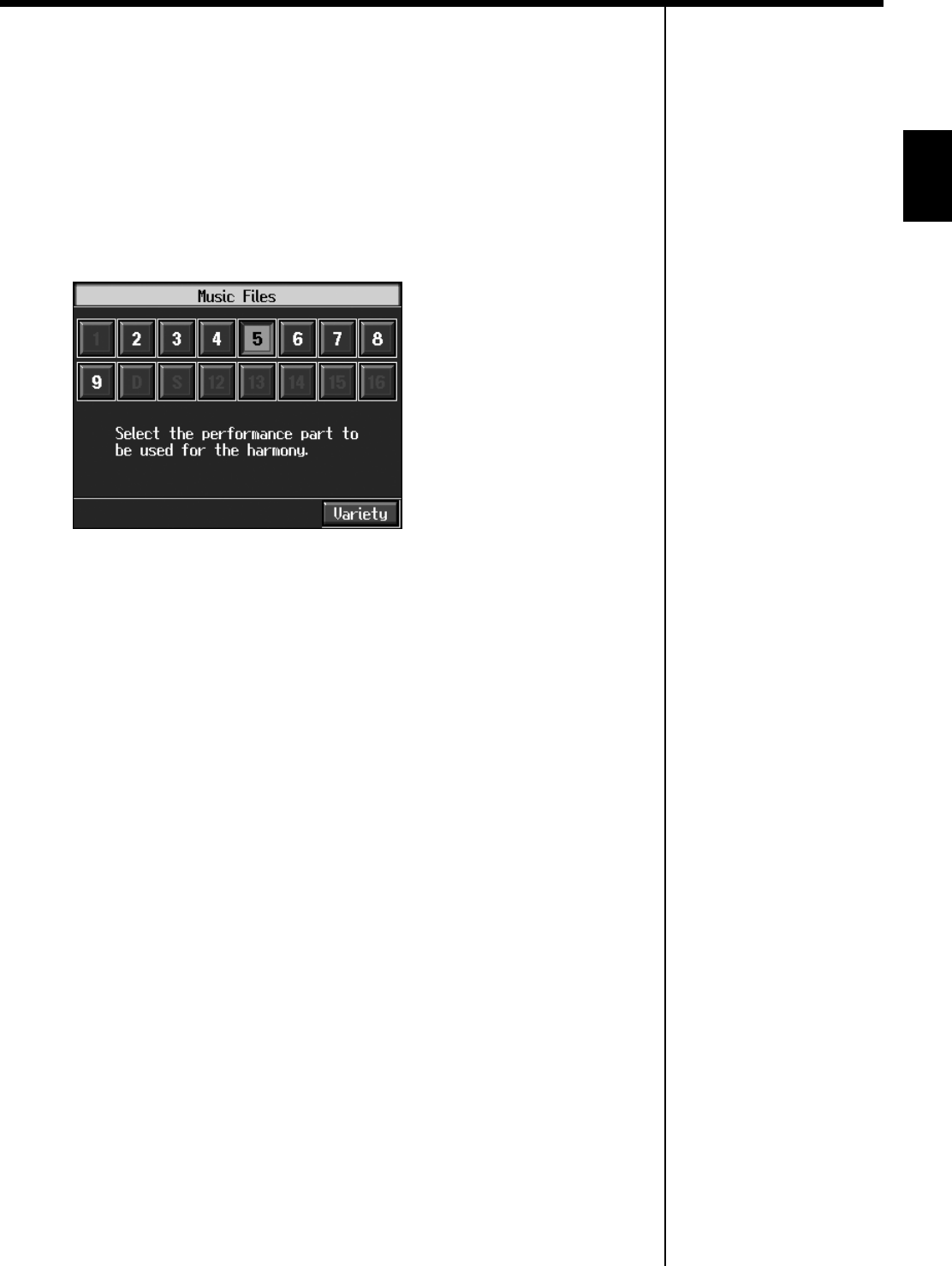
41
Chapter 1 Performance
Chapter 1
❍Adding harmonies to a specified part (Music Files)
When you sing while playing back a specified part from song data, harmony is
added based on pitches of the specified part.
1. Select the song to which you want to add harmony.
To select a song stored in external memory, connect the external memory to the
external memory port.
2. Touch <Music Files> in Step 2 of “How to select Vocal Effect” (p. 36).
fig.d-vo-music.eps_60
3. Touch the icon for the part to which you want to add harmony.
When you play back the song and sing into the mic, harmonies are added using the
pitches of the specified part.
4. Touch <Variety>.
When <Variety> is ON, the melody played on the keyboard is played as the
harmony. The harmony added is matched to the pitch.
Cancelling the effect
5. Touch the icon you selected in Step 3 again.
The Music Files function is cancelled.
Press the [Exit] button to go back to the Vocal Effects screen.
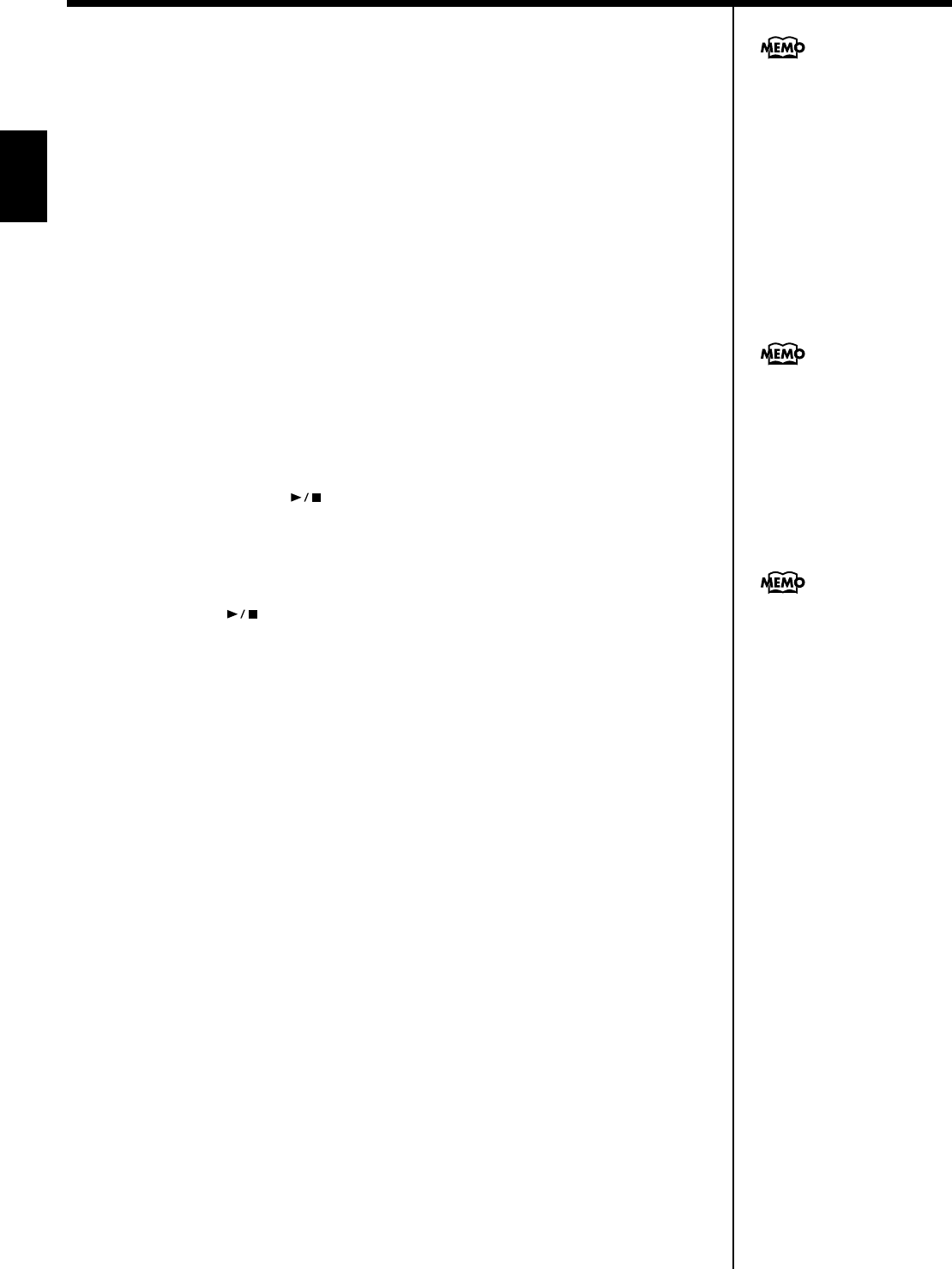
42
Chapter 1 Performance
Chapter 1
■Enjoying Karaoke Performances with Music Files
1. Connect a microphone.
2. Adjust the volume level and the amount of echo applied.
On the KR, use the Vocal Effect function to adjust the echo (p. 37).
You can also enjoy this effect with the Voice Transformer function (p. 37) and
Harmonist function (p. 38, 45).
3. Select a song.
To select a song stored in external memory, connect the external memory to the
external memory port. For instructions on how to select songs, refer to “Playing a
Song” (p. 64).
4. Adjust the tempo as required with the Tempo [-] [+] buttons.
5. If necessary, change the key of the song (p. 87).
When you press the [ (Play/Stop)] button, the accompaniment starts playing.
Sing along with the accompaniment.
When you play back a Music File with lyrics, the lyrics appear on screen.
6. Press the [ (Play/Stop)] button to stop the accompaniment.
Commercial music files
designed for “karaoke” sing-
along are also available.
Consult your KR dealer when
purchasing music files. Refer
to “Music Files That the KR
Can Use” (p. 183).
On the KR, lyrics can also be
shown on an external display.
Refer to “Connecting an
External Display” (p. 23) and
“Selecting Images To Be
Shown on the KR and External
Displays (User Image
Display)” (p. 146).
You can stop lyrics from being
displayed. Refer to “Hiding
the Lyrics (Lyrics)” (p. 153).
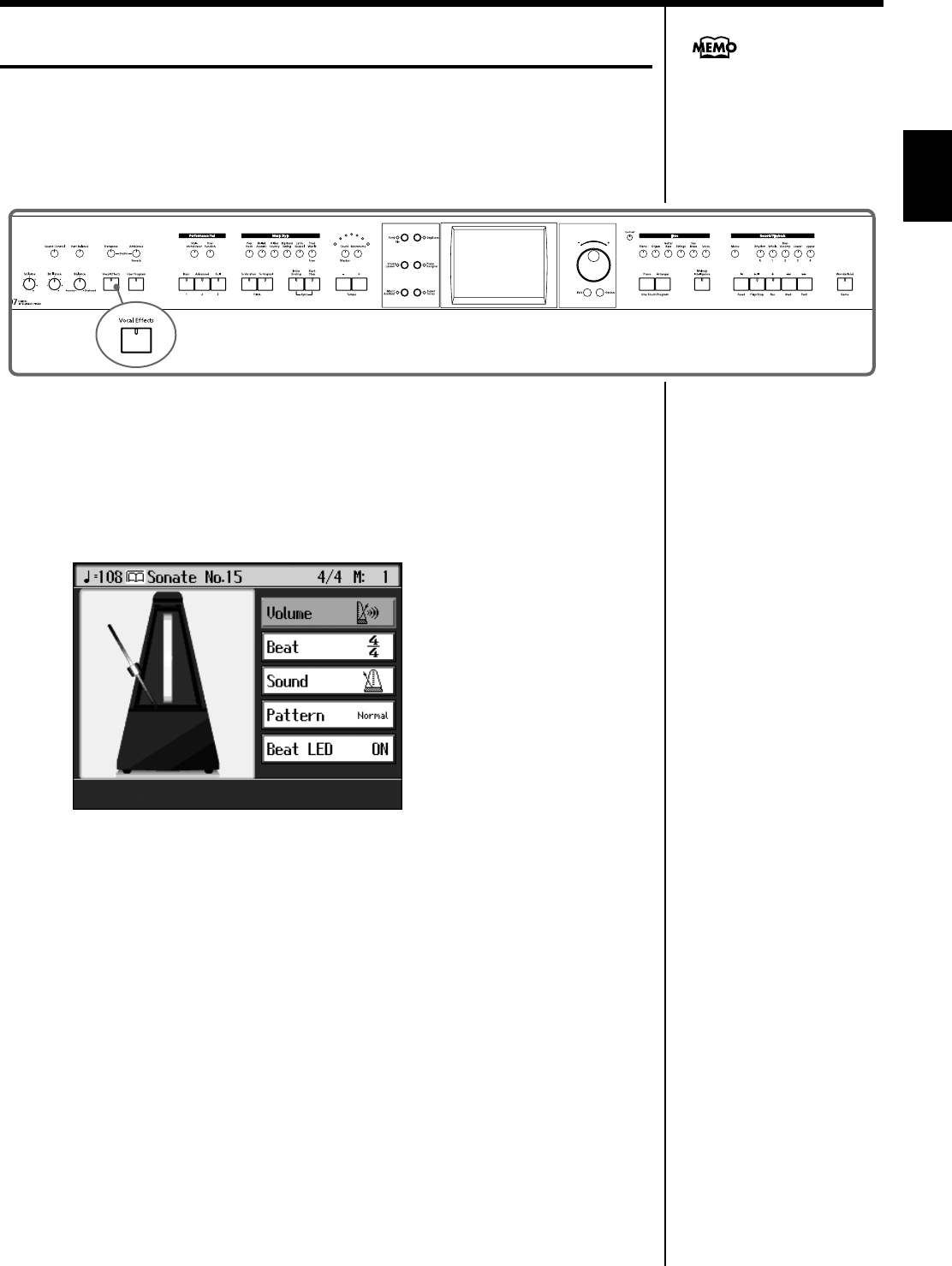
43
Chapter 1 Performance
Chapter 1
Using the Metronome
The KR features a built-in metronome. During playback of the song and
accompaniment, the metronome plays at that tempo and beat.
fig.panel1-6
■Using the Metronome
1. Press the [Metronome] button and watch the indicator light up.
You will hear the metronome.
The following “Metronome screen” appears.
fig.d-metro.eps_60
You can press the [Exit] button to have the metronome continue to play while you
return to the previous screen.
Stopping the metronome
2. Press the [Metronome] button once more, and the indicator light goes
out.
During playback of a song, or
when performing with
automatic accompaniment, the
sound of the metronome keeps
time with the beat of the song
or accompaniment.
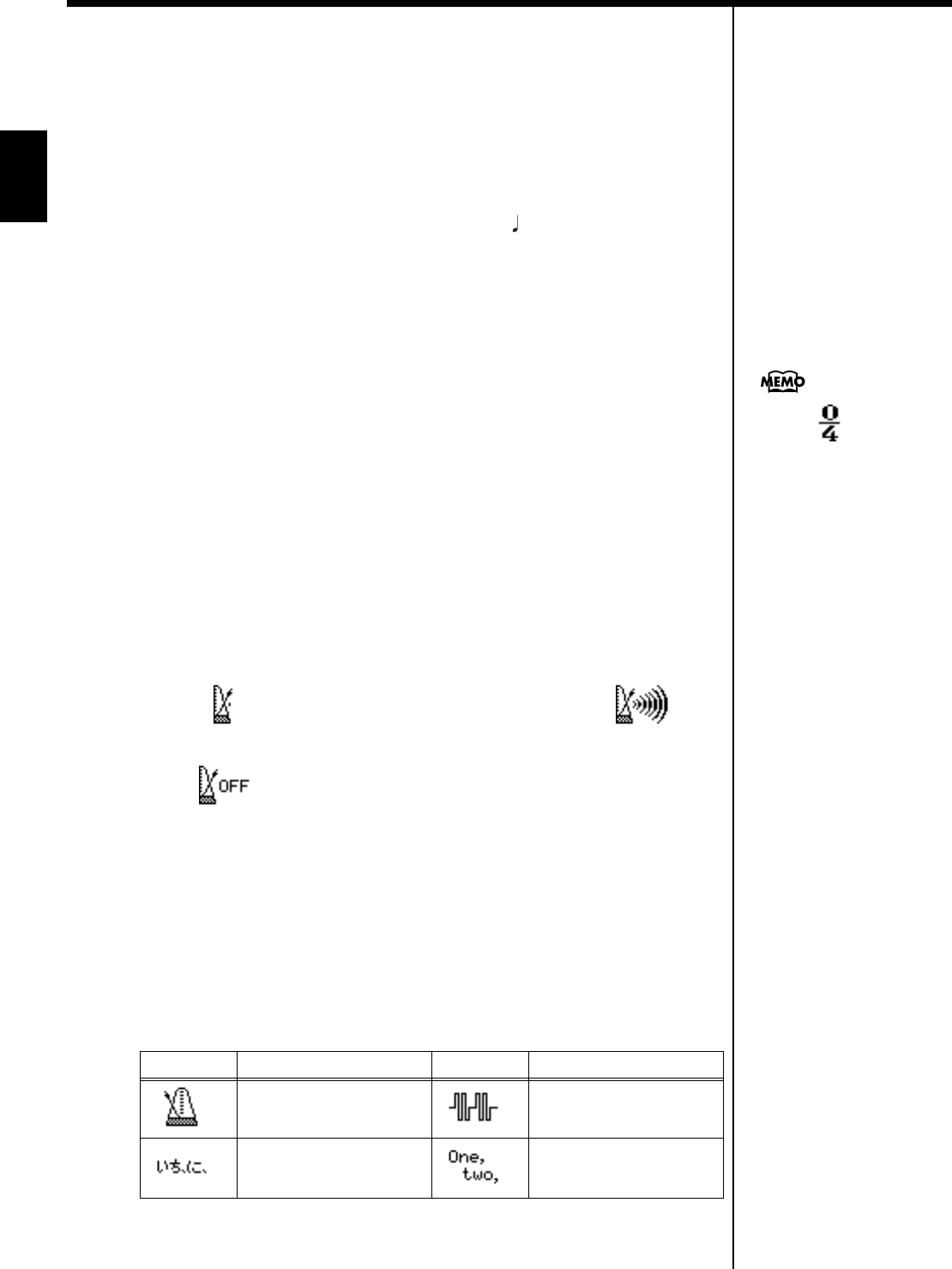
44
Chapter 1 Performance
Chapter 1
■Changing the Metronome Settings
❍Adjusting the tempo
You can adjust the tempo of the metronome. The tempo of the metronome changes
automatically if you use an Automatic Accompaniment or play back a song.
1. Press the Tempo [-] or [+] buttons to adjust a tempo.
You can adjust the metronome tempo over a range of = 10–500.
Pressing the Tempo [-] and [+] buttons simultaneously returns the selected song
accompaniment to the basic tempo.
❍Changing the beat of the metronome
1. On the Metronome screen, touch <Beat>.
2. Select the beat with the dial.
❍Changing the volume
The volume of the metronome can be adjusted to ten different levels.
1. On the Metronome screen, touch <Volume>.
2. Select the volume with the dial.
Choosing sets the volume to the lowest level, and choosing sets
it to the highest level.
Choose to silence the metronome sound.
❍Changing the Type of Sound
You can change the sound the metronome makes.
The setting is at “normal metronome sound” when the KR is powered up.
1. On the Metronome screen, touch <Sound>.
2. Select the sound with the dial.
Displayed Explanation Displayed Explanation
Normal metronome
sound
Electronic metronome
sound
“1, 2, 3” in Japanese “1, 2, 3” in English
When is selected,
only the upbeat will sound.
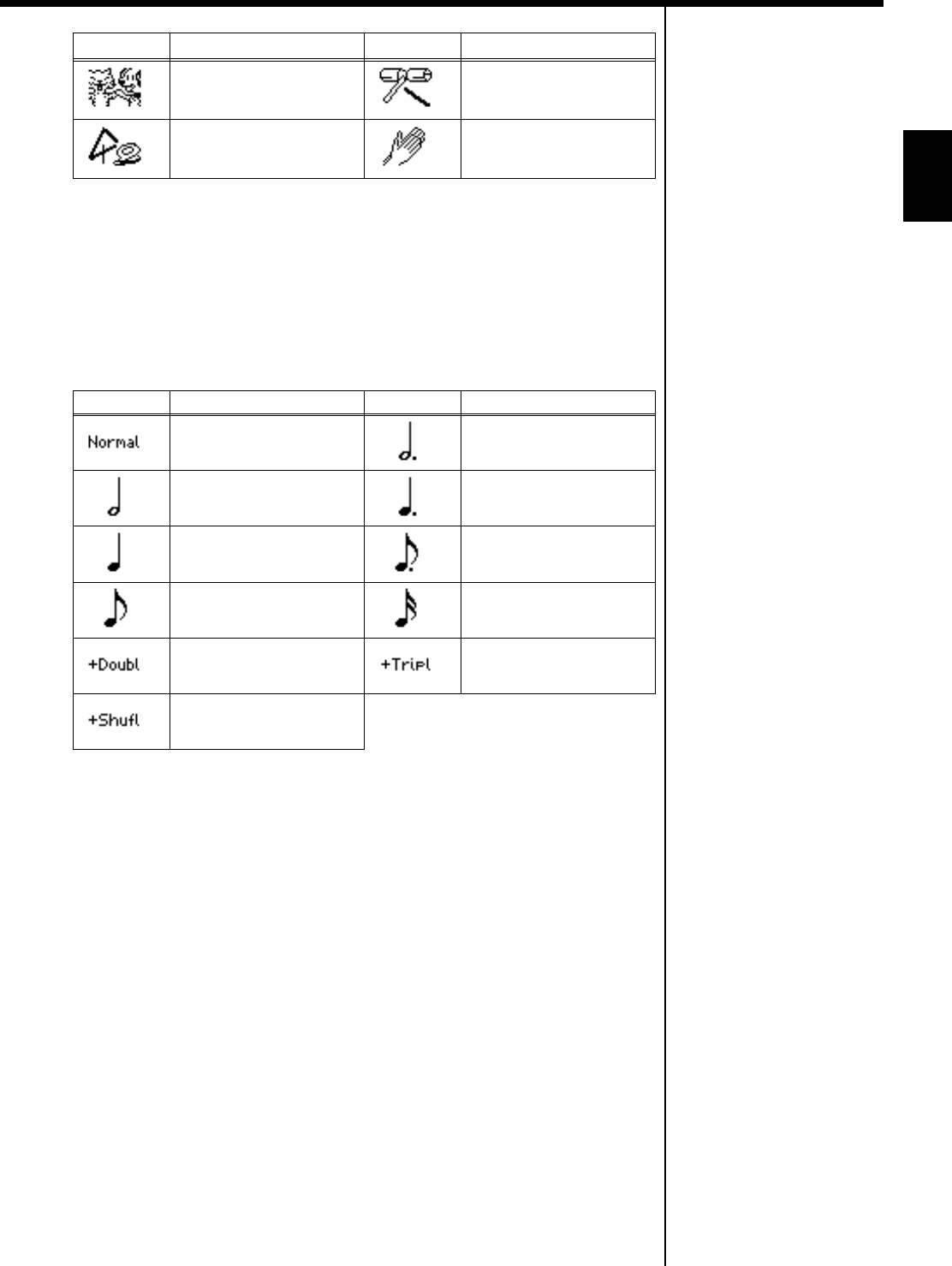
45
Chapter 1 Performance
Chapter 1
❍Changing how the metronome beat (pattern) sounds
You can set the Metronome to play at even smaller intervals.
1. On the Metronome screen, touch <Pattern>.
2. Select the pattern with the dial.
❍Turning Off the Beat Light (Beat Indicator)
The beat light flashes in time with the metronome, accompaniment Styles, and song
tempos, but you can set it so that it stays off at all times.
1. Touch <Beat Indicator> in the Metronome screen.
2. Select On/Off (Beat Indicator off) with the dial.
Dog and cat sounds Wood block
Triangle and castanet Hand clap
Displayed Explanation Displayed Explanation
Usual sound Dotted half-note intervals
Half-note intervals Dotted quarter-note
intervals
Quarter-note intervals Dotted eighth-note
intervals
Eighth-note intervals Sixteenth-note intervals
Single back beat added Triplet rhythm added
Shuffle rhythm added
Displayed Explanation Displayed Explanation
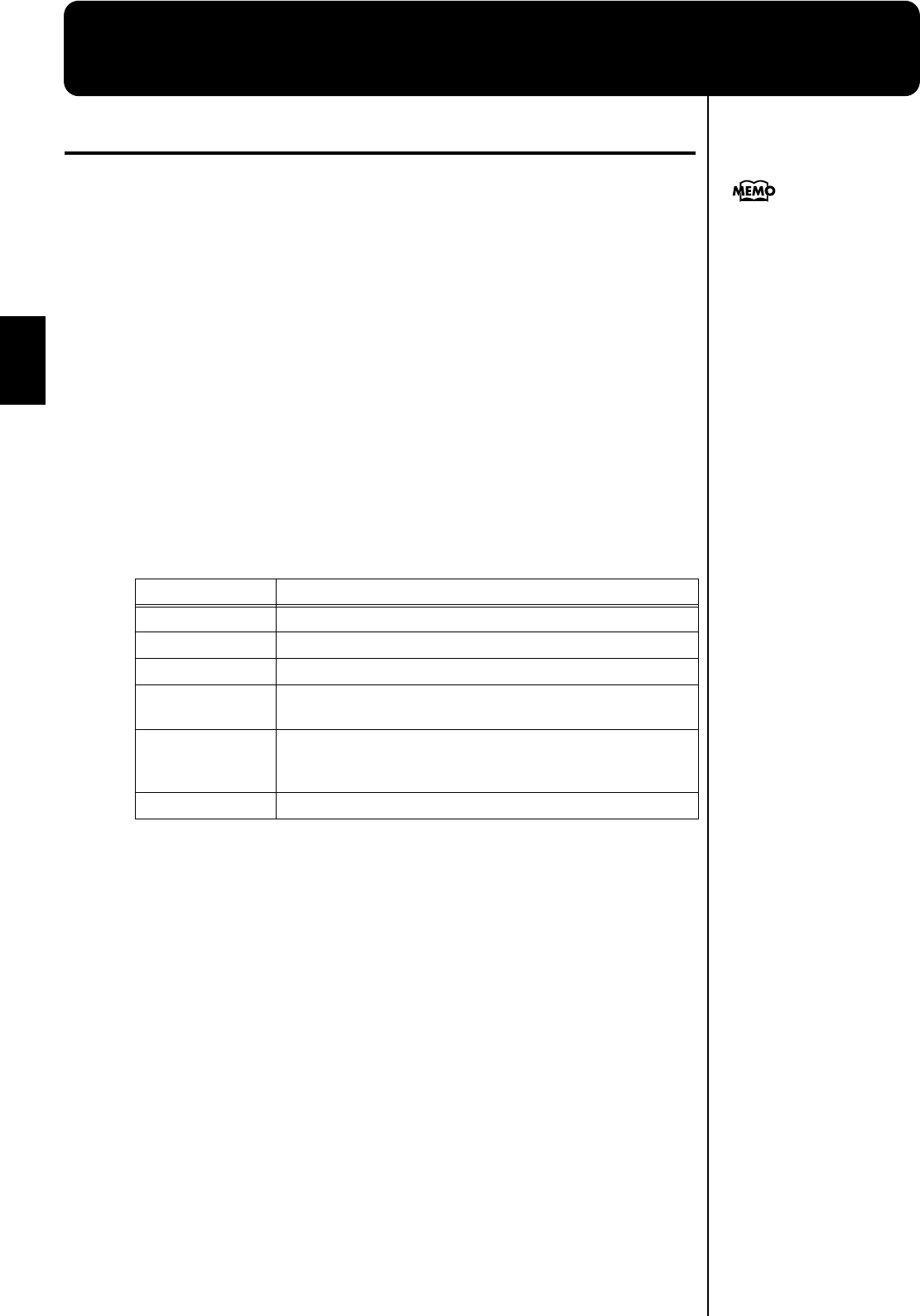
46
Chapter 2
Chapter 2 Automatic Accompaniment
Music Styles and Automatic Accompaniment
What is Automatic Accompaniment?
Press the One Touch Program [Arranger] button for Automatic Accompaniment’s
optimum settings. Automatic Accompaniment is a function that provides you with
accompaniment in a variety of musical genres, just by specifying chords in the left
hand. Automatic Accompaniment lets you play with an orchestra, even when
performing alone!
What Are Music Styles?
Accompaniment patterns in various musical genres are called “Music Styles.”
There are many different kinds of music around the world, and each has its own
unique features. What gives jazz or classical music their unmistakable sounds are a
unique combination of elements like instrumentation, melody, and phrasing, which
interact to create the musical character.
Elements of Music Styles
A Music Style consists of a set of six sections called “divisions.”
In addition, Music Styles are built from: “Rhythm,” “Bass,” “Accompaniment 1,”
“Accompaniment 2,” “Accompaniment 3,” “Accompaniment 4,” “Accompaniment
5,” and “Accompaniment 6.”
Division Explanation
Intro Played at the start of a song.
Original The basic accompaniment pattern.
Variation This is a variation on the Original accompaniment pattern.
Fill In To Original This is a one-measure phrase inserted at a point where the
mood changes and the accompaniment returns to the original.
Fill In To
Variation
This is a one-measure phrase inserted at a point where the
mood changes and the accompaniment moves ahead to the
variation.
Ending The conclusion of a song.
For instructions on playing the
Automatic Accompaniment,
refer to “Selecting Music Styles
(Music Style Buttons)” (p. 50).
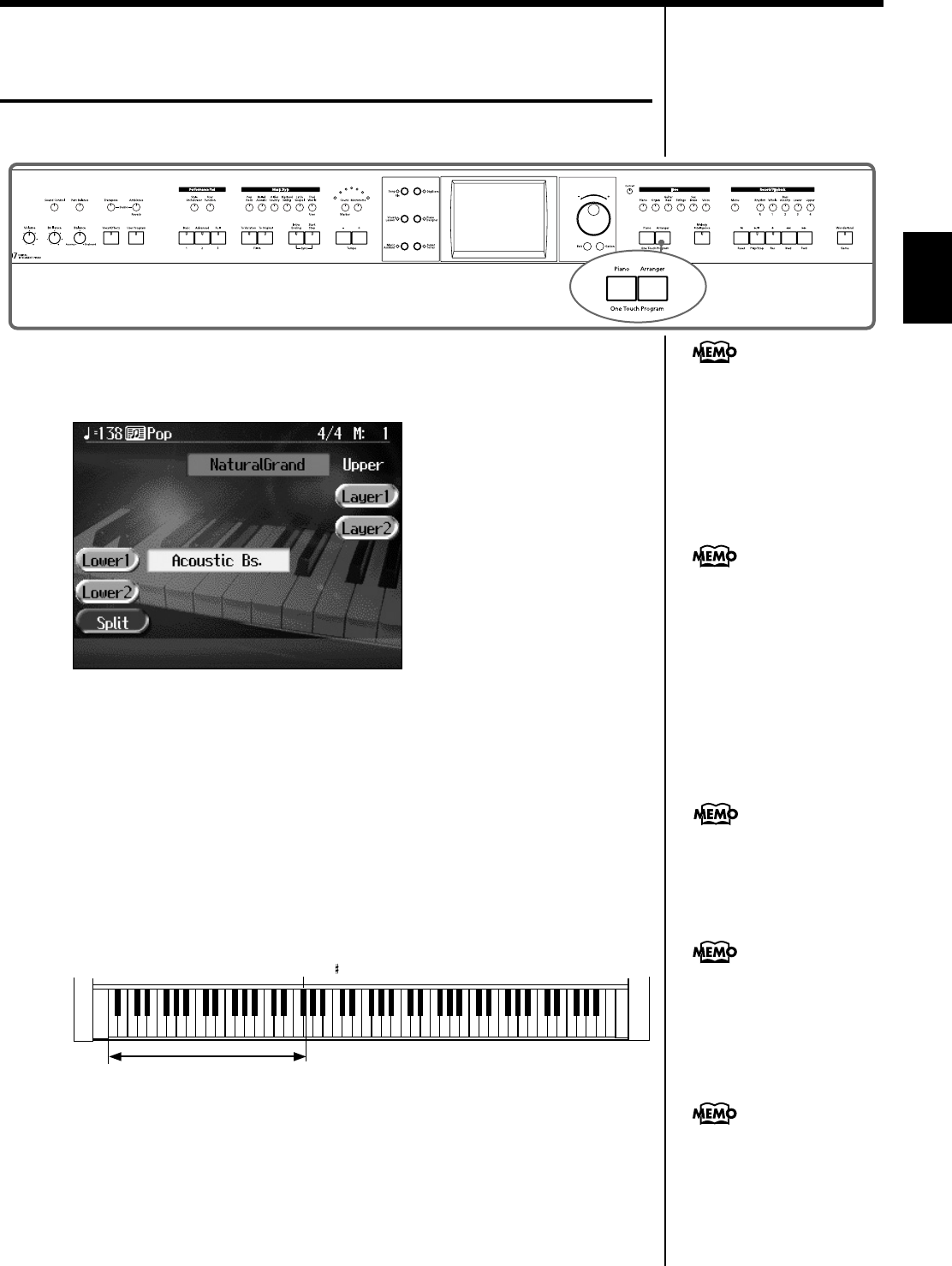
47
Chapter 2 Automatic Accompaniment
Chapter 2
Performing Using Automatic Accompaniment
(One-Touch Arranger)
Here’s how to create the settings for Automatic Accompaniment.
fig.panel2-1
1. Press the One Touch Program [Arranger] button.
The Basic screen like the one shown below appears.
fig.d-arrbasic.eps_60
Observe the settings:
• The keyboard is split into left- and right-hand parts, with accompaniment
chords specified for the left-hand side of the keyboard.
• A tone appropriate for the selected Music Style is chosen.
• The tempo and beat for the selected Music Style is set.
2. Play a chord on the lower-part of keyboard.
The accompaniment begins, starting from the intro.
Play chords with the left hand, and the melody with the right.
When you change chords in the left hand, the accompaniment also changes.
fig.arr-split.e
3. Press the [Intro/Ending] button.
After the ending plays, the accompaniment stops.
<*** > appears in the Piano
screen or Basic screen when
headphones are connected.
You can add three-
dimensional breadth to the
sound from the headphones
(p. 33).
Normally, when you change a
Music Style, the tempo and
tone change to selections that
go well with the selected
Music Style. If you do not want
to change the tempo and tone,
refer to “Changing Music
Styles Without Changing the
Tone or Tempo (One Touch
Setting)” (p. 138).
F
3
The range specifyed a chord
Split Point ( )
For instructions on selecting
Music Styles, refer to
“Selecting Music Styles (Music
Style Buttons)” (p. 50).
For instructions on starting
and stopping the
accompaniment, refer to
“Starting and Stopping the
Accompaniment” (p. 54).
You can change the range in
which chords are played.
Please refer to “Changing the
Keyboard’s Split Point (Split
Point)” (p. 138).
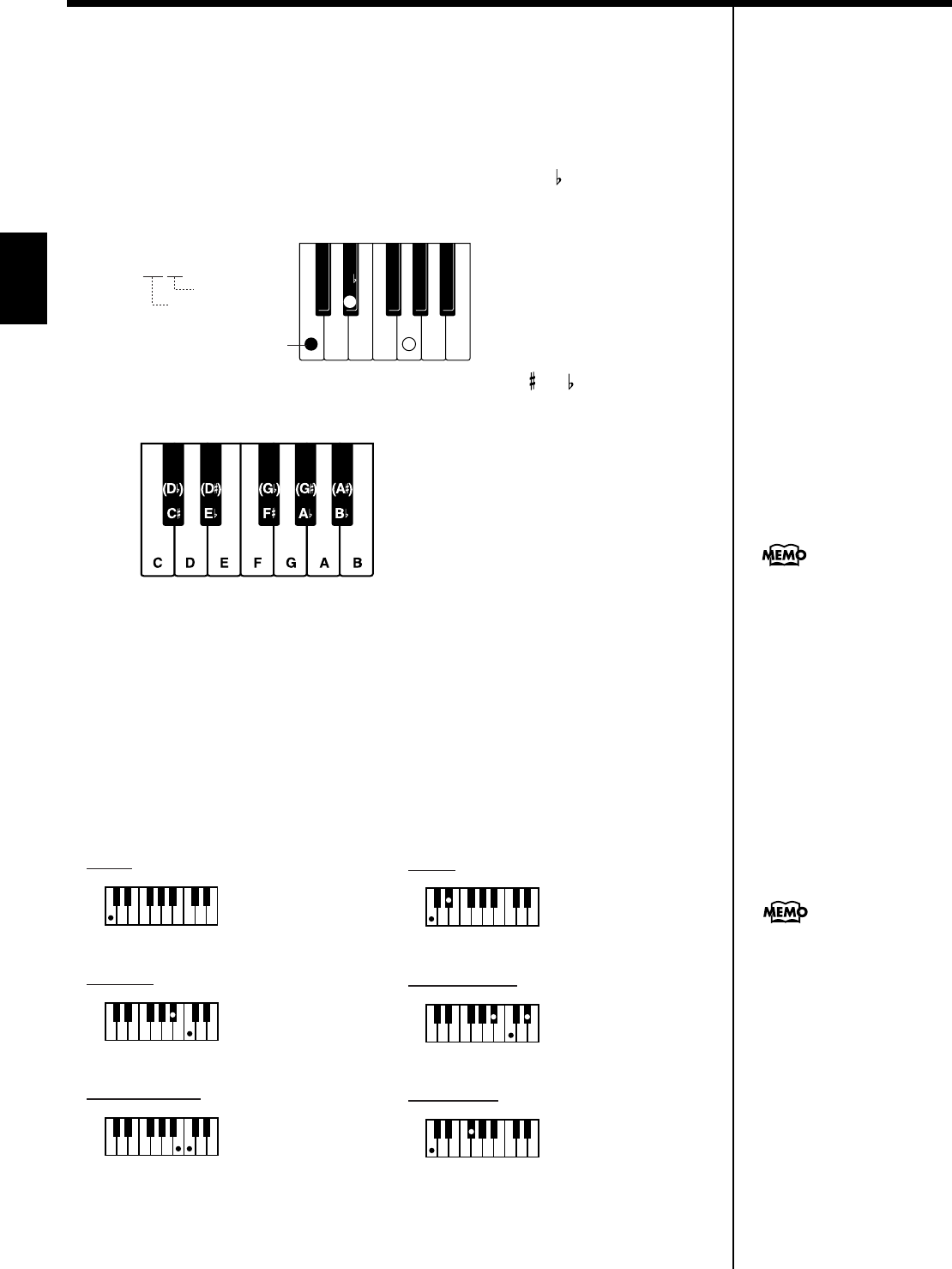
48
Chapter 2 Automatic Accompaniment
Chapter 2
■About Chords
A chord is produced when several notes are played simultaneously. Chords are
indicated by the pitch of the fundamental note of the chord (the root) and the chord
type, which is determined by the other notes of the chord.
For example, the C m chord is expressed in terms of the root note “C” and the chord
type “m” (minor). C m is made up of the three notes “C,” “E ” and “G.”
“C m” is indicated as the chord name on the Basic screen.
fig.chord.e
All chord roots are indicated as a letter, sometimes with or added, and
correspond to the notes shown below.
fig.chord-root.e
■Playing Chords with Simple Fingering
(Chord Intelligence)
“Chord Intelligence” is a feature that chooses the accompaniment chords the
moment you play a key.
To play a “C” chord, for example, you normally have to play the three keys C, E, and
G. But with Chord Intelligence, you only have to press the C key to start a “C” chord
accompaniment.
fig.chord-intel.e
CG
E
C
m
Root Note
Chord Type
Root Note
Normally, settings used for the
Chord Intelligence function are
selected, but there may be
settings that are not used. You
can also change the rules
governing how chords are
played. For more information,
see “Changing How Chords
Are Played and Specified
(Arranger Config)” (p. 138).
C
C maj 7
C 7
C m
C m7
C dim
Ex:
Ex:
Ex: Ex:
Ex:
Ex:
Major
Seventh
Major Seventh
Minor
Minor Seventh
Diminished
Play the chord root.
Play the root and
the second key above it.
Play the root and
the third key above it.
Play the root and
the sixth key above it.
Play the root,
the third key above it, and
the second key below it.
Play the root and
the first key below it.
• Intelligence 1
For more information about
chord fingering, refer to the
“Chord List” (p. 178).
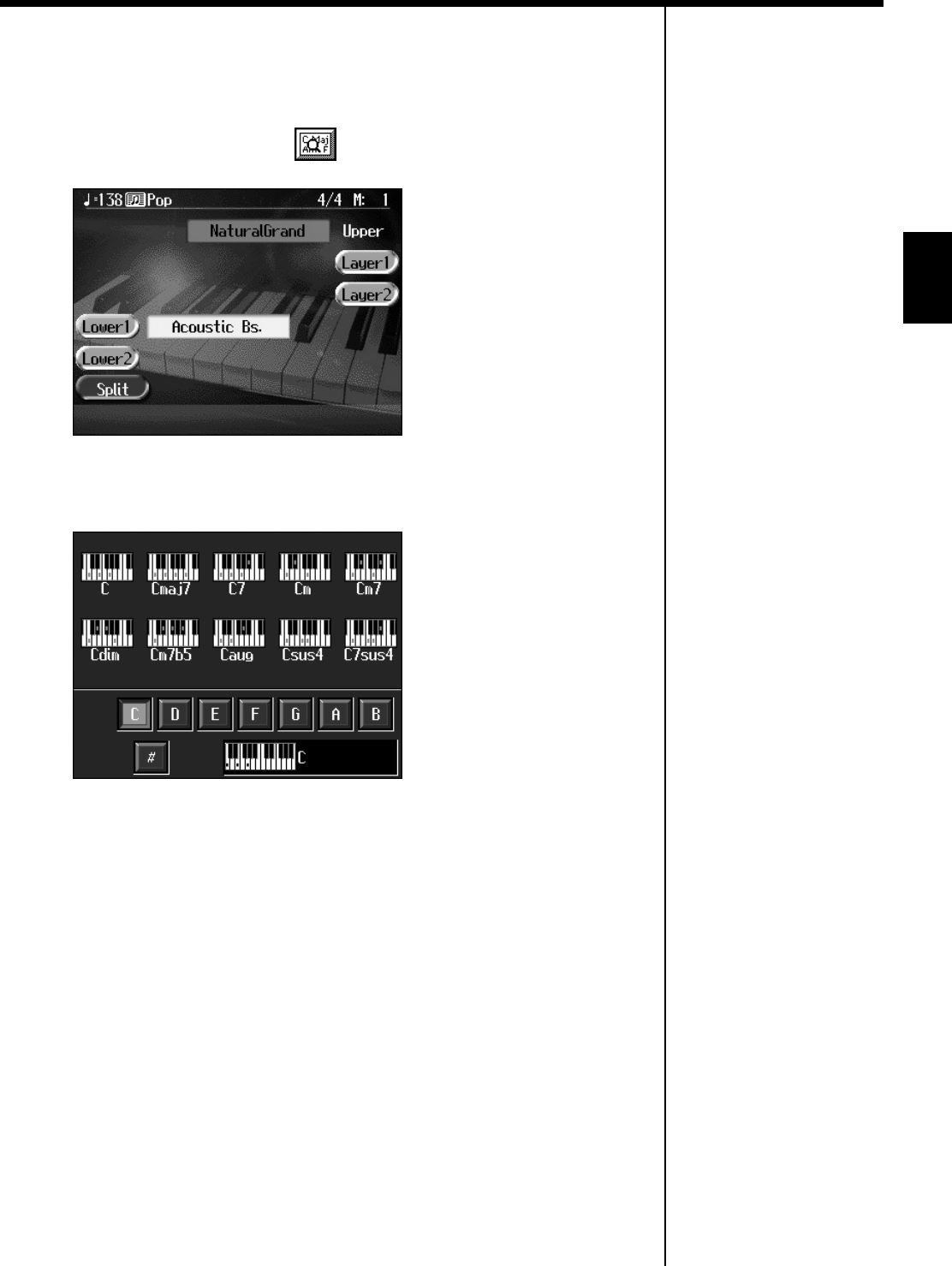
49
Chapter 2 Automatic Accompaniment
Chapter 2
■Viewing Chord Fingerings (Chord Finder)
Whenever you are not sure how a certain chord is fingered, you can display the notes
of the chord on the screen.
1. On the Basic screen, touch < >.
fig.d-arrbasic.eps_60
2. Touch the root of the chord you want to learn about.
The chord fingering appears on screen.
fig.d-crdfind.eps_60
For example, if you wanted to see the fingering for a C# chord, you would touch
<C>, then touch <#>.
Press the [Exit] button to go back to the Basic screen.